Introduction
about the writer
David Maddox
David loves urban spaces and nature. He loves creativity and collaboration. He loves theatre and music. In his life and work he has practiced in all of these as, in various moments, a scientist, a climate change researcher, a land steward, an ecological practitioner, composer, a playwright, a musician, an actor, and a theatre director. David’s dad told him once that he needed a back up plan, something to “fall back on”. So he bought a tuba.
We are all confined to our homes—if we are lucky (more on that later). Which is something, since most of us are “outdoor types”, “people types”.. Can we find meaning, motivation, and renewed spirit for action in this contemplative but deeply strange time? We find ourselves wondering, doubting, planning our next steps or perhaps second-guessing our last ones. We are trying to keep all the parts of lives still stuck together and not flying apart. Good luck with that. Bonne chance. Buena suerte. In bocca al lupo. सौभाग्य. בהצלחה. Boa sorte. Viel Glück. 頑張れ. Buti na lang. حظا طيبا وفقك الله
(Please pardon any clumsy use of Google Translate.)
Now that we have seen how our cities around the world truly function at their most vulnerable, what possible excuse do we now have to not emerge solely committed to fixing it? Maybe in searching for a new post-Covid “normal”, we need to act on the idea that the old normal was a big part of the problem.
So we, as we tend to do, gave a wide variety of people—artists to architects, scientists to planners—the following prompt: How do you imagine you might be changed by Covid, both professionally, but also personally as you negotiate a new post-virus “normal”?
In this prompt we intended to ask a professional question, but also a deeply personal one. All of us now know people personally who have been sick; many (even all?) of us know people who have died. All of us have had lives upended, lost opportunities, had careers and livelihoods set back or even wrecked.
How do we pick up the pieces? What pieces are even still available to us? Which pieces should we cast aside, and leave on the ash heap?
There are a few key threads in this collection of 58 people from 24 countries, and many hopeful responses:
We see (or can simply hear more clearly) more wildlife. Can we hold on to this and build on momentum for and the dream of greener cities for all?
New modes of communication and teaching have a lot of potential, but are also fraught. Meeting in person has real, intangible, and alchemical value. Not all of our students have the desire to learn online, and not all have the resources to do so.
Many of us are slowing down, “smelling the lilacs”, baking more bread, finding new ways to connect to others. Can contemplation and mindfulness be sustained?
Many are amazed at the clean air and reduced consumption. Can a new normal for the fight against climate change and for livability be embedded in our social actions?
Several note that after years of hearing “no you can’t change that”, or “these activities are not optional”, suddenly in a matter of days or weeks we changed fundamental ways of operating. Paraphrasing Diane Pataki below: let’s not take “no” for an answer next time. Or quoting Matt Jensen: “What else is optional” in our lives?
You can read and download here a PDF of all of the short summary statements found in the full texts below.
We are lucky to be sheltering at home. Many beyond this collection have to go to work, brave public transportation. Or have no work at all. David Simon in this collection has two children who are emergency room physicians. (Our gratitude to them.) The New York Times and others reported recently that most new Covid cases are people who are working outside the home, such as in grocery stores. They probably don’t have a choice. Covid’s consequences seem to hit hard communities that already are challenged. For example, 70% of Covid deaths in Louisiana are African American. In Kibera, Dharavi, and other slums of the world, who knows?
We are The Nature of Cities—that is, the character of cities that we believe in: green, certainly, but also a thriving mix of communities, and immigrants, and restaurants, and performing arts, and cultural institutions, and civil society, and innovation, and diversity, and opportunities, and … people. I love cities. I fear for their immediate future and the people who live in them. Let’s remain focused on what we can now see are the fault lines and the possibilities for change in cities. As Mary Rowe says below: “now that we have seen how our cities around the world truly function at their most vulnerable, what possible excuse do we now have to not emerge solely committed to fixing it?”
Maybe in searching for a new post-Covid “normal”, we need to act on the idea that the old normal was a big part of the problem. Both personally and professionally, let’s take nothing for granted.
* * *
The banner image above is a nested necklace, jewelry by Ligia Ceballos de Wiesner, who happens to be the mother of one of our contributors here, Diana Wiesner Ceballos. (Photo by María José Velasco.) To me the piece symbolizes much of what we discuss in this roundtable: the act of nesting in our homes (our nests) during quarantine, the interconnectedness (the intricate tagle of nests) of communities, and the new life and ideas (eggs) nurtured within nests.
Dagmar Haase and Annegret Haase
about the writer
Dagmar Haase
Dagmar Haase is a professor of urban ecology at Humboldt University in Berlin. She is a guest scientist at the Helmholtz Centre for Environmental Research (UFZ) in Leipzig. She specializes in urban systems analysis. Together with her team, she investigates ecosystem services, green infrastructure, and nature-based solutions in cities.
about the writer
Annegret Haase
Dr. Annegret Haase is a senior researcher at Helmholtz Centre for Environmental Research – UFZ in Leipzig, Germany, at the Dept. of Urban and Environmental Sociology. Her research is focused on sustainable urban development, urban transformations and social-environmental processes in cities.
COVID-19 is not just a natural, virus, or health crisis, it is a societal crisis. The response has to be given by the whole humankind. Urban nature, its maintenance, care and fair use, forms an important part of this global response.
An urban ecologist and an urban sociologist sharing under current social isolating measures in Germany one home office and—due to the nature of this matter—are constantly exchanging thoughts, experiences, and perceptions, wish to share the following reflections with a wider community interested in TNOC: Dagmar is convinced that, firstly, we need to rethink what we as urban ecologists mean be “co-evolution” in urban systems. Evolution in wilderness systems—regardless being situated in a city or beyond—has been continuously endangered by humans in a way that it—finally—endangered humans, in cities or beyond, with zoonosis. For cities, this means, sharing a larger habitat together, humans and wildlife need real niches in urban systems where wildlife can develop without disturbance surrounded by buffer zones access of humans and livestock is limited. Refraining from current increasing living space per urban capita, we have to understand that it is the size of the niches for wildlife in and around cities that has to increase first!
We have considerable knowledge about ranges of wildlife and diversities of healthy ecosystems in urban ecology discipline(s): we have to make use of them! Having understood that co-evolution does not always mean co-habitation, we will be able to create healthy cities embedded into a larger landscape that respect wildlife. Another core principle of urban ecology needs revival in relation the aforementioned:
Secondly, we should strictly follow the idea of a real network of open spaces in cities and its peripheries that allow for both human outdoor stays—also in such bad times of a pandemic—as well as safe outdoor life for wild animals. Providing space for a healthy stay outside without crowding effects and respective—when and whatever distancing, also in a non-pandemic sense—is possible in a “fair way” seems mandatory. Thus, we need clear limits for infill and densification in cities. We need space. When spatial resources are understood—at least in parts—as a commons, values like affordable flats and house prizes along with open green and blue spaces for humans and wildlife should be as rewarding as any economic return rate. Full accessibility of green and blue spaces for all would be prerequisites. And—what is important and relates back to the argument above—the human-used open space network does not interfere with the wildlife space. This way, we allow wildlife in and around cities to find space to form stable biocoenosis, including all vectors that belong to, and thus prevent the formation of zoonosis as best as we can. How can we achieve such conditions?
Thirdly, we need a novel thinking about values that guide our “do” and “don’t” imperatives in urban system where wildlife and humans interact and where humans exploit natural resources. Cities always were and will be social-ecological-technological systems (SETs) with a lot of—as we learned during the pandemic—critical infrastructure. Also critical resources like fresh air, green, blue and soil resources for the above mentioned co-habitation of humans and wildlife. To safe both, human life and wild animals life, we will need to shift our values for these resources from a very utilitarian to a more holistic one. From a pure economic and revenue-oriented to a common resource and habitat one. This does not mean that we should totally neglect market and market capitalism. However, we should let a commons thinking accompany the market-orientation and develop a multi-value system adopting the Dépense-system-idea, which involves a rethinking of the organization of society signalled by terms such as limits, care and sustainability.
What does this mean for cities, for urban society, for the interaction of people and nature in cities?
The crisis also sheds light on existing inequalities and injustices of our urban societies—in terms of how people can adapt to and cope with restrictions: It is much easier to stand restrictions in a large flat with balcony, garden or rooftop access and close to green spaces than in a small flat packed with people.
Cities are hotspots of the crisis—since cities are densely populated and form hubs of mobility and interaction, they are especially likely to become also hubs of pandemic crises—as we experience now e.g. in Paris, Madrid, the urban Lombardy, NYC etc. Subsequently, pandemic crises of today and tomorrow will always be primarily urban crises and—at the time—hubs to deal with them. Therefore, it will be crucial to debate how we can make cities more resilient to pandemic crisis. Here, urban nature plays an important role. Under the circumstances of physical distancing and restrictions to meet as we experience them currently worldwide, the contact to urban green and nature, the stay in nature becomes even more important for human physical and mental health than normally. The stay in nature can counteract stress, depression and fears related to “curfew” condition and personal concerns about future, family, job etc.
Being in urban nature also admits contact to other people, even while keeping a physical distance. Insofar, urban nature represents an environment which may actively counteract social distancing, alienation and isolation. Next to parks and open spaces, also allotment gardens or community gardens play an important role as safe places for people allowing for distance and contact, especially also for current high risk groups as elderly people. To use this potential, easy access to urban nature, parks, gardens and other forms of open space for all urban inhabitants is indispensable, as the maintenance of the existing spaces. Here, we are in front of a multiple challenge.
The crisis also sheds light on existing inequalities and injustices of our urban societies—in terms of how people can adapt to and cope with restrictions: It is much easier to stand restrictions in a large flat with balcony, garden or rooftop access and close to green spaces than in a small flat packed with people. No easy access to high quality green space is a clear disadvantage under the conditions of restrictions. Not to speak of social support structures that are closed now and poor people are depending on. As we experience now, the crisis is aggravating existing injustices and runs the risk to lead to even larger injustices in the future; the longer restrictions endure, the larger injustices may become. First evidence in many affected countries shows this already now. To make our urban societies more resilient to pandemic crises, among others, an easy access to high-quality nature represents one crucial precondition, and urban planning and policy-making should consider this.
Putting justice and social responsibility into the centre of urban resilience thinking is thus not just a romantic dream but also a clear demand in the name of sustainability and liveability of our cities. Maybe, the recognition of such requisites belongs to what others call the “progressive or even productive moment” of the crisis or a chance for learning and making other decisions for the long-term future. Since it is not at all whether we experience just a temporary disturbance or a fundamental change of our ways of living, producing, working, travelling and interaction. Even more: The crisis also challenges our conceptual thinking about people-environment relations in cities: resilience, sustainability, health, justice etc. More than ever, there is a need of truly interdisciplinary thinking, and of a thinking that considers a fair co-existence of society and nature, not only, but particularly in cities where they come so close and intensely together. We have to look for cross-fertilizations of the mentioned concepts with terms like fairness, solidarity, weighting and, if needed, renouncement.
We as researchers on TNOC have many new questions to answer: What do urban green spaces mean in times of restrictions? What do restrictions do with visits to and use of urban green spaces? Will people appreciate urban nature differently under the current conditions? Will the crisis allow for a more responsible, wise and even more humble debate on nature and its values and our dependence on it? Will urban green become a considerable part of our resilience towards times with restrictions? And what about our co-habitation with wildlife: How do we ensure mutual respect; live and let live. We need truly interdisciplinary answers to this hyper-complex challenge.
COVID-19 is not just a natural, virus, or health crisis, it is a societal crisis. The response has to be given by the whole humankind. Urban nature, its maintenance, care and fair use, forms an important part of this global response.
Abdallah Tawfic
about the writer
Abdallah Tawfic
Abdallah is an architect, environmentalist and urban farmer. He works at the German International Cooperation (GIZ) and he is also the cofounder of Urban Greens Egypt, a startup aiming to promote the concept of Urban Agriculture in Cairo.
Planting is a representation of peace and hope and we should continue to encourage, support, and spread it in such critical time, for the sake of our health and wellbeing. Let’s be hopeful and revive victory gardens again all over the world, let’s get back to our roots, and grow food and hope inside our cities.
Do you think its the first-time humanity faced a dark cloud? Skimming through history books, mankind has been through serious and tough plights. But I always wondered what keeps us going in the face of any adversity. We as Human Beings are remarkably resilient as a species. We don’t fully understand the science, but we know that the “support of one another” is crucial and is what keeping us strong during such difficult times. The experiences that we are going through nowadays will probably stay in our hearts before our minds for the rest of our lives. COVID-19 should be a lesson to all of us on how to go beyond the norms and routines of our daily “for granted” lives and be more dynamic and resilient inside our cities and within our communities. It should also allow us to have a glimpse through our past, learn and reflect from previous times of distress, and highlight and get inspired by solutions, innovations, and successes that we always refer to in our history books with pride and admiration.
Urban Agriculture’s loyalty through stormy seas of our history. Through history Urban Agriculture has been an effective tool and a supportive friend for lots of cities worldwide, especially during critical times of humanity. Urban Agriculture is nothing new. In fact, it’s been around for as long as humans have lived in cities! Through time, the significance of urban Agriculture has taken on different levels of meaning; from serving as tools for social reform, to promoting environmental justice, and as subsistence in times of food insecurity during wars or pandemics, and even as a simple pastime and leisure in times of prosperity.
During World War I and World War II, most supplies and food were prioritized for the war effort, leaving many at home to deal with scarcity. In order to boost food supplies, many countries promoted “Victory Gardens” or “War gardens”, or gardens cultivated by citizens on private and public land. Besides alleviating the strain on the public food supply, it also was a way to boost morale and patriotism. In the US, President Woodrow Wilson asked Americans to plant Victory Gardens to prevent food shortages. Victory gardens were responsible for about 41% of all consumed vegetable produce in the US in the year 1943 according to some resources 1.
Nowadays Urban agriculture can be crucial to feeding more than half of the world’s population, whom are residing in cities, potentially producing as much as 180 million tons of food a year—or about 10% of the global output of pulses and vegetables, according to a 2018 study published in the journal Earth’s Future 2.
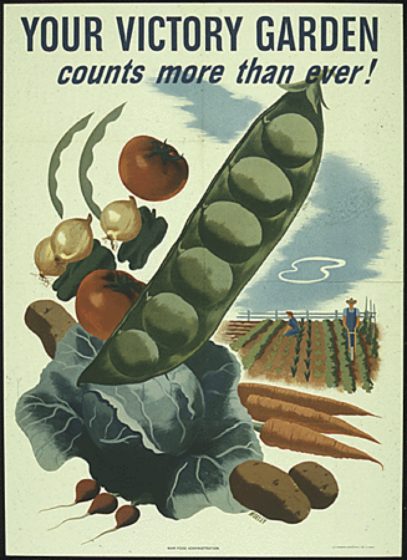
Do we have a potential to grow food during this critical times ? Balconies, gardens, empty lots, and roofs are potential spaces that we can make good use of and start growing different types of productive crops, and decrease stresses happening nowadays on our global food supplies. Panic buying in some countries during this crisis has led to empty supermarket shelves and an uptick in the purchase of seeds, according to media reports. Many urban farms across the world are switching to this kind of community-supported-agriculture model (CSA), which guarantees a weekly supply of produce and may save their recipients trips to crowded supermarkets. The idea can also have a direct impact on our usual visits to busy local markets and thus decrease possible health compromises from social interactions we, unfortunately, aren’t encouraged to do nowadays.
Planting is a representation of peace and hope and we should continue to encourage, support, and spread it in such critical time, for the sake of our health and wellbeing. Let’s be hopeful and revive victory gardens again all over the world, let’s get back to our roots, and grow food and hope inside our cities.
Resources:
1—Anisa Holmes, The Green Conspiracy: https://thegreenconspiracy.com/a-brief-history-of-urban-gardening/
2— “A Global Geospatial Ecosystem Services Estimate of Urban Agriculture” : https://agupubs.onlinelibrary.wiley.com/doi/full/10.1002/2017EF000536%0D
Kevin Lunzalu
about the writer
Kevin Lunzalu
Kevin Lunzalu is a young conservation leader from Nairobi, Kenya. Through his work, Lunzalu strives to strike a balance between environmental conservation and humanity. He strongly believes in the power of innovative youth-led solutions to drive the global sustainability agenda. Kevin is the country coordinator the Kenyan Youth Biodiversity Network.
The COVID-19 curfew has given me the space to reflect on viable alternatives to my common practices: I am rethinking my food, modes of travel, entertainment, and forms of meeting people. Working from home for certain days may prove to be one of the best environmental practices. These ideas will greatly shape my post-crisis personality.
As a coordinator of a national youth network, I anticipate that the pandemic will catalyze several important alterations to our work. We have to reassess, restructure, and re-plan how our grass-root projects, youth workshops, training, and related impact will play out both in the short and long run. In the very least, digitization and automation will be at the core of things. Minimizing human interactions while scaling up our work will mean exploring technological tools that are at our disposal.
Youth capacity-building workshops, campaigns, policy meetings, and related document reviews, and training modules will be largely be conducted online. However, while all these options seem feasible, we cannot be blind to the fact that access to technology and internet solutions is still a challenge in many developing countries, including Kenya, especially at the local level where most conservation work happens.
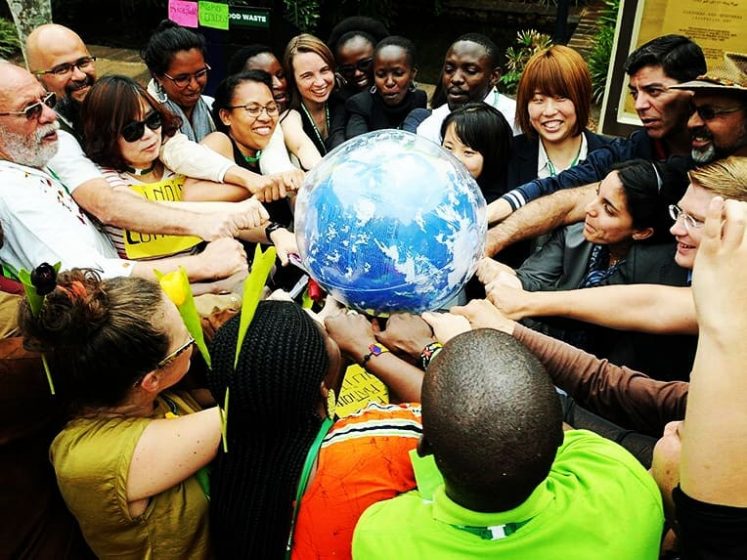 This crisis lays a tangible test on the ability of many organizations in Africa to adapt to the super-changing technological provisions and also embrace circularity. Exploring partnerships beyond our niches to include cloud computing service providers and digital companies is one of the strategies we have to embrace. This is also the time for me to evaluate my professional landscape in terms of what I need to adjust and learn, to grow and attain my personal career goals in the post-crisis era.
This crisis lays a tangible test on the ability of many organizations in Africa to adapt to the super-changing technological provisions and also embrace circularity. Exploring partnerships beyond our niches to include cloud computing service providers and digital companies is one of the strategies we have to embrace. This is also the time for me to evaluate my professional landscape in terms of what I need to adjust and learn, to grow and attain my personal career goals in the post-crisis era.
As a pan-African, I strongly believe in the power of coming together as a community and largely as a society. African Traditional cultural provision are largely based on human interaction. The current crisis provides a challenge to rethink a new “norm” concerning cultural engagements.
In my personal space, I enjoy diverse cuisines, making new friends, meeting people, being entertained, and traveling. The COVID-19 curfew and stay-at-home directives paralyzed transportation, and the closure of entertainment places (including a halt to football matches) have given me the space to reflect on viable alternatives to these practices. For instance, I am rethinking my food consumption patterns, the modes in which I travel, what entertainment options I have, and different forms of meeting people. With reports of pollution levels going down during the pandemic, I am being convinced that working from home for certain days of the week may prove to be one of the best environmental practices as it reduces traffic pollution, office space needed, and use of facilities that may be directly harming our natural world. I have also started appreciating nature found around my home, doing balcony gardens, and generally converting the home space to be greener. Some of these practices will greatly shape my post-crisis personality.
Laura Shillington
about the writer
Laura Shillington
Laura Shillington is faculty in the Department of Geoscience and the Social Science Methods Programme at John Abbott College (Montréal). She is also a Research Associate at the Loyola Sustainability Research Centre, Concordia University (Montréal).
“It’s the end of the world as we know it and I feel fine” — REM, 1987, Document
While we may be sharing a global experience of living in a pandemic, how we experience it is very specific to place, age, class, race, and gender. Can we use this experience to create a new normal with each of us as more ethical subjects to imagine new worlds?
As I re-read, I was reminded how insightful, instructive and inspiring the books were and still are. There are two broad ideas that can help us transition into thinking in radically new ways as we negotiate a new post-virus normal. The first is that we already live in a world of diverse economies. Despite the taken-for-granted assumption that we are a globalized, capitalist economy, and that this economy was the pinnacle of so-called development. Yet there have always existed other economies, but such economies tend to be viewed as not important, stuck in the past, and a threat to profits. Without diverse economies, what we know as capitalism would not have emerged and functioned. In the current pandemic, we are seeing the importance of these other economies, especially the care economy. Other economics, especially economies of care, have greater potential to bring about not just social justice, but also ecological. Recognising the important of other economies will (hopefully) lead us to “ethical practices of thinking economy and becoming different kinds of economic beings” (2006, p. xxviii).
Gibson-Graham’s second main idea is the importance of collective action and the politics of the subject (2006, p. 127). They ask and attempt to answer: “How we might become post-capitalist subjects?” We can add to this how we are different post-pandemic subjects. The politics of the subject for Gibson-Graham is a complex, not-so-neat process of “resubjectivation” – “the mobilization and transformation of desires, the cultivation of capacities, and the making of new identifications with something as vague and unspecified as a ‘community economy’ ” (2006, p. xxxvi). The process is reciprocal: as we change ourselves as subjects, we also change our worlds.
Indeed, there is a reciprocity in the current global pandemic. It is changing us as subjects (individual and collective) as well as changing our worlds. While we may be sharing a global experience of living in a pandemic, how we experience it is very specific to place, age, class, race, and gender. Can we use this experience to create a new normal with each of us as more ethical subjects to imagine new worlds?
“It takes a world to create a locality, and an imagined world to transform ourselves in place” (2006, p. 196)
Siobhán McQuaid
about the writer
Siobhán McQuaid
Siobhan is the Associate Director of Innovation at the Centre for Social Innovation in Trinity College Dublin where she heads up research and innovation activities under the themes of sustainability and resilience.
We are facing now into a pivotal moment in time where it is possible to contemplate an alternative recovery plan. Governments and decision-makers need to take time out to reflect on the importance of small business, local business, and nature-based business for community resilience.
Over the last five years, I’ve had the privilege of working with some innovative companies who are passionate about bringing more nature into cities —sometimes they’re community enterprises designing and developing “growing” projects to meet the needs of vulnerable groups. Other times they’re commercial entities who have leveraged their horticultural knowledge to create new innovations like green living rooms. Such interventions can instantly transform concrete squares into urban oases, enticing children with little exposure to nature to engage, happily picking strawberries from green walls. More recently, I’ve met start-ups harnessing satellite technology to come up with so-called “green-prints” to help cities plan, monitor, and benchmark greener, healthier and happier urban environments.
In February this year, Connecting Nature, an EU-funded initiative, launched a survey to explore more widely the concept of nature and business. What type of business can nature support? How can business support nature and society? Just as Europe began to shut down country by country, we reached our first goal of 100 survey responses. A preliminary analysis shows that nature-based enterprises offer considerable potential in a post-COVID environment—not just to create much-needed jobs but equally importantly at a social and environmental level. Nature-based enterprises offer sustainable solutions to transform grey spaces into green lungs for cities, lifelines for apartment-dwellers, for homeless gym-bunnies, for communities as a whole, for nature.
This month we launch a mini-follow up survey to find out how these businesses have been affected by COVID-19. Anecdotally we have seen a wide divergence in impact. Any kind of food-growing business has seen interest skyrocket; the more local and natural the produce, the more insanely busy they have become. On the other hand, nature-based businesses depending on the construction or public sector have virtually closed down overnight, with tons of plants wilting on pallets waiting for on-site construction which has effectively been put on hold.
With plans afoot for the gradual re-opening of society, what will a post-COVID world look like for these nature-based businesses? Faced with mounting pressure, will the public sector, business, and construction sector put nature on the long finger again? Will governments roll out short-term economic stimulus packages focusing on a return to “business as usual” as quickly as possible? Will workers return in their hoards to city-centre offices on packed commutes? Or will government and businesses seize this opportunity to reflect and consider the situation we were in before this crisis—where “business as usual” led to unsustainable economic cycles contributing to climate change and biodiversity devastation in another type of emergency.
We are facing now into a pivotal moment in time where it is possible to contemplate an alternative recovery plan. Governments and decision-makers need to take time out to reflect on the importance of small business, local business, and nature-based business for community resilience. Business leaders need to consider the proven benefits of bringing nature into work environments or even better the possibility of creating new working environments in commune with nature. We have the opportunity to incubate a new business sector, to stimulate the start-up of new nature-based enterprises and support the re-emergence and growth of existing nature-based businesses. Can each of us make the case in our own community for investment in a different type of business, nature-based businesses that contribute to resilience, community connectivity, and that most crucial element we have all come to appreciate—quality of life?
(Note: The Connecting Nature survey of nature-based enterprises is open to enterprises globally. We welcome your insights on the impacts of COVID-19 and future opportunities for this sector. Click here for more information.)
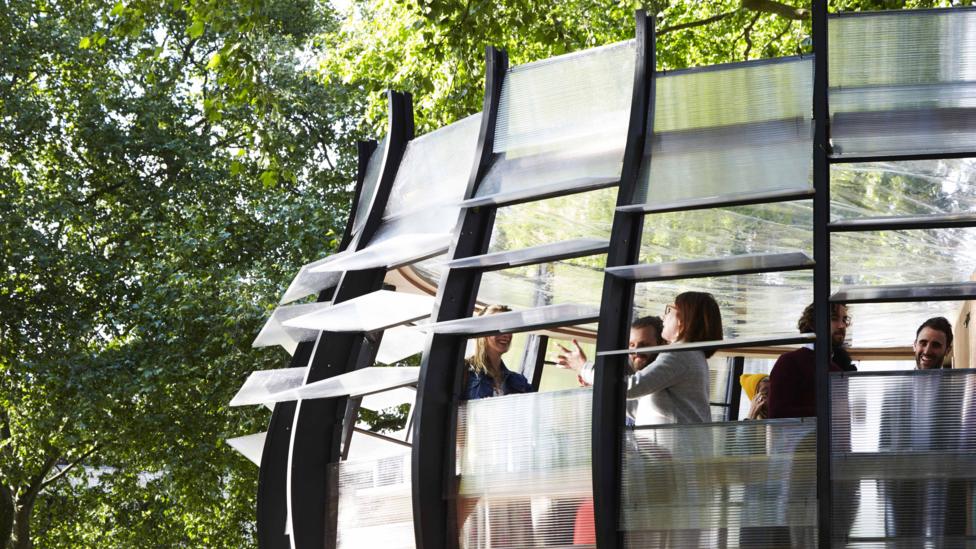
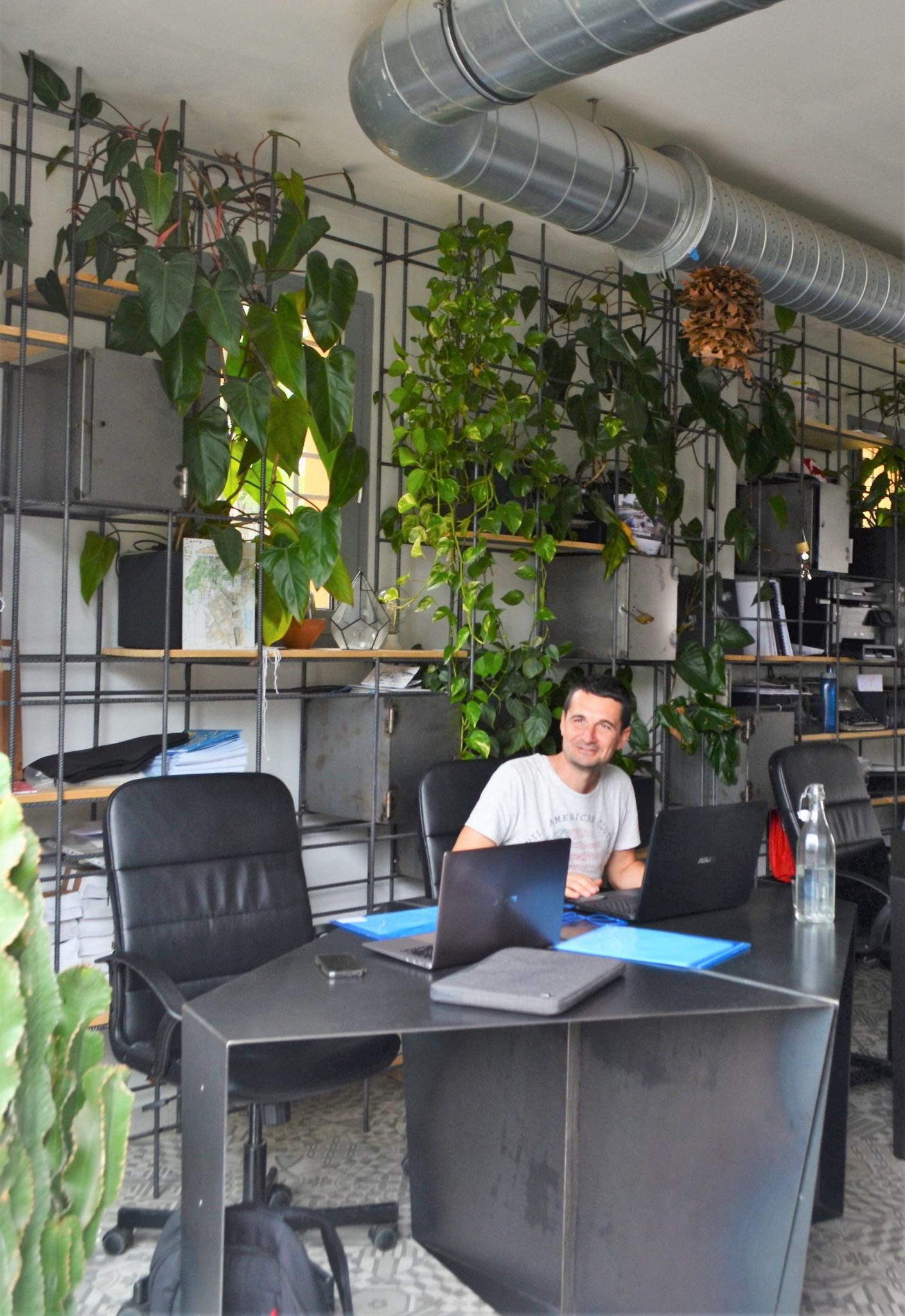
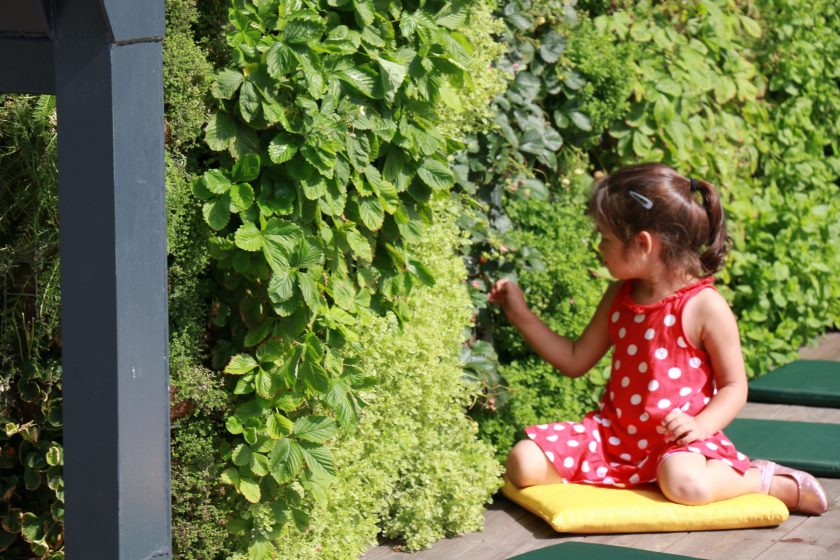
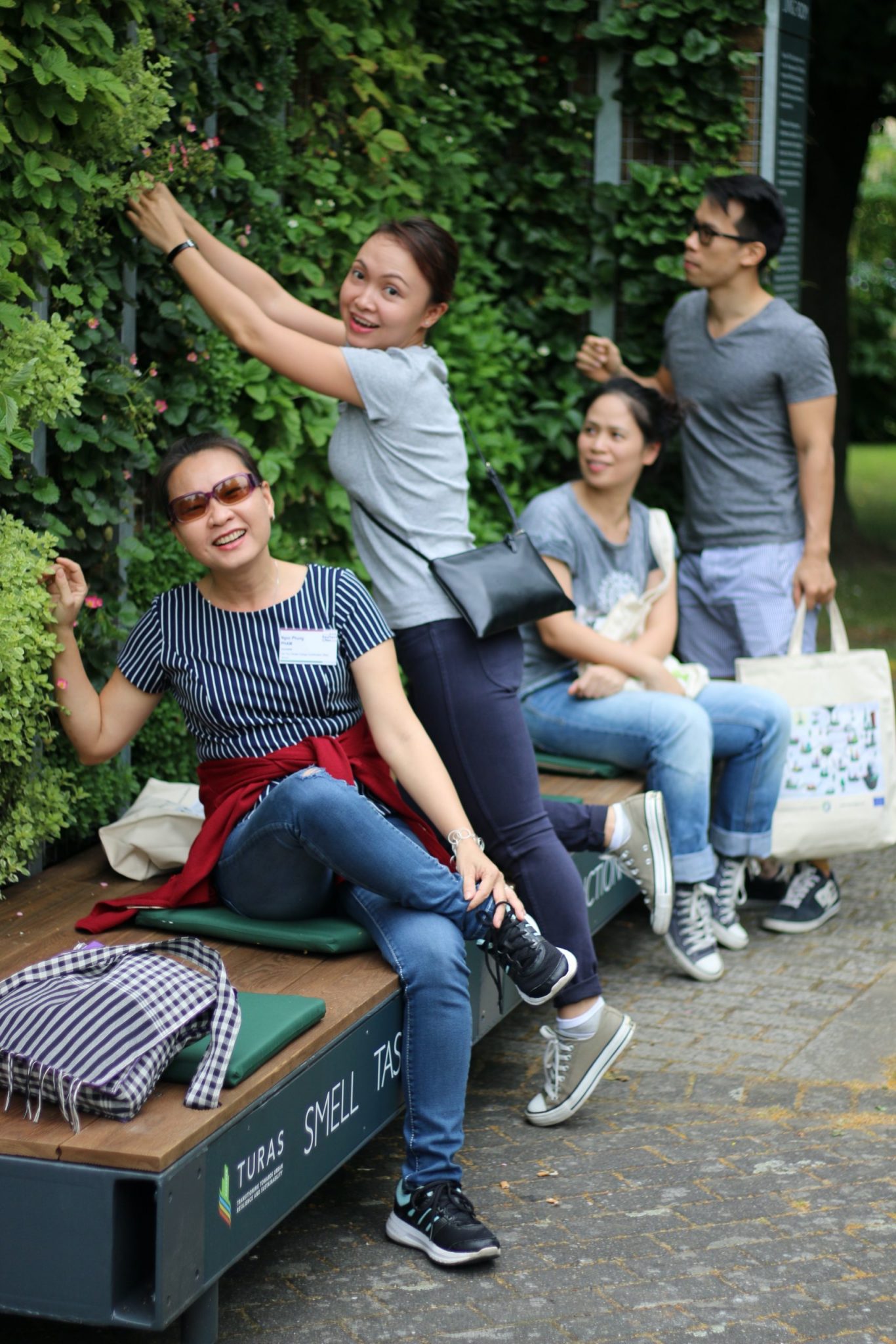
Diane Pataki
about the writer
Diane Pataki
Diane Pataki is a Professor of Biological Sciences, an Adjunct Professor of City & Metropolitan Planning, and Associate Vice President for Research at the University of Utah. She studies the role of urban landscaping and forestry in the socioecology of cities.]
What about poverty, inequality, food insecurity, lack of access to clean water, climate change, and pollution? Now that I know we can act in response to COVID-19, there’s no turning back. Our society can change – completely and rapidly. The next time we have a daring solution, let’s not take “no” for an answer.
I no longer find this argument valid. In the past few weeks, we’ve seen massive changes to almost every element of our society, implemented at unprecedented speed. We shut down businesses, sent workers and school children online, closed streets to cars, and changed social norms about what to wear. For my entire career as an academic, I was told that universities were slow to change and would take years to fully embrace online education. Yet, virtually every campus in the United States transitioned to online teaching in a matter of weeks, sometimes days. Professionally, most of us kept up air travel to meetings that could have easily been held online, even though we knew we shouldn’t. We didn’t want to change—until suddenly we did.
All of this happened under massive uncertainty: we still don’t know how many COVID cases there really are, whether the virus will persist through the summer, whether anyone really has immunity even after they’ve recovered, and how long it will take to develop a vaccine—if ever. And yet still, we acted. We acted because lives were at risk, or because it was the right thing to do, or because we were afraid, or because we were compelled, or because the risk of not acting seemed greater than the risk of change.
This is not to say that the societal changes we’ve seen so far have been positive. Many have been devastating. In New York City, where I grew up and where my family still lives, the changes are heartbreaking. In the New York borough of Queens, a global epicenter of COVID-19, my elderly family members no longer step outside. Every two weeks my brother dons protective gear and visits several grocery stores to find enough food for all of them, quietly delivering their groceries without saying a word or going inside. Family friends became infected, and one died when the hospitals refused admission for three days in a row because the ICUs were full.
The human toll has been horrific, and many governments were, in fact, too slow to respond given the circumstances. Yet still, I’ve seen more wide-reaching government and societal action in the last two months than in my entire life. When lives are threatened, we can change the way we do things to a phenomenal extent.
So what about the other ways that lives and wellbeing are threatened in cities? What about poverty, inequality, food insecurity, lack of access to clean water, climate change, and pollution? Now that I know we can act in response to COVID-19, there’s no turning back. Our society can change – completely and rapidly. We transformed when it was necessary and we can do it again. Radical changes are possible, and urgent. The next time we have a daring solution, let’s not take “no” for an answer.
Alex Herzog
about the writer
Alex Herzog
In 2000, Alex opened a restaurant at Rio Design Barra shopping mall, where he then established the IN HOUSE Café-Bistrô. He developed his passion for food and cooking with his grandmother, who was a great Belgian cook. When he was a kid, used to he spend hours and hours in the kitchen helping and learning with her.
I believe there will be a strong enhancement of circular economy, increasing the value of local, its people and its businesses. Consequently, waste will decrease, and much of what before was seen as such, will begin to be reused. In other words, a syntropy in restauration.
As Chef at a bistro in Rio de Janeiro, I try to imagine how the new “normal” will be, when restaurants finally get “discharged” from quarantine. How many will survive Covid, and reopen their doors? I believe that the ones that resist, will need resilience and high adaptation skills, in order to see a new way of making business emerge. I compare this crisis, to a drastic prune done to protect the whole tree. You cut branches, leaves, everything that seems like too much, and then, when the foliage sprouts, it’s an explosion of nature. I presume the same will happen with restaurants. Why? Well, people will have been confined for weeks, if not months, no going out, no visiting family, friends or coworkers.
At some point, everyone had to begin cooking for themselves. People will have, more than ever, the desire to go out, have fun, see friends, see the ones they like. One simple hug, will gain a never before seen proportion. For centuries, restaurants have been one of the best places to connect with one another. Parisian establishments such as Le Procope, founded in 1686, or “Bouillons”, that served soup for workers, so they could be “restored” (originating the name “restaurant”), are proof of all of that. These establishments have in their DNA: time for leisure, social gatherings, happiness, reunions, and of course many hugs.
Many will have to adapt to people’s fear and also to the new paradigm expected to rise following the crisis. Worries about hygiene and agglomerations, will reveal that people are going to prefer eating in open spaces. Cities and neighborhoods will have to adapt. Clients will be more educated and will stop taking for granted all the hard work that goes on behind the scenes in a restaurant. Local products will gain value. Inputs, with high ecological footprints, will become expensive.
Costs in the kitchens will have to be cut, preventing food waste. At the top of the list of many establishments, will be actions, such as donating “doggie bags”, to people in vulnerable situations. Following the same community-oriented actions, people will start to think more in a collective sense, engaging more with their community. People will end up living closer to their workplaces, decreasing the need to commute. We will have “smaller” cities, and in that sense, parks, gardens, public spaces will have to be re-conceived. Nature will be more appreciated. Restaurant outings will tend to stay within the same neighborhood, strengthening local businesses. And as they rise, chefs will have to review and rethink the ingredients used in their menu, begin to buy from local producers, and ultimately turn up their creativity in making dishes. There will be a change in the way people consume. They will stop buying just for sake of buying. Exotic inputs won’t be as interesting as before, as they will be hard to get and prices will high. Comfort meals will be more appreciated, bringing lost wellness during quarantine period.
Many businesses will increase their revenues through delivery. There will be a considerable investment in this area, once people will remain worried about a new pandemic wave. Delivery and frozen foods will have an important role in restaurant sales, as they will be the solution to keep them up well and running, even as new viruses appear.
Recapping, I believe there will be a strong enhancement of circular economy, increasing the value of local, its people and its businesses. Consequently, waste will decrease, and much of what before was seen as such, will begin to be reused. In other words, a syntropy in restauration.
{Syntropy: Is an integrated system within itself and in balance, where all the energy produced is consumed within its own system, without losses.}
Fadi Hamdan
about the writer
Fadi Hamdan
Fadi has more than 25 years of international experience in analysing the interaction between development, urbanism, disaster risk, climate change, conflict, and state fragility. Fadi cooperates with various companies, cities, and countries to protect people, assets, and the environment
What we need is a value change in order to effect a paradigm shift in the way we produce, consume and live as societies.
Concurrently, economically and politically, globalisation is also a game changer. Politically, it has undermined the democratic process in several democratic countries as people voting for certain welfare policies are told that big capital will leave if such policies are funded through additional taxation. It has also removed the bargaining power of organised labour in these countries by shifting production to other hemispheres of the earth. On the other hand, in third world countries it has helped people connect together, to lobby and mobilise for effecting change. Economically, it has led to just-in-time supply chain economics, thereby eliminating redundancy for the case of efficiency—and often at the expense of the environment.
The result is a world which is more connected than ever before, more populated than ever before, and where risks are more difficult to understand and more uncertain to predict. We now see systemic risks across connected social, environmental, and economic systems, interlinked at the global spatial level, with implications for the immediate, decadal and longer timelines. We can now talk about systemic failures which will take place if these systemic risks are not addressed.
What Covid-19 did was to move the above scenario from the realm of risk specialist to make it a reality for every citizen on our planet. While this forces us all to recognise and try to deal with uncertainty, it also provides an opportunity for us to mobilise in order to effect change. The old adage that humans prefer short term interests to long term risks is no longer applicable, as the risks of our economic, social, urban and environmental practices have finally caught up with us. This reinforces my belief that the political is the professional which is now the personal, more than ever. In all aspects of our lives, we must strive to effect positive change towards more inclusive and democratic societies that respects the environment and all creatures in it. This should be the post virus “normal”.
Andreas Weber
about the writer
Andreas Weber
Dr. Andreas Weber is a German academic, scholar and writer who holds degrees in Marine Biology and Cultural Studies. Andreas explores new understandings of life-as-meaning or ‘biopoetics’ and ‘biosemiotics’ in science and in the arts, and has authored 15 books.
I wonder what we will make of the insight that we are suddenly so vulnerable. I watch the glittering insects in the sun, much less numerous than some years ago behind this same window, and listen to the nightingale that plucks those insects from the twigs to feed their young. I sit in silence, until the first bat is out and shatters the pale sky with its ragged path.
Every couple of minutes a commuter train passes. I see a few people inside, widely dispersed, wearing face masks. After the train is gone, bird voices fill the silence. In the past, which ended a month and a half ago, this would have been a noisy work day afternoon in Berlin. Now there is stillness, and the quiet signs of all those which are not human.
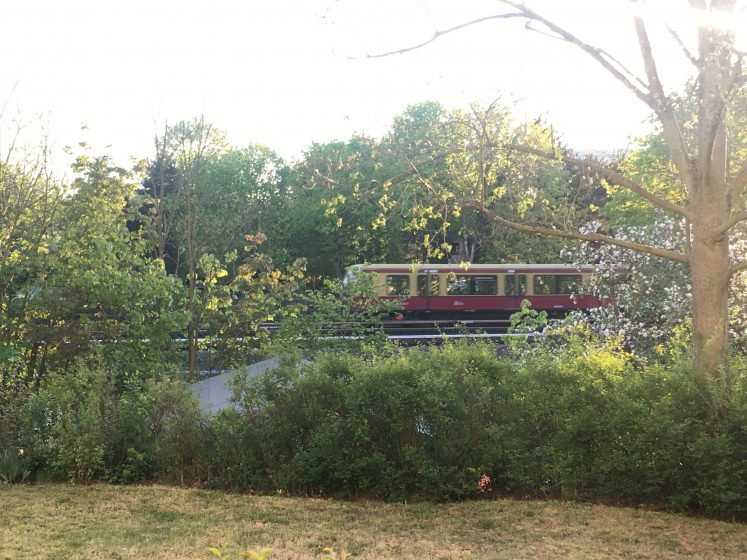 Last summer I taught a seminar about “Collapse”. The summer had started like this, with a series of flamboyant and beautifully sunny days, for weeks in a row, without one drop of rain. I showed a movie from the early 2000s, “Children of Men”, by Alfonso Cuarón. The plot was set in a future about two decades on from the release date. Everything was pretty much the same, apart from the fact that no children were being born.
Last summer I taught a seminar about “Collapse”. The summer had started like this, with a series of flamboyant and beautifully sunny days, for weeks in a row, without one drop of rain. I showed a movie from the early 2000s, “Children of Men”, by Alfonso Cuarón. The plot was set in a future about two decades on from the release date. Everything was pretty much the same, apart from the fact that no children were being born.
I retained the picture of a society trying to function in its usual incomplete way, while there was something deeply, profoundly off. It seemed invisible at first, but then you understood that the balance between birth and dying had invisibly shifted towards death. It felt like a grief over something immensely bad that could not be undone, like having killed somebody, or having lost a child. The birds sang, the sun poured its light into the evening, and somehow there was grief, and horror, and would not go away. We will live with the virus for some time to come. It is a strange plague that hits hard in some places, and is near to nonexistent in others, that seems to be terribly present and apathically absent at the same time. I sit at home and write and avoid the S-Bahn and the city, and the sun is warm, and something feels just slightly off, and unconsolably so.
We will live with the virus for some time to come. It is a strange plague that hits hard in some places, and is near to nonexistent in others, that seems to be terribly present and apathically absent at the same time. I sit at home and write and avoid the S-Bahn and the city, and the sun is warm, and something feels just slightly off, and unconsolably so.
I have been asking myself how much I will miss the clean air stirrend by the shining insects’ wings and the sweet waves of birdsong, when Corona will be behind us. But in truth I doubt that we can plan for a time after. I watch the apple blossoms shiver in the sun, and I wonder that what awaits us, what has actually begun, is the time with corona.
It is a time where something is slightly off, and everything is changed, although we will be trying hard to pretend that we are going on with our business. It is a time when life has become radically cheaper. It’s a time where I won’t know if my next speaking gig, or the dinner with my son and his friends, will turn out to be life-threatening, for me, or for others.
I wonder what we will make of the insight that we are suddenly so vulnerable. I watch the glittering insects in the sun, much less numerous than some years ago behind this same window, and listen to the nightingale that plucks those insects from the twigs to feed their young. I sit in silence, until the first bat is out and shatters the pale sky with its ragged path.
François Mancebo
about the writer
Francois Mancebo
François Mancebo, PhD, Director of the IRCS and IATEUR, is professor of urban planning and sustainability at Reims University. He lives in Paris.
Well hidden behind any disaster, there always is a cost-benefits analysis that went wrong. Yet, more than often those who decide on the acceptability of a risk are not those who will be most exposed once the disaster happens. For the future, it is crucial to decide now who and what actions should be priority in the aftermath of Covid-19, and by whom these choices should be made.
Covid-19 is not the reason why all activity stopped in the world. The ultimate reason is fear: anticipation of a disaster amplified by social networks. The situation reminds me of two quotes from Montaigne, a French Renaissance philosopher too little-known in English speaking countries and a very good reading during containment: “There is no passion so contagious as that of fear” and “A man is not hurt so much by what happens, as by his opinion of what happens”. Well, putting aside collective fear what is actually happening with this virus.
Covid-19 did not go viral by itself. Hyper-mobile human beings did the job. Covid-19 is not a serial killer. Human failures in most countries concerning warning and early response procedures turned it into a serial killer. There is nothing natural about pandemics. They depend on how humans deal with their living environment and what risks they are willing to take by adopting such-or-such urbanization pattern or ways of living. For example, choosing to promote hyperconnected global cities —Wuhan, New York, Paris, etc.— that generate massive flows of people and goods is a pretty risky option as far as pandemics and other disasters are concerned. Well hidden behind any disaster, there always is a cost-benefits analysis that went wrong.
Yet, more than often those who decide on the acceptability of a risk are not those who will be most exposed once the disaster happens. To prevent a similar situation in the aftermath of the pandemic, it is crucial to decide now who and what actions should be priority in the aftermath of Covid-19, and by whom these choices should be made. And it won’t be easy to decide upon these priorities, since we are dealing here with what can typically be considered wicked problems, namely problems which involve dealing simultaneously with a sizeable number of factors which are interrelated into an organic whole, neither rational, nor completely chaotic. A wicked problem never entails a single answer. There always are many, which differ according to how the person or the group who proposes an answer perceive his environment and his best interests. All are equally valid, but usually result in conflicting solutions. There is no magic bullet here. Always keep in mind that after the crisis, everything could very well start over it was before, but even worse!
When the containment period began and millions of French urbanites discretely fled with their friends to the countryside, what does this tell us about the domination exerted by urban centers on rural areas? When—at the same moment—millions of others flew to distant sunny countries to escape the pandemic and get some extra vacation, and when the virus finally arrived in the “paradise” where they were staying—an easily predictable situation—rushed to the airports and embassies asking to be repatriated for free, what does this tell us about the human nature and the colonial type consumer relation people in developed countries have with the rest of the world and with their own country? Right now, it is the evening in Paris. I am looking out the window: very few lights in the apartments, most people walked off.
Huda Shaka
about the writer
Huda Shaka
Huda’s experience and training combine urban planning, sustainable development and public health. She is a chartered town planner (MRTPI) and a chartered environmentalist (CEnv) with over 15 years’ experience focused on visionary master plans and city plans across the Arabian Gulf. She is passionate about influencing Arab cities towards sustainable development.
I have been reminded of the privileges I have which others do not: having the option to work remotely, having access to quality public space and amenities at my door step, having a choice about how I travel and where I spend my leisure time—and having leisure time. I will work harder personally and professionally to bring those privileges to others, I hope.
I am hopeful that my work will look at the planning and design of housing and public spaces differently. I am hopeful that developers and local authorities will be more interested in minimum standards that provide acceptable and accessible outdoor and indoor spaces for all. I am hoping that there will be more interest in promoting “complete communities” where basic amenities are provided within walking distance. I am hoping that there will be renewed interest in facilitating active travel, and in ensuring that our streets and policies are flexible enough to accommodate people’s needs and lifestyles.
As for how I do my work, COVID-19 has highlighted to me the importance of face-to-face office interactions. No amount of video calls can replace unplanned, informal chats with colleagues and clients or over-hearing project discussions happening in the background. At the same time, I realized how many of our planned, formal meetings can occur virtually, and maybe even more successfully. For one thing, it’s easier for me to keep quiet and focus on listening when there is a mute button!
On a personal level, the pandemic has helped me realise my fragility and dependency on others, particularly for my mental wellbeing. I hope that my post-COVID “normal” will include being more accepting of my limitations and weaknesses, and more open to reaching out to others. I expect that I will be more aware of my level of anxiety and better able to manage it. I will no longer expect certainty.
I have been reminded what it means to have three meals a day with family, and I hope to have more of those days even after I go back to working from the office. I have also been reminded of the privileges I have which others do not: having the option to work remotely, having access to quality public space and amenities at my door step, having a choice about how I travel and where I spend my leisure time, and having leisure time. I will work harder personally and professionally to bring those privileges to others, I hope.
Emilio Fantin
about the writer
Emilio Fantin
Emilio Fantin is an artist working in Italy on multidisciplinary research. He teaches at the Politecnico, Architecture, University of Milan, and acts as coordinator of the “Osservatorio Public Art”.
Talking about coronavirus, egoism needs to be switched into solidarity and sharing, but this cannot be done as a reaction to contagion fear or daily body count. It has to be the result of a long path towards the achievement of a new existential consciousness.
Talking about coronavirus, egoism needs to be switched into solidarity and sharing, but this cannot be done as a reaction to contagion fear or daily body count. It has to be the result of a long path towards the achievement of a new existential consciousness.
Many reflections and essays deal about the relationship between chemical and electromagnetic pollution and coronavirus. Some others speculate on how to reinforce our immunity system, but all conclusions bring to the same result: respect humans and not humans, love nature, take care of the environment, be sympathetic.
That’s why the new urbanism has to be thought as a care for the environment. The design of the city has to switch from a logistic and pragmatic vision to the consideration of those aspects which balance broken down rhythms and neurotic habits of city life. Time and space cannot be seen only in term of mobility and economic value, but we need to consider both in term of preserving human health end preventing possible diseases (I am not talking only about virus, but also about neurotic behavior and poisoning). We have to start such a process from below, reducing the number of our cars, limiting the use of our smart technologies, asking for new cycle lines, walking in our cities. The immunity system of the city will improve its force which depends on its inhabitants’ behavior. To fund healthcare doesn’t only mean to build more hospitals and provide new technologies. This approach comes from considering the view point of the “effects”. What should be done is taking into account also the “causes” (which mean low life quality). Rather than using the term urbanism we might find a more appropriate word in order of re-thinking the city as a living organism. If we don’t want this organism to get sick, we should ask politics to limit private interests in the building industry, to avoid the abuse of power into water business and not to break the balance between natural and artificial elements inside the city.
It looks simple, but it is extremely complex. Why? Because of profit, private interests, economic strategies, political conveniences? Yes of course, but it is also a matter of our action, in term of considering ourselves as a part of a “city organism”, by feeling its skin, heart and brain.
A city like a human body and soul.
Rob McDonald
about the writer
Rob McDonald
Dr. Robert McDonald is Lead Scientist for the Global Cities program at The Nature Conservancy. He researches the impact and dependences of cities on the natural world, and help direct the science behind much of the Conservancy’s urban conservation work.
I have often been someone who threw himself at work, who saw work as not just a job but as a calling, who perhaps spent too much time working and not enough time at home. So, it is humbling to realize that, at this moment in time, perhaps the most important thing I can do in the universe is be with my family.
A pandemic like this has a way of clarifying what is important, and what is not truly important, in one’s personal life. I am on day 39 of self-quarantining with my family in our little apartment in Washington, DC. It has been an intense event, for all the usual cliched reasons but also for more spiritual ones. I could make jokes about the challenges of home-schooling two kids while two spouses do Zoom calls to people in all time zones around the world, etc. But those jokes seem already fully played out in popular culture, and don’t capture what I find novel about the experience.
Rather unexpectedly, I have found all this time at home with my family to be a spiritually clarifying moment. It has given me an increased appreciation of the power of family in a time such as this. I have often been someone who threw himself at work, who saw work as not just a job but as a calling, who perhaps spent too much time working and not enough time at home. So, it is humbling to realize that, at this moment in time, perhaps the most important thing I can do in the universe is be with my family. We are lucky to all be healthy, and for both my spouse and I to have jobs that allow us to work at home, so I don’t mean to imply that it was a particularly hard lot for me. Rather, just that I have realized the work of teaching my kids and psychologically connecting with my family, of helping us survive and thrive mentally as a family, was more important than any of my official work as an urban ecologist.
Professionally, this pandemic has brought some big changes for me. The Nature Conservancy, like many non-profits around the world, will have its budget significantly impacted by the economic crisis we are in. This will lead to significant changes in how our urban work is structured, which we are still working through as an organization. Moreover, it seems clear to me that the “traditional” agenda of urban conservationists, of pushing for nature-based solutions in cities for the ecosystem services they provide, for resilience and human well-being, may not be enough. There are hard questions being asked within the conservation movement right now. What is the value of nature during a pandemic? Does nature matter in cities post-coronavirus? Is there even a future for cities post-coronavirus, and if so, what is it? How can we talk about the links between nature and health, which are real and significant, without seeming trite compared with the enormity of the health impact of this pandemic? While we are beginning to find some answers to these questions, they will take months or years for the conservation movement to fully ponder. I truly don’t know yet how much our movement will change, or how.
Marcus Collier
about the writer
Marcus Collier
Marcus is a sustainability scientist and his research covers a wide range of human-environment interconnectivity, environmental risk and resilience, transdisciplinary methodologies and novel ecosystems.
“The Chinese use two brush strokes to write the word “crisis”; one brush stroke stands for danger, the other for opportunity. In a crisis, be aware of the danger—but recognize the opportunity.” John F. Kennedy, April, 1959
I have a new resolve to overcome my despondency and try harder to find a means to engage urban communities with wild nature. In this case, the first step is literally on the doorstep!
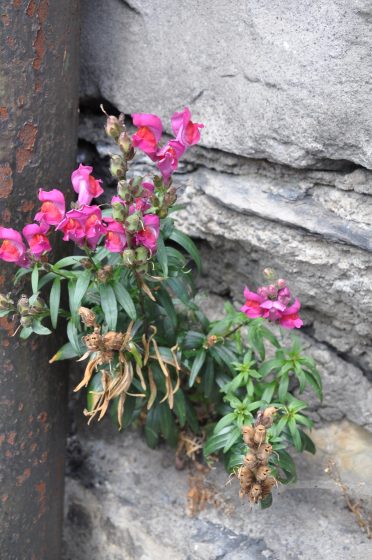
However, during the COVID lockdown period I have noticed a significant increase on observations of nature in cities with a plethora of new websites, social medial feeds, and mainstream media observations of nature in cities. The absence of large numbers of people and vehicular traffic is permitting many animals to be brazen; unashamedly wandering through what were once busy streets. It should be said here that it is not the case that there are more animals or more bird song, however, it is the case that we are better able to observe them now that the noisy, chaotic background of human activity has been removed and we are forced to “stop and smell the roses”. I love that people are posting their observations, some of them for the first time, and this will make my job a lot easier when I am trying to convey the diversity and resilience of species in urban environments. What is even more exciting is that urban ecologists are being provided, free of charge, with a growing data resource complete with images and geolocations. We are being given a snapshot of what cities could be like when nature is permitted to do its own thing, and thus we have more opportunities for generating theory and measuring urban ecological processes and characteristics. Indeed, this data resource could be an opportunity, in combination with data from transport, air, and water quality, and so on, for convincing urban communities, planners, and policy-makers of the values of adopting urban regreening strategies. Moreover, this is possibly our best opportunity to definitively prove to our fellow humans that by changing our behaviour we can have greener and healthier cities, and that these greener cities will make us healthier in mind and body; yes, we can cope, adapt and thrive!
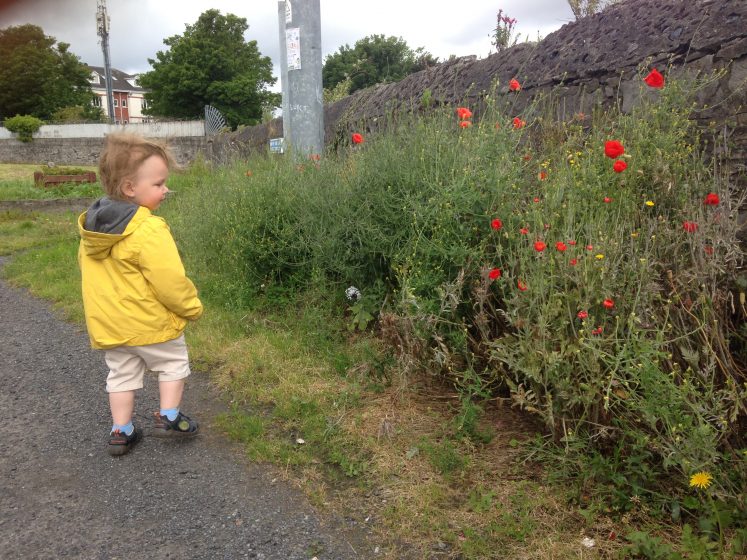
Wait, I’m beginning to think that COVID might be doing me out of a job! Well no. With all sorts of tiny wildernesses appearing on walls, or in cracks in the pavement, or in the unmanaged corners of parking lots and parks, for me personally this crisis is providing an opportunity for some of the poorest members of our society, who perhaps cannot afford to visit a national park some distance from the city, to experience what wild nature really looks like. I have been speaking of the potential values of urban novel ecosystems for many years, and finally, I am starting to see people voluntarily commenting on the emergent wildness of cities; emergent nature in cities! So, I am excited by the prospect of being able to demonstrate the values of urban novel ecosystems “in the flesh” as it were, and this has provided me with a new resolve to overcome my despondency and try harder to find a means to engage urban communities with wild nature. In this case, the first step is literally on the doorstep!
David Simon
about the writer
David Simon
David Simon is Professor of Development Geography at Royal Holloway, University of London and until December 2019 was also Director of Mistra Urban Futures, an international research centre on sustainable cities based at Chalmers University of Technology, Gothenburg, Sweden.
The adaptational effort will be immense. While certain other activities are amenable to onlin-isation, others are not—some activities will simply be impossible. All bets are off.
On the other hand, our elder son and his fiancée are both intensive care doctors who have been under relentless pressure on the frontline in two London hospitals. Given the risk to unprotected healthcare workers, exacerbated by the ongoing shortages of personal protective equipment and ongoing inadequacy of the testing regime for staff, this has been a nagging worry on them and us.
I am also immensely privileged in living in a detached house with good-sized garden on the very edge of the green belt, and with the forested expanses and beauty of Virginia Water lake in Windsor Great Park just around the corner. Unlike so many, I have therefore been able to swap my regular squash and tennis for training cycles “in nature” as the daily exercise for which, along with essential shopping and medical appointments, we are allowed to leave the house under the UK version of lockdown. Moreover, the 90% reduction of daily flights into and out of nearby Heathrow Airport has greatly reduced ambient background noise, making the birdlife far more audible.
Professionally, the progressive shutdown of travel and the universities caused anxiety and indefinite postponements of long-distance travel for research work, related workshops in Kenya, a PhD defence in Germany, and a guest university lecture in Luxemburg. Where practicable, rather like the teaching and assessment work of my university, we have rapidly reorganized to do the work online, so the guest lecture will go ahead on schedule.
While I have already done one UK PhD defence via Skype, the German system involves a whole ritual including a public lecture by the candidate and then a debate with the examiners. Hence the host university refused to countenance a slimmed down online version and we have set a provisional alternative date in mid-July. All bets are off.
Conversely, while certain other activities are amenable to onlin-isation, others are not. The bulk of planned fieldwork, multi-stakeholder discussions, and academic writing training workshop for PhD students and early career researchers in Kenya require travel and face-to-face engagement. To date, it has been impossible to reschedule this because the team comprises colleagues from Kenya, Tanzania, Uganda, South Africa, India, Argentina, the UK, and Sweden and each country has different restrictions and lockdowns, timelines, and so forth. Who knows when all will be clear, flights will resume, visas be obtainable, the respective universities have rejigged their activities to cope with lost time, and thus leave of absence be granted?
Kenya’s universities will struggle since they have been unable to go online because many students lack wifi at home, let alone stable electricity, personal computers, and enough domestic space to be able to study quietly. As I started writing this, my own university has announced radical plans to reconfigure next academic year’s curriculum and modes of delivery, on the assumption that something resembling normality for our global student catchment will be unachievable before next January. The adaptational effort will be immense, and thus, apart from contractually agreed circumstances, sabbatical leave (which I have due for Sept to December this year) has summarily been postponed a year. What this means for the grant-funded research projects I hope to win and start in September/October, not to mention other activities incompatible with intensive curriculum redevelopment and teaching…
Andrew Grant
about the writer
Andrew Grant
Andrew formed Grant Associates in 1997 to explore the emerging frontiers of landscape architecture within sustainable development. He has a fascination with creative ecology and the promotion of quality and innovation in landscape design. Each of his projects responds to the place, its inherent ecology and its people.
I have learned to take time to notice, and perhaps I have learned that however devastating COVID-19 is being, it has taught me to reflect on my Life, my Art, and my Nature.
Meanwhile, COVID-19 has brutally illustrated how our values have been corrupted and I think it is time for Life, Art, and Nature to reassert themselves as fundamental components of our culture and approach to urban development. The images of streets and squares empty of vehicles all across the world just makes you wonder why we ever need to fill them up again with such a polluting, undemocratic model of people movement. At the same time, the spotlight on parks and green spaces and walks highlights how they are universally beneficial to our health and enjoyment. I hope we can move towards landscape based cities rather than road based cities from here on.
I also hope COVID-19 proves to be the “Tree Shaker” for my professional world. We were already seeing a distinct move towards nature-based systems, greening cities and inviting nature into our lives. The climate and biodiversity emergencies were, and still will be, key drivers for change in the way we all work. Can COVID-19 be the accelerant to that? Shifting urban planning and design from vehicle and economics dominated systems to people and nature motivated place making? To social, creative, and ecological models rather than financial?
At the heart of both our professional and private lives will be the need to adapt to the new post Covid-19 world. It might be one or two years before we are able to even think about this but in that time we are all going to change how we live and work. It will strip out waste and inefficiencies. It will make us understand the value of our life support systems of clean air, water, fresh and healthy food. It will see the end of unsustainable industries and perhaps even the rapid demise of anything fossil fuel and petrochemical related. It will inevitably mean all designers have to focus on cost effective sustainable solutions informed by resilience, circular economy concepts and availability of materials. Landscapes in cities will move away from hardscapes to softscapes. Rural landscapes will move towards rewilding in those areas of poor agricultural performance and to more productive farming in the better soils. Forest and woodlands will spread across the planet. Landscape as art will also become more relevant as we try to make marks on the land that make sense about our place in the world.
This Easter I sat outdoors each day watching the world turn green. Slow at first but then rapid unfurling of leaves of multiple hues of green fill my valley view. Birdsong almost saturates the soundscape. Sunshine warms the soil ready for planting out seedlings. For the first time we have had a hedgehog in the garden, newts and frogs bring new life to our natural pool. We have had a pink moon illuminating the nightscape. I have learned to take time to notice, and perhaps I have learned that however devastating COVID-19 is being, it has taught me to reflect on my Life, my Art, and my Nature.
Xin Yu
about the writer
Xin Yu
Xin Yu (aka Fish) is Shenzhen Conservation Director and Youth Engagement Director of The Nature Conservancy China Program. Since 2017, he has overseen TNC’s first City project in Shenzhen, China, focusing on Sponge City
Will the pandemic flame urban residents’ passion to get in touch with Nature? I really hope so. Will people further respect and take care of Nature after the post-pandemic world becomes the new normal? We need to find out and do more.
Talking about COVID-19 pandemic, I’m certain that its enormous impact over the economy, governance, and people’s lifestyles is bringing us a different urban world, leaving us no choice but to change our ways of working. For those who are not familiar with urban conservation, I believe this has opened a door to them, allowing them to rethink based on the recent evidence from around the world showing a visual increase in urban biodiversity in just a few months, when most urban residents are staying home. These images press us to look at our cities as habitats shared by so many other types of creatures. This is a new lesson to teach most of us that urban land, rivers and coasts have never been truly taken away by humans from mother Nature.
Urban conservation is all about introducing changes to people’s minds and behaviors. However, due to COVID-19, urban residents are now changing themselves in many ways. It has become more difficult to organize them physically to participate in conservational actions.
In Shenzhen, the third largest city in China, after the pandemic curve has been flattened for a couple of weeks, we recently launched a responsive action called the “Grow together” Community Pro-nature Project. As a comforting nature education activity, social media and Zoom-like online conferencing tools were used to organize online workshops to provide trainings to community members about gardening. At same time, we distributed seed packets to the community while adhering to social distancing measures. Residents are now growing plants at home and will later transfer them to local community gardens or public green spaces.
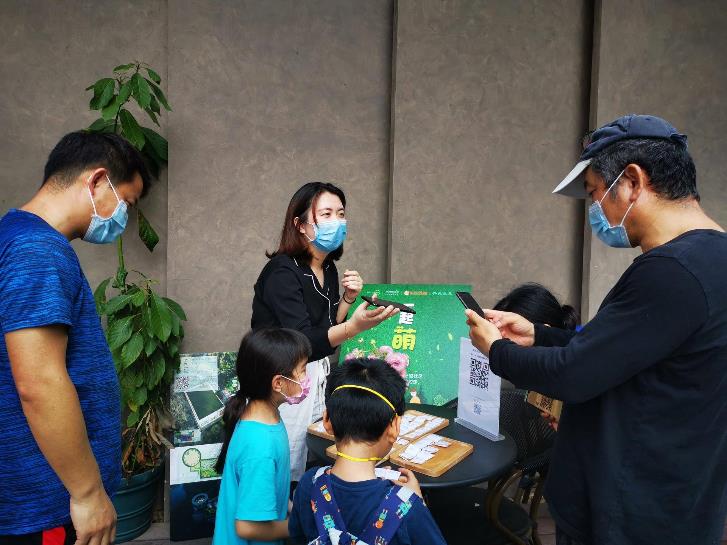
It seems that rebuilding the relationship between people and Nature, as well as between people themselves are the keys to our future work. We need to gain more skills on communicating with people via remote platforms to encourage them to stay closer to Nature in a more united way. Will the pandemic flame urban residents’ passion to get in touch with Nature? I really hope so. Will people further respect and take care of Nature after the post-pandemic world becomes the new normal? We need to find out and do more.
Bram Gunther
about the writer
Bram Gunther
Bram Gunther, former Chief of Forestry, Horticulture, and Natural Resources for NYC Parks, is Co-founder of the Natural Areas Conservancy and sits on their board. A Fellow at The Nature of Cities, and a business partner at Plan it Wild, he just finished a novel about life in the age of climate change in NYC 2050.
Instead of opening the streets up to cars again, muscling each other and spewing their nasty exhaust, we should keep the cars where they are now, inert. The city would transform itself, streets into nature trails lined with aster, sweet pepperbush, and oak trees. Our world-class electric-powered mass transportation system would connect all our neighborhoods as one equal family.
In these images from my brother I can imagine the future, in part because I’ve walked these blocks thousands of times as a lifelong New Yorker. Its emptiness is its blank slate. The pandemic forced (most of) us inside, leaving our cars parked and silent, and the air is cleaner and so are our waterways. This then is the time to re-imagine the famous thoroughfare—Broadway and Times Square.
Four hundred or so years ago, Times Square area was composed of an oak-tulip forest, Appalachian oak-hickory and oak-pine forests, a red maple swamp, and marshy and rocky headwater streams.
The wildlife then—otters and whales in the harbor, wolves and bears on the land, the bees asteroids of yellow and black—was so abundant it was more biodiverse than that of Yellowstone National Park in the western United States.
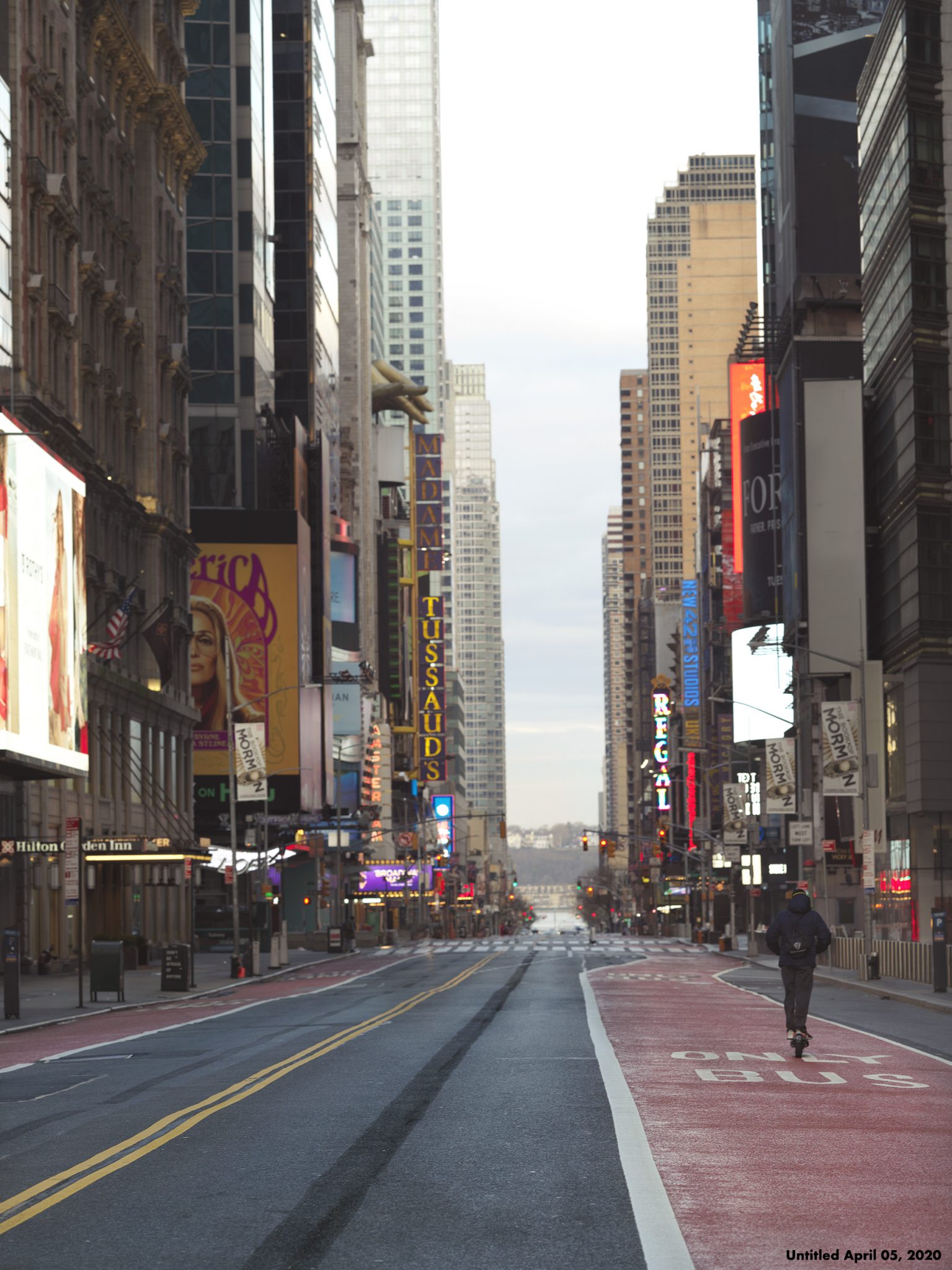
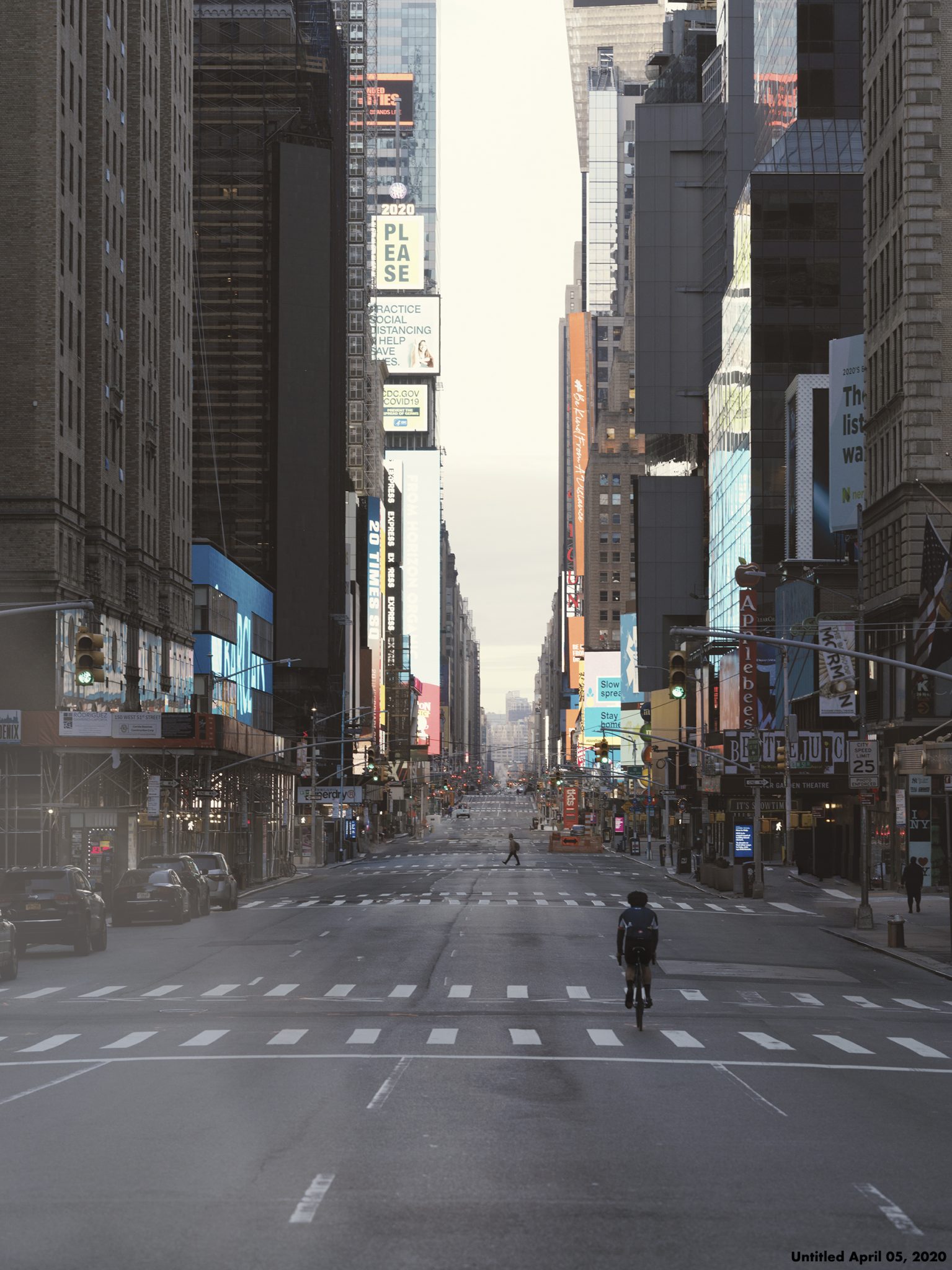
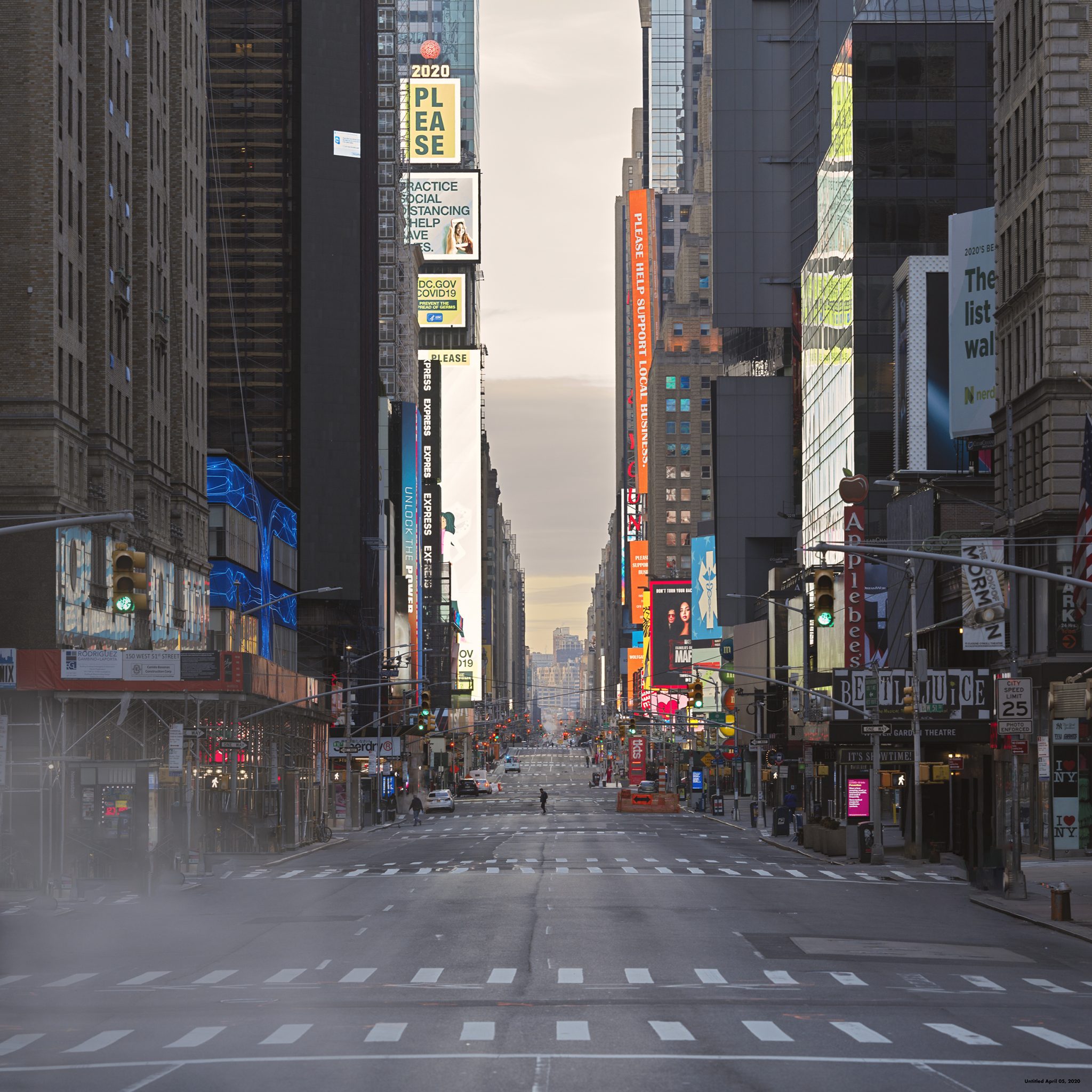
We’re a forward-looking city but at the moment we’ve been forced into a more old-fashioned way of life. Things are quieter (for most of us), work is more fluid, and I can take longer breaks in between meetings and assignments to cook a hot lunch and talk with my son. I take stock of my relationships and make sure to express my feelings to those I love. I’m less focused on myself than the health of my community, my region. When I go out, cautiously, I go into nature as there is no COVID-19 hanging menacingly from a tree’s bark or on the flower of a daffodil.
Looking forward, instead of opening the streets up to cars again, muscling each other and spewing their nasty exhaust, we should keep the cars where they are now, inert, and let’s develop a program to buy automobiles back from owners and recycle their materials. I’m in! Then dig up the streets and sidewalks of Broadway and Times Square, where I’ve had numerous concrete jungle experiences, and restore it with some of the ecosystems, in miniature and in-between the towers, that used to thrive in this place.
Slowly, the whole city would transform itself in this way, streets turned into nature trails lined with aster, sweet pepperbush, and oak trees. (Our world-class electric-powered mass transportation system would connect all our neighborhoods as one equal family.) This would allow us to keep our emissions down and our rivers and harbor clean. Starting with Broadway as it intersects with 7th Avenue and forms Times Square, the city will brim with forest (but no bears and wolves), wetland, and garden, and it will change how we live: where cars used to be there is now nature, clean air and water, and because of this more time spent outside with neighbors and loved ones, especially the kids, surrounded by and healthy within the renewing biodiversity all around us.
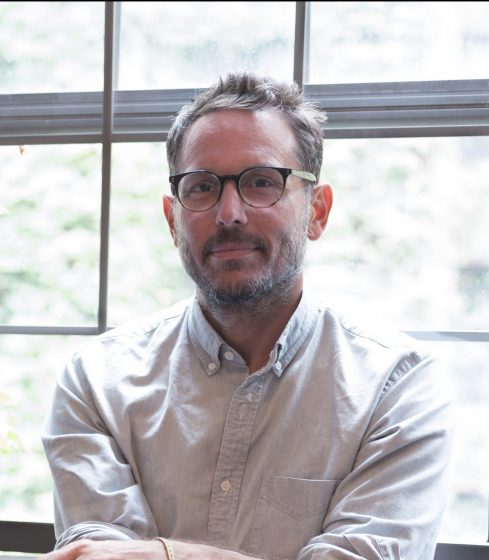
Can you imagine a New York City like this? I can.
Photos: Matt Gunther is a New York City-based documentary and advertising photographer and director. He’s worked on photography campaigns for MSNBC, Harvard Business School, and NIKE, among other businesses and institutions. He has won numerous awards. He first monograph, Probable Cause, was published in fall 2017. He’s in the process of editing a film homage to summertime in NYC.
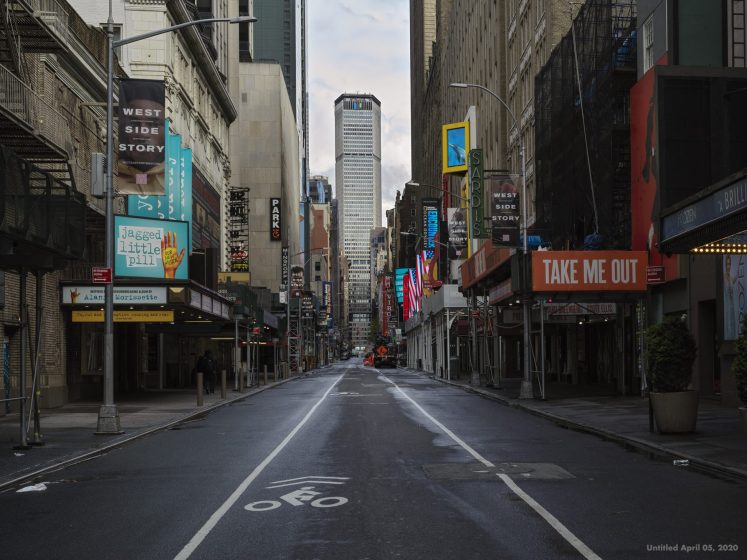
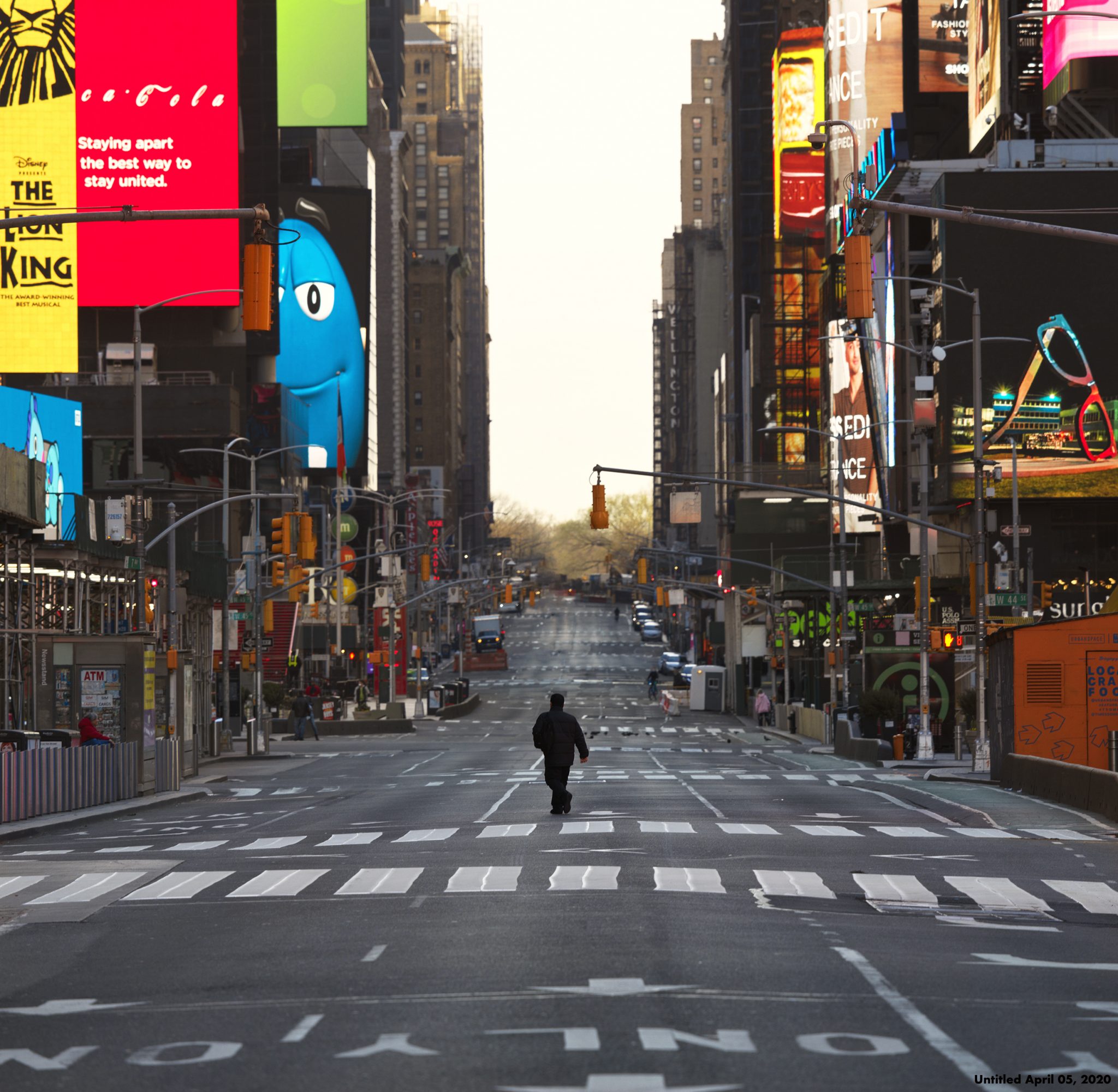
Steward Pickett
about the writer
Steward Pickett
Steward Pickett is a Distinguished Senior Scientist Emeritus at the Cary Institute of Ecosystem Studies in Millbrook, New York. His research focuses on the ecological structure of urban areas and the temporal dynamics of vegetation.
This changes everything … again; Will those of us who survive learn this time? All of us are on some verge.
In this Time of Pandemic: You can’t see your friends; You hunger for a simple hug, even a fist bump; You must stay home for months; You must manage time better and keep from an emotional abyss; You must remember this is real and serious. You understand this is part of a system of ignorance, forgetfulness, and greed; Face has been saved with lives lost; This has happened before.
In Uncertain Times: Euphemisms emerge; They will sell you a car along with a dose of sincerity.
In the Time of Climate Change: Spring comes in all wrong; Floods happen too soon, or find welcome places far from floodplains; The ocean steals into coastal water supplies; People move as if from tectonic disaster.
In an Era of Unprecedented Fire: Entire towns are consumed, just as in the days of wooden cities and timber camps; We have to learn new ways to fight fire, or how to give up, or how to prepare.
In the Era of Globalization: Jobs are snatched away, Philanthropy grows huge, but distant and blind; You have interesting new neighbors, and your cousin moves to a place where your language won’t work.
In a Time of Civil Unrest: People let go their anger; People stomp their frustration in the street; The pawn shops and big box stores are empty of guns. Fear is the order of the day. Power is still in the same hands as usual.
In the Time of the Slave Trade: The mythology of race matures and finds a home in “the natural order of things;” Some people are capital; Those who are capital are forbidden to acquire the other tools of capitalism, and so unto the generations.
Under Jim Crow: White supremacy emerges again in the public sphere, and is legally and habitually reinforced for the next ninety years; The monster cannot be subdued by individual action, and it kills, corrals, humiliates, and excludes at will.
In an Age of Mass Incarceration: “Neither slavery nor involuntary servitude, except as a punishment for crime whereof the party shall have been duly convicted, shall exist within…” (Amendment XIII); Private prisons are profitable business; The burden falls inequitably; Jim Crow is dead/long live Jim Crow.
In the Time of the Scapegoat: Fear becomes personified; Political and commercial accountability is subverted; Chinese Americans have been insulted and assaulted in the name of COVID-19; in some places mask wearers are honored, while in others vilified.
In the Time of Cholera: A time that has never ended; A time that rises from time to time in different places, from squalor and untreated water; A proper name for pandemics past.
In a Time of Increasing Automation: A threat to workers in city and country; The missing tellers, clerks, help desks; The lost wages and gained profits; The idle, hungry hands that cannot leave.
In this Crazy Time: The label that comes up when my friends and I text or video chat.
In this time… You can’t see your friends; You hunger for a simple hug, even a fist bump; You must stay home for months; You must manage time better and keep from an emotional abyss. Some friends have moved away looking for jobs; They’ve lost their pride and hope as work they might have aspired to dries up; Others have died long ago from drugs and the endless litany of the pandemics in whose times we continue to live; This changes everything – again; Will those of us who survive learn this time? All of us are on some verge.
Samarth Das
about the writer
Samarth Das
Samarth Das is an Urban Designer and Architect based in Mumbai. Having practiced professionally in Ahmedabad, Mumbai, and subsequently in New York City, his work focuses on engaging actively in both public as well as private sectors—to design articulate shared spaces within cities that promote participation and interaction amongst people.
Being locked up in the comfort of our homes is certainly a privilege. Social distancing in a time like this is a luxury afforded by a few—over 55% of Mumbai city’s 13 million inhabitants live in slums where 6-7 people share a single room.
This duration of the lockdown has offered a lot of time to reflect and critically think about work and other daily engagements. We all certainly have found ways to ensure that the work flow of our offices are not too hampered. As an architectural practice such as ours, it was difficult to cope and manage design work. But this was overcome through adapting several modes of communication and a certain up-skilling that individuals have undertaken. This testing time has certainly thrown light on finding efficient ways of communication, collaboration and co-producing work. Human desire to succeed in tough situations prevails, and with it brings copious amounts of positivity and hope.
But being locked up in the comfort of our homes is certainly a privilege. Social distancing in a time like this is a luxury afforded by a few. Over 55% of Mumbai city’s 13 million inhabitants live in slums where 6-7 people share a single room in most cases. The fate of daily wage workers who live hand to mouth is truly deplorable. With industries and businesses coming to a standstill, these workers are completely cut off from their daily source of income. Despite the state’s efforts in providing food and water to this vast and mobile people, are isolated, stranded in cities with no way home to the comfort of their loved ones. It does hit one hard.
We are all hyper aware of the pandemic at this moment in time, but the fact is that a majority of the urban poor in our country live in and encounter pandemic like scenarios on a daily basis with no access to formal housing, affordable healthcare, stable employment or any other sense of social security. It has certainly made me think about how we utilise our resources be it water, energy, produce, products, etc.
The COVID-19 pandemic has paralysed the world economy and taken countless lives. It has been close to 100 years since the devastating Spanish flu of 1918, but the frequency of such epidemics is bound to increase as we move forward. As an architect, it certainly fuels my drive to pursue large scale affordable housing as well as promote the development of accessible amenities and open public spaces for the urban masses. The general quality of everyday living must improve for the vast majorities who are often neglected in our development agenda. The change must happen now. A structural change in the way we approach policies and strategies that promote equitable distribution of resources, housing, healthcare, education and livelihoods must be taken up immediately.
The silver lining amidst this crisis has been the respite that our natural environment is receiving. With no human activity, our beaches and waterfronts are cleaner than even before, coastal marine life has come to the fore, the air is the cleanest it has been in decades and the continuous noise of cars has been replaced by the swelling sounds of bird calls. Nature is getting its much deserved break, albeit temporary. What will be the new ‘normal’ we aspire to achieve once this is behind us?
Darlene Wolnik
about the writer
Darlene Wolnik
Working since the 1980s on social change issues while encouraging civic activity across North America, Dar provides support and consulting for localized food systems, especially farmers markets.
My work supporting farmers’ markets across the U.S. remains very much the same. The markets are innovating contactless procedures at a furious pace: new “drive-thru” markets, ticketed entry walk-thru markets, curbside pickup, “click and collect” pre-ordering procedures. My days start early and go late, and at the end of each I wonder if I could have done more. Yet it is such hopeful work.
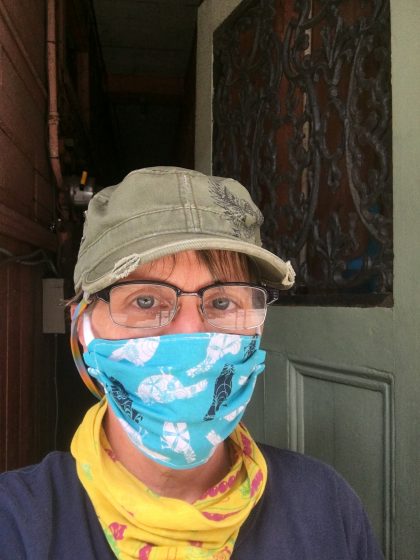 Even with that sobering reality looming over us in the next year or two, most residents still support our fierce public health-focused mayor who is determined to slow and then stop the massive rate of infection that New Orleans has suffered with since mid-March. That rate has as much to do with the health inequities that African-Americans live with at a higher rate as it is about the huge carnival celebration we hosted in January and February. Black New Orleans, who make up 60% of the city and only 34% of the state’s population, have a 70% of the infections. Even so, blaming it on our hedonistic Mardi Gras is the narrative assigned to us, and feels like the same misguided reproof we felt after Hurricane Katrina. That doesn’t help our mood.
Even with that sobering reality looming over us in the next year or two, most residents still support our fierce public health-focused mayor who is determined to slow and then stop the massive rate of infection that New Orleans has suffered with since mid-March. That rate has as much to do with the health inequities that African-Americans live with at a higher rate as it is about the huge carnival celebration we hosted in January and February. Black New Orleans, who make up 60% of the city and only 34% of the state’s population, have a 70% of the infections. Even so, blaming it on our hedonistic Mardi Gras is the narrative assigned to us, and feels like the same misguided reproof we felt after Hurricane Katrina. That doesn’t help our mood.
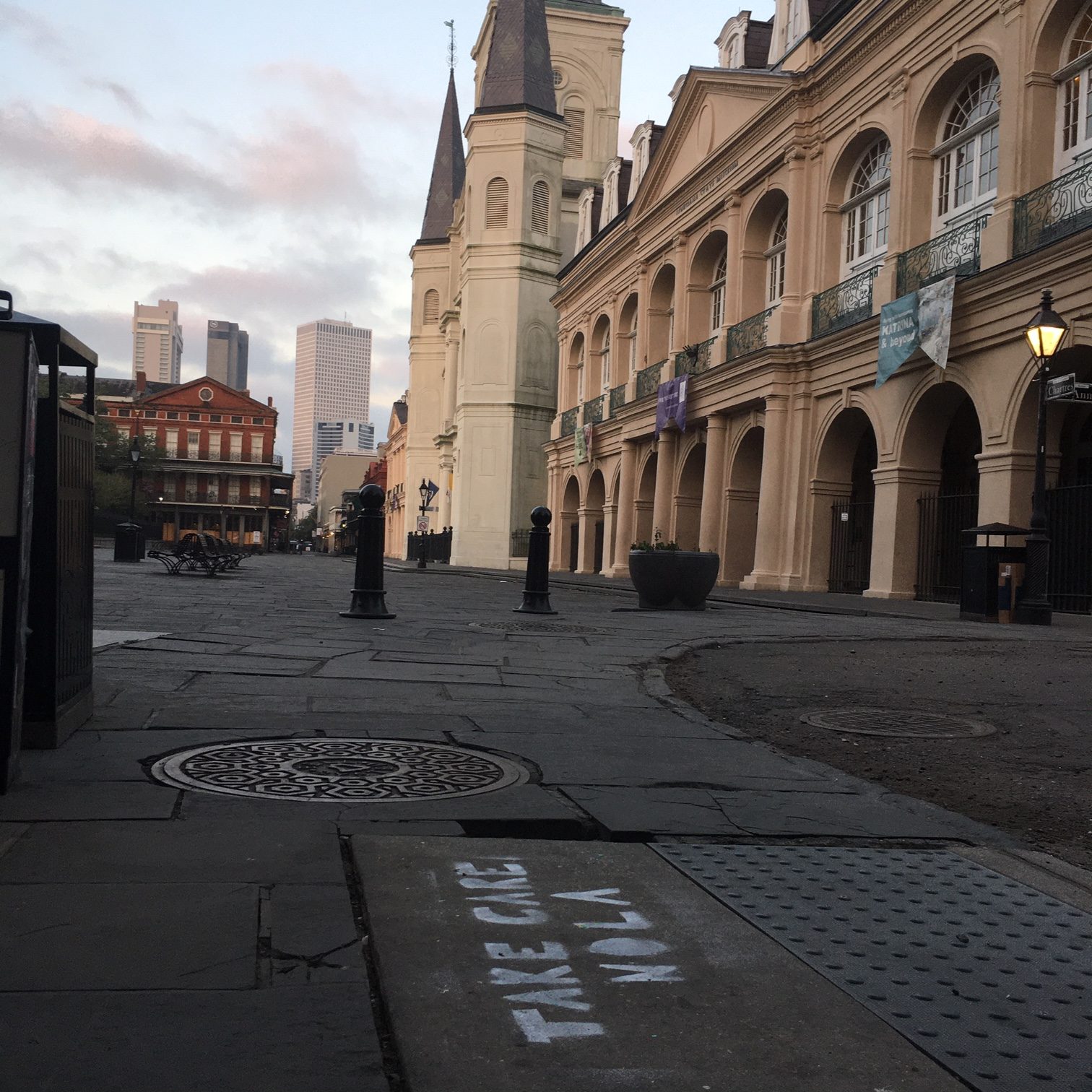 On the other hand, my work supporting the field of farmers’ markets across the U.S. remains very much the same. Our national organization has always been a remote workplace, providing technical assistance and advocacy for around 10,000 market sites, managed by about 4,000 different sizes and type organizations. Depending on their sophistication and their support, these organizations have (a) been able to open without too much trouble, (b) been delayed by government authorities in reopening when other food retail has not, or (c) unable to open at all because authorities too often confuse farmers markets with festivals. The markets are innovating contactless procedures at a furious pace: new “drive-thru” markets, ticketed entry walk-thru markets, curbside pickup, “click and collect” pre-ordering procedures. My days start early and go late with calls, video conferencing, texts, and emails asking for a resource, to share a triumph, or for me to connect them with a peer having the same issue. Right now, I work 7 days a week and wonder at the end of each if I could have done more, answered one more email, hosted another webinar or group call.
On the other hand, my work supporting the field of farmers’ markets across the U.S. remains very much the same. Our national organization has always been a remote workplace, providing technical assistance and advocacy for around 10,000 market sites, managed by about 4,000 different sizes and type organizations. Depending on their sophistication and their support, these organizations have (a) been able to open without too much trouble, (b) been delayed by government authorities in reopening when other food retail has not, or (c) unable to open at all because authorities too often confuse farmers markets with festivals. The markets are innovating contactless procedures at a furious pace: new “drive-thru” markets, ticketed entry walk-thru markets, curbside pickup, “click and collect” pre-ordering procedures. My days start early and go late with calls, video conferencing, texts, and emails asking for a resource, to share a triumph, or for me to connect them with a peer having the same issue. Right now, I work 7 days a week and wonder at the end of each if I could have done more, answered one more email, hosted another webinar or group call.
Yet it is such hopeful work.
I pick up food from local farmers and fishers a few times per month, having contacted them by phone or email. (Ironically, my nearby farmers markets have not yet reopened.) Tomorrow a group of friends will meet a fishing family outside of a friend’s house to get our seasonal drum, sheepshead, catfish, softshell crab, and shrimp orders. My family and friends check in with me regularly and my 80-year-old mother keeps in touch by text. Yesterday I dropped off beignets outside of her door, which were made by a relatively new upstart bakery downriver that has pivoted its bustling sit-down café to a 3-hours per day window service offering its culturally appropriate items like Chantilly cake, yak-a-mein, and golden beignets covered in powdered sugar. She texted me later that they were the best she had eaten in years.
Mary Rowe
about the writer
Mary Rowe
Mary W. Rowe is an urbanist and civic entrepreneur. She currently lives in Toronto, Canada, the traditional territories of the Anishinabewaki, Huron-Wendat and Haudenosauneega Confederacy, and works with government, business and civil society organizations to strengthen the economic, social, cultural and environmental resilience of the city and its neighborhoods.
I think the most profound challenge for any of us working in urbanism through and after COVID, is now that we have seen how our cities truly function at their most vulnerable, what possible excuse do we now have to not emerge solely committed to fixing it?
A few months before COVID I accepted a position to lead a national charity focused on the quality of life in Canadian cities. Canada’s Urban Institute was founded 30 years ago, before cities were as widely acknowledged as the dominant unit of human settlement of the 21st century. But in 2020 they are. Canada is one of the most urbanized countries in the world with close to 90% of the population living in communities of 5000 people or more. Two-thirds of this nation’s GDP comes out of six urban centres. But the dominant narrative in Canada does not reflect this reality. We still perpetuate a settler story: rural communities, smaller towns, two or three “global” but more likely niche cities, and an agrarian and resource extraction-based economy.
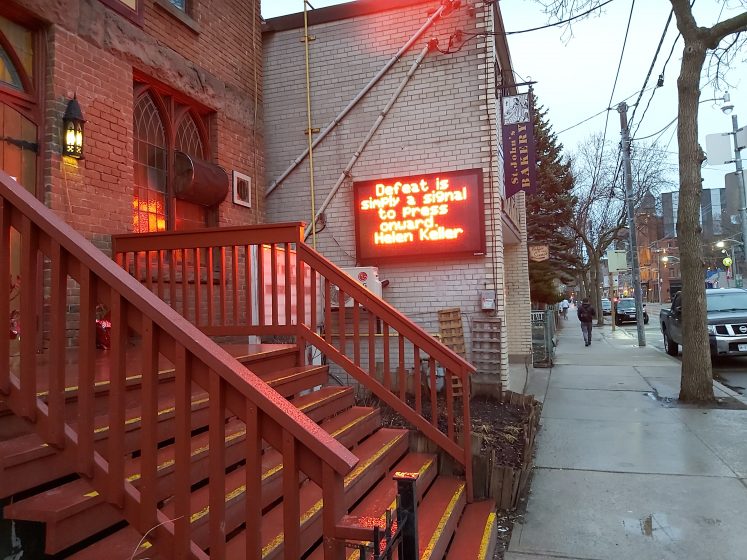 The dilemma that aged story presents Canada is an absence of coordinated urban policies and inconsistent public investment commitments to address real challenges.
The dilemma that aged story presents Canada is an absence of coordinated urban policies and inconsistent public investment commitments to address real challenges.
To create a more realistic and compelling narrative to lead to systemic change, my focus taking this gig was to focus on creating new forms of connective tissue: to foster an ecosystem of urbanism—horizontal, peer-to-peer learning in a vast country whose governance has historically run vertical: from municipalities to provinces to the federal government. What if we were able to catalyze connections between city builders—in every sector, people engaged in making their urban places more livable and resilient?
We were headed on to doing that, planning urban “residencies” in a dozen cities where we would set up a week of deep listening and connecting. The first were to be in April in two cities hardest hit by the global collapse of the oil industry: Edmonton and Calgary.
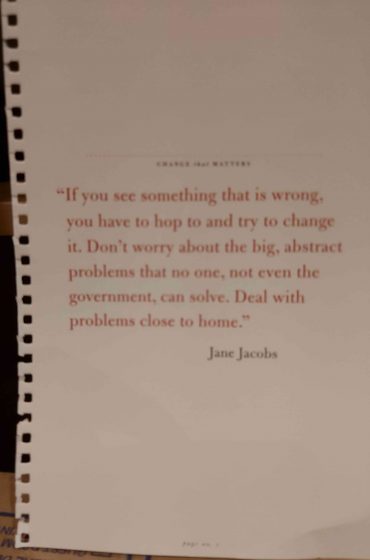 The COVID hit and travel plans were dashed.
The COVID hit and travel plans were dashed.
COVID seems to have acted like a particle accelerator—a term I borrow from NYU sociologist Eric Klinenberg, who first used the analogy to describe the how the 1995 heatwave in Chicago exposed all the neighborhood dysfunction that existed before that July, leaving poorly designed and resourced neighborhoods much more vulnerable than others. We see the same in our urban neighborhoods in Canada here in 2020. Where density was imposed without adequate public amenities, creating isolated, often over-crowded buildings, the impacts of COVID—and stay at home orders—have been devastating. Similarly, our city shelter systems, safe consumption sites, food banks—none of these have proven adequate to provide these essential services in safe, socially-distanced ways. Victoria has moved their support operations to town parks; Toronto shelters to sports arenas; public library parking lots are now foodbank depots (with librarians now stocking pantry shelves).
Our efforts during COVID have been to create three live platforms to grow our connective tissue and create a dynamic narrative: www.citywatchcanada.ca, www.citysharecanada.ca, and www.citytalkcanada.ca. These are being populated daily by hundreds of partners and volunteers. That’s the connective tissue value proposition: it tells the good (how responsive local governments and resourceful communities have been), the bad (areas where resources are badly lacking and planning and design has utterly failed) and the ugly (the starkness of underlying inadequacies in so many areas). I think the most profound challenge for any of us working in urbanism through and after COVID, is now that we have seen how our cities truly function at their most vulnerable, what possible excuse do we now have to not emerge solely committed to fixing it?
Paul Currie
about the writer
Paul Currie
Paul Currie is a Director of the Urban Systems Unit at ICLEI Africa. He is a researcher of African urban resource and service systems, with interest in connecting quantitative analysis with storytelling and visual elicitation.
COVID has surfaced a key reality for me: choice. I will be paying more attention to how cities increase the promise and attainment of choice for their citizens, who are so often restricted by cost, geography, or demography, to one option.
COVID has shown how quickly we can dismantle our globally interdependent society. It has shown the disastrous consequences of negligent leaders, and offered the basis for solidarity and pride. It has shown the stark differences between what we consider to be necessities. It has shown how meaningless these words are when cash flow stops and we can’t feed ourselves and our dependents. And unfortunately, it has reminded us that true commitment and action is so often dependent on a crisis.
Have we not for decades been demanding radical transformative action to realize social justice, environmental restoration, and equity across multiple realities or expressions? How do we get the powers that be to acknowledge the slow crises? How do we get them to acknowledge the crises of climate change, structural inequality, racism, gender-based exclusion and violence, child stunting, and environmental degradation? I am moved by our president in South Africa, who has issued the first call to a nation since 1994. I am moved by his acknowledgement of the failings to achieve an equal post-apartheid society. I hope now that when the declared national disaster for COVID is lifted, he immediately declares another national disaster that has been decades in the making, and coordinates action to address structural, rather than surface, ills.
In my work, I trace the hidden flows in cities that we tend to take for granted. These are the flows of resources that support our lives: where does our water flow? How does food grow and find us? How do we power our homes? And whither our waste be gone? A crisis shows these ignorances plain and none more so now than food and mobility. I have ever argued that some of the best infrastructure systems are based on people, and we see now the great losses as people are halted, as workplaces are closed, as informal workers are deemed non-essential, as cities grind to a halt. But we also see the new infrastructures of solidarity emerge as communities share supplies and food. In the imaginaries of future cities, I hope we don’t lose sight of the importance of people in shaping their homes, communities, and societies.
COVID has surfaced a key reality for me: choice. I will be paying more attention to how cities increase the promise and attainment of choice for their citizens, who are so often restricted by cost, geography, or demography, to one option. In our efforts to improve food, water, and energy security, how are we considering choice and agency? The city of the future lays options before all citizens, regardless of circumstance.
Antonia Machado
about the writer
Antonia Machado
Antonia Machado is the Strategic Partnerships Project Manager for the Natural Systems Enhancement and Stewardship Department at Clean Water Services in Hillsboro, Oregon.
The coronavirus has exposed deep structural weaknesses, reinforcing the notion that working across silos and centering equity is imperative to building resilience and moving towards transformative change.
A pandemic is undoubtedly different from a hurricane, but these disasters share key similarities. When I returned to Puerto Rico after Hurricane Maria, I flew in over a sea of blue tarps that covered all of the structures where the roofs had been torn off, a patchwork of blue squares against the denuded landscape. While the pandemic has left our houses intact, it has managed to pull the roof off the top of our systems, like prying the lid from a fuse box, allowing us to peer inside. Two definitions are useful here: The word “crisis” derives from the Greek word krisis, which means “decisive moment”. The word “emergency” is derived from the Latin emergere, “to bring to light”. Indeed, this crisis provides an opportunity to recognize the interdependence between our social-ecological systems, and to consider how we can act upon that recognition to increase our collective resilience.
My work centers itself around developing strategies for catalyzing transformative partnerships through Tree for All, a collaborative landscape-scale restoration program in the Tualatin River Watershed, just west of Portland, Oregon. Tree for All counts more than 35 organizations as partners, enabling the program to be one of the nation’s most successful large-scale conservation programs. In the midst of this pandemic, I am peering into the metaphorical fuse box and contemplating the role of transformational partnerships and collective impact to rebuild from this crisis.
It is well established that the impacts of large-scale conservation extend far beyond the ecological arena, providing significant benefits to the local community and economy. How do we expand upon this model, leveraging our collective capacities to pursue interdisciplinary and multi-sector approaches to wicked problems such as houselessness and climate change? This work is beyond the capacity or resources of any single organization or institution. The coronavirus has exposed deep structural weaknesses, reinforcing the notion that working across silos and centering equity is imperative to building resilience and moving towards transformative change. Our collective health is only as strong as the most vulnerable among us, and as such, this issue is not beyond the mission of any sector. A characteristic endemic to all crises is their ability to uncover the weaknesses in our structures, but it is ultimately our responsibility to use that information to inform our rebuilding efforts. My unbridled hope is that we may use these lessons to provoke an era of innovation in the form of interdisciplinary partnerships that spur transformational change.
Giles Lecuir
about the writer
Gilles Lecuir
Gilles is an expert about public policies of French local authorities, from villages to metropolis. He tracks down best practices and local initiatives in order to raise awareness and promote them, adopting a positive bias and an evidence-based approach to education in favor of biodiversity.
The confinement makes me feel intimately what I have known and said for many years now: the presence of nature in the city is not a decoration, it is a vital need for the city dweller.
Paris, (too) mineral city
Sunday, March 15, 2020, I land at Roissy-Charles-de-Gaulle airport, back from a week of work in Montreal to discuss with local partners the idea of a French-language The Nature of Cities (but that’s another story, which we’ll tell you more about here soon). The next day, the President of the French Republics announce a strict confinement of the entire population except for those people essential to essential services. But already since Thursday in Quebec, the pre-confinement was already being felt, and I spent the last two days of my trip in my hotel.
Returning to my Parisian apartment, a stone’s throw from the Moulin Rouge, I kissed my wife and children and we were committed to a confinement of at least a month. As the days go by, I realize that in this nascent spring, I can’t observe a single floricultural insect (my main hobby, via the Suivi Photography of Insect Pollinaors, the SPIPOLL, a French participatory science program). I miss it.
From my window on the 1st floor, I can only see the sky through the reflections in the windows of the upper floors. I miss that too.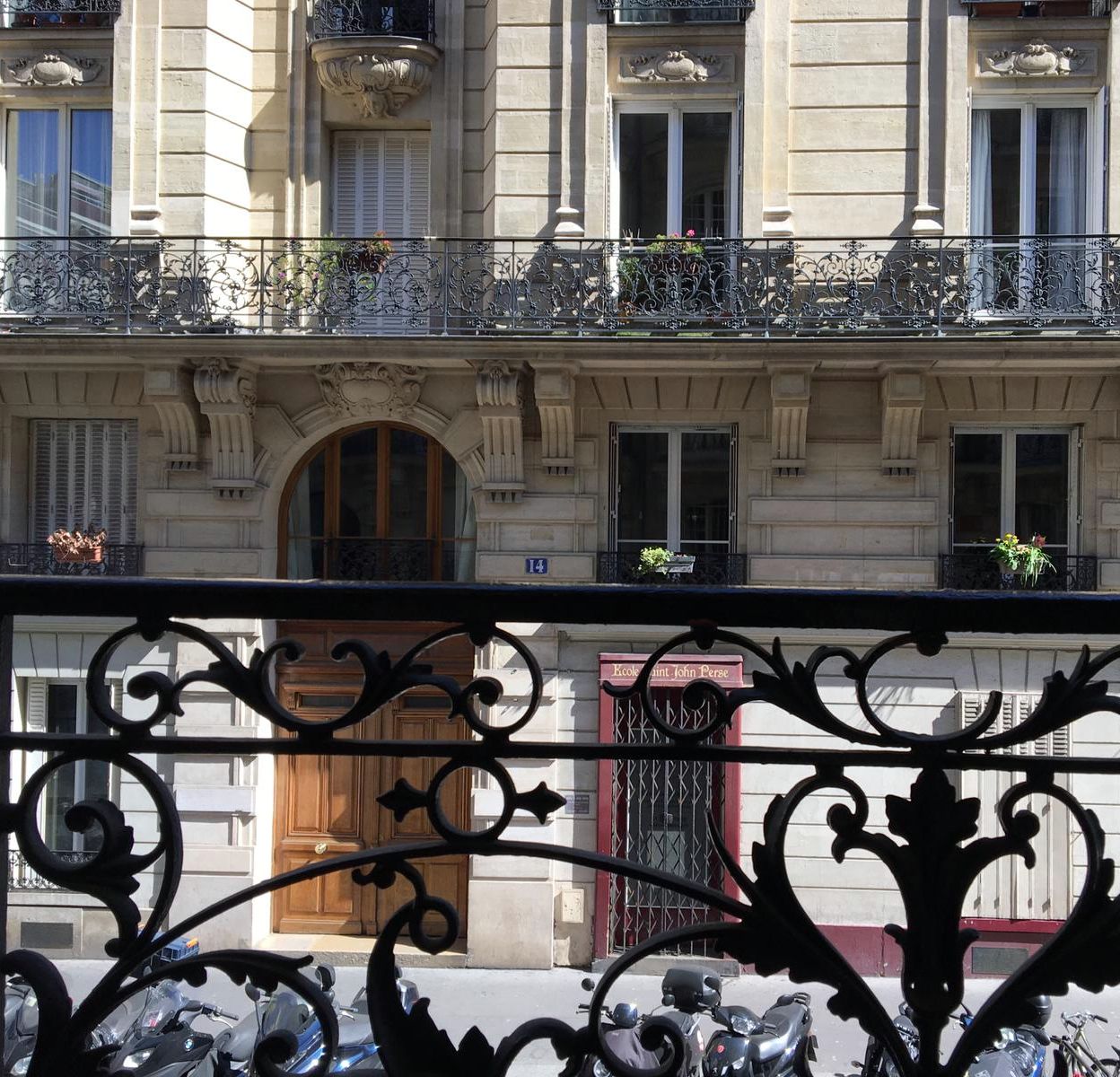 Thanks to the ornithologist Maxime Zucca, who every day on Twitter describes a Parisian bird that can be observed and listened to from home, I watch the songs, I search. Only the Crow visits me. It nests in the tall trees of the nearby Montmartre cemetery, which is closed to the public, as is the small square of Deux-Nèthes; these are the only “green spaces” in my neighbourhood. Twice a week, I go out to buy vegetables and bread, and get some fresh air: not a single flower on the sidewalk, the feet of the large plane trees on Avenue de Clichy are dry and compact, and in any case, we took great care to put a geotextile sheet on them during the last renovation of the sidewalks, to make sure that no undesirable grass can grow there.
Thanks to the ornithologist Maxime Zucca, who every day on Twitter describes a Parisian bird that can be observed and listened to from home, I watch the songs, I search. Only the Crow visits me. It nests in the tall trees of the nearby Montmartre cemetery, which is closed to the public, as is the small square of Deux-Nèthes; these are the only “green spaces” in my neighbourhood. Twice a week, I go out to buy vegetables and bread, and get some fresh air: not a single flower on the sidewalk, the feet of the large plane trees on Avenue de Clichy are dry and compact, and in any case, we took great care to put a geotextile sheet on them during the last renovation of the sidewalks, to make sure that no undesirable grass can grow there.
On my typical Haussmann-style street, which has two parking lanes and a one-way traffic lane, not a tree line. 100 metres away, a few flower boxes decorated with horticultural plants have been installed by the City of Paris, at the request of the inhabitants, to avoid the annoying parking of motorized two-wheelers on the pavement.
The confinement makes me feel intimately what I have known and said for many years now: the presence of nature in the city is not a decoration, it is a vital need for the city dweller.
What to do in the future? Remove at least one of the two rows of car parking, an unnecessary and polluting occupation of public space, and replace it with a grassy area planted with a few bushes and small trees. The City of Paris has started to create these “green streets” in an experimental way, such as Rue Blanche. It’s still very horticultural and not really low-tech, but it’s a start. We now need to massively generalize this principle of de-waterproofing and renaturalize car parking areas. This will limit the urban heat island effect caused both by the paving materials (bitumen and stone) and by the canyon-like shape of our streets which reverberate and store solar energy during the day, making the night stifling and dangerous for the most fragile among us during heat wave episodes. It is also an opportunity to devote part of the roadway to bicycles alone…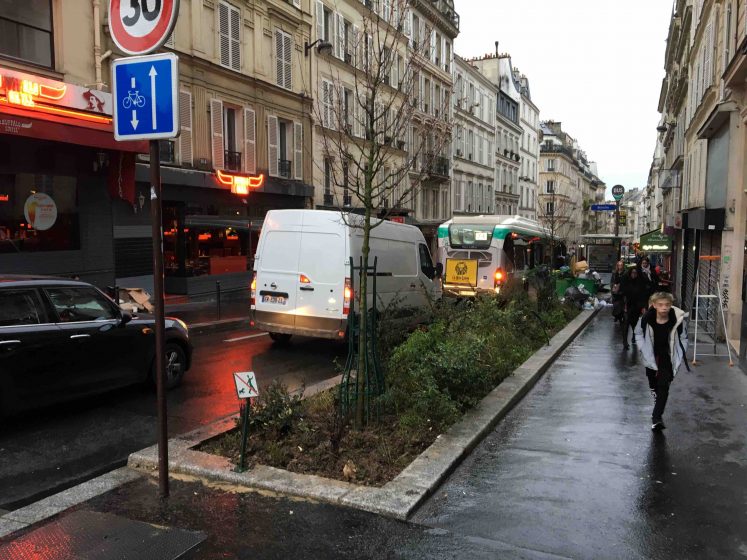
* * *
Le confinement me donne à ressentir intimement ce que je sais et dis depuis de nombreuses années maintenant : la présence de la nature en ville n’est pas un décor, c’est un besoin vital pour le citadin.
Dimanche 15 mars 2020, j’atterris à l’aéroport Roissy-Charles-de-Gaulle, de retour d’une semaine de travail à Montréal pour notamment évoquer avec les partenaires locaux de l’idée d’un The Nature of Cities francophone (mais c’est une autre histoire, dont on vous reparlera ici bientôt). Le Président de la République française annoncera le lendemain un confinement strict de toute la population sauf les personnes indispensables aux services essentiels. Mais déjà depuis le jeudi au Québec, le pré-confinement se faisait sentir, et je passais les deux derniers jours de mon voyage dans mon hôtel.
Regagnant mon appartement parisien, à deux pas du Moulin rouge, j’embrasse ma femme et mes enfants et nous voilà engagés dans un confinement d’un mois au moins. Au fur et à mesure que les jours passent, je me rends compte qu’en ce printemps naissant, je ne peux pas observer un seul insecte floricole (mon loisir principal, via le Suivi photographique des Insectes polinisateurs, le SPIPOLL, un programme de sciences participatives français). Cela me manque.
Depuis ma fenêtre du 1er étage, je n’aperçois le ciel qu’à travers les reflets dans les vitres des étages supérieurs. Cela me manque aussi. Grâce à l’ornithologue Maxime Zucca, qui décrit chaque jour sur Twitter un oiseau parisien qu’on peut observer et écouter depuis chez soi, je guette les chants, je cherche : seule la Corneille me rend visite. Elle niche dans les grands arbres du cimetière de Montmartre voisin, fermé au public, tout comme le petit square des Deux-Nèthes ; ce sont les seuls « espaces verts » de mon quartier. Deux fois par semaine, je sors acheter des légumes et du pain, m’aérer un peu : pas une fleur de trottoir, les pieds des grands platanes de l’avenue de Clichy sont secs et tassés, et de toute façon on a bien pris soin d’y mettre une bâche géotextile lors de la dernière rénovation des trottoirs, pour être bien certain de ne pas voir s’exprimer une herbe indésirable.
Grâce à l’ornithologue Maxime Zucca, qui décrit chaque jour sur Twitter un oiseau parisien qu’on peut observer et écouter depuis chez soi, je guette les chants, je cherche : seule la Corneille me rend visite. Elle niche dans les grands arbres du cimetière de Montmartre voisin, fermé au public, tout comme le petit square des Deux-Nèthes ; ce sont les seuls « espaces verts » de mon quartier. Deux fois par semaine, je sors acheter des légumes et du pain, m’aérer un peu : pas une fleur de trottoir, les pieds des grands platanes de l’avenue de Clichy sont secs et tassés, et de toute façon on a bien pris soin d’y mettre une bâche géotextile lors de la dernière rénovation des trottoirs, pour être bien certain de ne pas voir s’exprimer une herbe indésirable.
Dans ma rue haussmannienne typique, qui comprend deux voies de stationnement automobile et une voie de circulation à sens unique, pas un arbre d’alignement. A 100 mètres, quelques jardinières ornées de plantes horticoles ont été installé par la ville de Paris, à la demande des habitants, pour éviter le stationnement gênant des deux-roues motorisés sur le trottoir.
Le confinement me donne à ressentir intimement ce que je sais et dis depuis de nombreuses années maintenant : la présence de la nature en ville n’est pas un décor, c’est un besoin vital pour le citadin.
Que faire demain ? Supprimer au moins l’une des deux rangées de stationnement automobile, occupation inutile et polluante de l’espace public, et la remplacer par une zone enherbée et plantée de quelques buissons et petits arbres. La Ville de Paris a commencé à créer ces « rues végétales » de manière expérimentale, comme par exemple rue Blanche. C’est encore très horticole et pas vraiment low-tech, mais c’est un début. Il faut maintenant généraliser massivement ce principe de désimperméabilisation et renaturer les zones de stationnement automobile. Cela limitera l’effet d’îlot de chaleur urbain provoqué à la fois par les matériaux de revêtement (bitume et pierre) et par la forme en canyon de nos rues qui réverbèrent et emmagasinent l’énergie solaire en journée, rendant la nuit étouffante et dangereuse pour les plus fragiles d’entre nous lors d’épisodes de canicule. L’occasion aussi de consacrer une partie de la chaussée aux seuls vélos…
Lindsay Campbell
about the writer
Lindsay Campbell
Lindsay K. Campbell is a research social scientist with the USDA Forest Service. Her current research explores the dynamics of urban politics, stewardship, and sustainability policymaking.
For those of us privileged to be sheltering at home, the crisis has created a new sense of simplicity and attention to place. May we carry that forward wherever the future takes us.
Over the years, my thinking and writing has focused on reciprocal relationships of care between people and their environments. Along with three of my colleagues (Erika Svensden, Michelle Johnson, and Laura Landau), we started a collective journaling effort of our observations of our changing experiences with nature, stewardship, civil society, and environmental governance in the time of COVID-19, all throughlines in our pre-existing research. The effort began with a series of text exchanges and then a shared Google document we started on March 13. We have been writing near-daily since then from our homes across Brooklyn and Queens, sharing our reflections, photos, links: messages of hope and sadness that we encounter in our virtual and physical communities. The process has been deeply therapeutic for me and I think will feed our research for years to come. On a personal level, it led me to the story I’d like to share today.
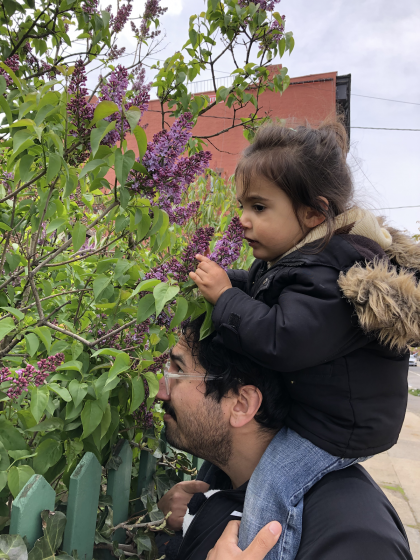 Lilacs are one of my favorite plants and a wonderful signal of spring and warmer days ahead. Last week I saw some images online from the (closed) Brooklyn Botanic Garden of their beautiful lilac collection and it made me have a visceral yearning to see and smell the plant. I knew we had some in Red Hook, but I couldn’t recall their location. So I texted my plant-savvy friend and neighbor, Gillian, to ask if she knew some lilac whereabouts and she immediately responded, telling me she had smelled some yesterday just a few blocks from where I live. So my husband, daughter and I immediately walked over to visit them; and it was certainly the highlight of my day.
Lilacs are one of my favorite plants and a wonderful signal of spring and warmer days ahead. Last week I saw some images online from the (closed) Brooklyn Botanic Garden of their beautiful lilac collection and it made me have a visceral yearning to see and smell the plant. I knew we had some in Red Hook, but I couldn’t recall their location. So I texted my plant-savvy friend and neighbor, Gillian, to ask if she knew some lilac whereabouts and she immediately responded, telling me she had smelled some yesterday just a few blocks from where I live. So my husband, daughter and I immediately walked over to visit them; and it was certainly the highlight of my day.
I think this vignette is revealing of how I—and perhaps many others—are experiencing nature in the time of COVID-19. I braid together virtual communities (the botanic garden post), personal social networks aided by technology (the text message exchange), and embodied experiences with my immediate family in my hyper-local environment. I tune into the simple beauty and sensuous experience of nature. I slow down and move at my toddler’s pace. I don’t mind if it takes me 20 minutes to walk one block to my neighborhood park, because I literally have nowhere else to go. My daughter has learned the words daffodil, tulip, and dandelion (or candylion, to her); she logrolls in the grass, because the playgrounds are closed. I walk and walk and walk, grateful to live just a block from the harbor, where I can smell the salt spray and watch the setting sun.
I appreciate this keener observation of our socio-natural world and I know that others around the globe are tuning in as well—to birdsong, to the wind on their face, to the sun shining through their window, to the sound of applause and cowbells from our neighbors—separate but together—cheering for the frontline workers. For those of us privileged to be sheltering at home, the crisis has created a new sense of simplicity and attention to place. May we carry that forward wherever the future takes us.
Brian McGrath
about the writer
Brian McGrath
Brian McGrath is Professor of Urban Design at Parsons School of Design at The New School and Associate Director of the Tishman Center for Environment and Design where he leads the Infrastructure, Design and Justice Lab. The focus of his work is the architecture of urban adaptation and change from social justice and ecological resilience perspectives.
I with others have recently postulated a metacity framework—a more flexible and adaptable form of architectural space—for the future adaptation of cities as we face a global climate crisis—such as the current pandemic. My hope for a positive outcome of this tragic virus is the development of new infrastructures in solidarity towards a just transition based on the feminist/ecologist metacity matrix.
Naomi Tsur
about the writer
Naomi Tsur
Naomi Tsur is Founder and Chair of the Israel Urban Forum, Chair of the Jerusalem Green Fund, Founder and Head of Green Pilgrim Jerusalem, and served a term as Deputy Mayor of Jerusalem, responsible for planning and the environment.
Since we are supposed to go no more than 500 meters from our homes, this is clearly a good time to see if we have all we need within that perimeter. A grocer’s? A small park? A school? A community garden?… Perhaps it is time to think just what is needed for a happy neighborhood and ask whether we have it.
Many of us are spending time in contemplation and reflection during these difficult days. We have a gut feeling that beyond the immediate and severe impact of the global Corona pandemic, there will need to be game-changing restructuring of our systems in the period following it. However, post-Corona is as yet an indistinct concept, too hazy to consider, especially as we are barely managing to cope with the storm of the pandemic as it rages.
There is an inherent contradiction in our current circumstances—we need and want to pull together, but must do so while observing strict social distancing. Virtual work meetings and social interaction are all well and good, but not as productive nor as enjoyable as real-time human interactions. Moreover, the current shut-down throws the whole world into severely challenging economic territory.
I am among those who believe that in the post-Corona age the main shift will have to be in our economic thinking and planning. When Adam Smith wrote his famous treatise, “The Wealth of Nations”, published in 1776 (the same year that the U.S.A. gained independence….) he laid the foundations of modern economic thinking. He could not have been expected to, nor did he take into account that 250 years later the world’s population would have reached its current size, and that there would be a serious danger that global resources would no longer be sufficient to provide food, water, energy and other needs for the ever spiraling numbers. In 1776 the global population was 800,000,000, compared to 7,795,000,000 today. He could certainly not have anticipated a world in which 90 percent of the total population live in cities, nor one in which more than half of us are over the age of sixty. Add to that the current on-going climate crisis, with the steady rise of sea-levels, the increasing incidence of natural disasters and the life-threatening rise in temperatures, and you might agree that there is a sufficient basis to re-think our way of looking at things, even before the recent outbreak of Covid-19.
In spite of the rise of democracy in the western world, and the attempt made in some countries to establish a welfare state (my own country, Israel, among them), the free market economy is globally predominant. Adam Smith’s “hidden hand” still moves and shakes global economic trends.
Economics students are taught that the economy is healthy when there is growth. However, as early as the mid twentieth century, some economic thinkers were already pointing out that growth cannot go on forever, especially if we take into account the dwindling resources of a finite planet. So we currently live in a world where we have to over-consume in order to maintain a healthy economy, yet we must live modestly and consume mindfully, if we are to enable our planet to continue to support human life. I am sure that many will join me in finding an inherent contradiction here.
Adam Smith claimed that the job of government is to protect national borders, to enforce civil law and to engage in public works (education, infrastructure, etc.). In our over-populated world of dwindling and finite resources, it makes sense for governments to invest in the kind of infrastructure that will conserve and protect natural resources—renewable energy, sewage treatment, desalination, innovative methods of food-growing, sustainable transportation, public health, social welfare and so on. I would humbly point out that most world governments are failing in this. Moreover, in the face of the current global Corona pandemic, world leaders are talking about a “temporary” breakdown of their economies, with the goal of picking up on production and consumption levels when this nasty patch is over.
How does COVID-19 fit into these dilemmas? The pandemic is first and foremost an equalizer, since it does not make any distinction between rich and poor, or people of different faiths, and has proved that it is truly borderless. Countries round the world are maintaining only essential services, and a tremendous drop in pollution levels has been marked worldwide as a result. On the other hand, we are paying a heavy economic price. There is a genuine spirit of community support, but a real danger that elderly people, living in physical isolation, may develop depression and anxiety.
In my own urban world, in a locked-down neighborhood of Jerusalem, I find it a fascinating game to try and reconcile the restrictions imposed on us with the concept of “local is good”, that reflects the spirit of modern sustainable urbanism. Since we are supposed to go no more than 500 meters from our homes, this is clearly a good time to see if we have all we need within that perimeter. A grocer’s? A small park? A shaded path to walk on without noise and air pollution? Kindergartens? A school? A family clinic? A community garden? A day center for the elderly? A post office? A glimpse of nature? Perhaps it is time to think just what is needed for a happy neighborhood. We might be surprised to learn the positive health impact of one that offers clean air, a taste of nature, plenty shade, and locally grown fruit and vegetables…
Looking ahead to the post-Corona era, dare we hope and strive for a better world, in which economic security does not go hand in hand with over-taxing of our natural and finite resources? Can we “repair our world”, by basing our economic planning on an equitable and sustainable system? If we do, we may look back on Corona as the chance we were given to rethink and reset our urban world, something we would have been much less likely to do if we had continued with business as usual.
Yvonne Lynch
about the writer
Yvonne Lynch
Yvonne is an Urban Greening & Climate Resilience Strategist who works with Royal Commission for Riyadh City.
I remain positive regarding a post-virus era because, notwithstanding the gravity of this situation, crisis always presents opportunity for positive transformation. Professionals in my field have always struggled to convince decision makers of the benefits of urban greening and climate adaptation. Not so much now.
Riyadh city is in the midst of delivering several megaprojects that will transform the urban fabric with the introduction of a world-class metro rail and bus network, more than 3,300 new parks and gardens, one of the world’s largest urban parks, 7.5 million new trees and the development of a water recycling network. These projects are part of implementing the Vision 2030 for Saudi Arabia which is an incredibly well-articulated strategy to drive economic diversification and greatly improve liveability. This work is unlikely to falter.
In general, I remain positive regarding a post-virus era because, notwithstanding the gravity of this situation, crisis always presents opportunity for positive transformation. Professionals in my field have always struggled to convince decision makers of the benefits of urban greening and climate adaptation. Increasingly now, I am hearing people everywhere extoll the virtues of urban nature and express gratitude for their trees, parks, and gardens during their lockdowns. This growing vocalisation and awareness of the benefits of urban nature presents an unprecedented opportunity to create a persuasive and powerful narrative linking social and urban resilience to nature. Strong communities are healthy communities, and healthy communities have easy access to nature.
We will undoubtedly experience a global economic downturn for at least two years, and I think we will see the cities that have resilience plans move forward to execute ambitious projects. Already, proactive leaders are driving change that was previously opposed or planned for gradual implementation. Europe is speeding a transition to a low car future with the Mayors of Paris and Milan leading the way with plans for extensive bike paths.
Unfortunately, the cities that are not prepared will start to slash budgets with greening amongst the top items on the list. Some of our peers will lose their jobs, others will have their budgets dramatically reduced. Those of us who are not affected, must take the time to consider how we can help our peers, so that we can maintain and grow the momentum that has been created in recent years.
As things return to normal, and they will, we need to continually and collectively drive home the message that dramatic changes are possible and to articulate the business case for creating a new and improved normal.
Isabelle Anguelovski and Panagiota Kotsila
about the writer
Isabelle Michele Sophie Anguelovski
Isabelle Anguelovski is a Senior Researcher at the Institute for Environmental Science and Technology at the Universitat Autònoma de Barcelona. She is a social scientist trained in urban and environmental planning and coordinator of the research line Cities and Environmental Justice.
about the writer
Panagiota Kotsila
Panagiota Kotsila has a PhD in Development Studies and is a postdoctoral researcher at ICTA-UAB and the Barcelona Lab for Urban Environmental Justice and Sustainability (BCNUEJ). Her research examines the unequal distribution of health risks and how the very concepts of disease, health and well-being are constructed, mobilised and interpreted through and for power.
The balance between keeping but delaying community engagement meetings, moving them online, or cancelling them all together, will be some of the many difficult decisions we will have to make in the near future.
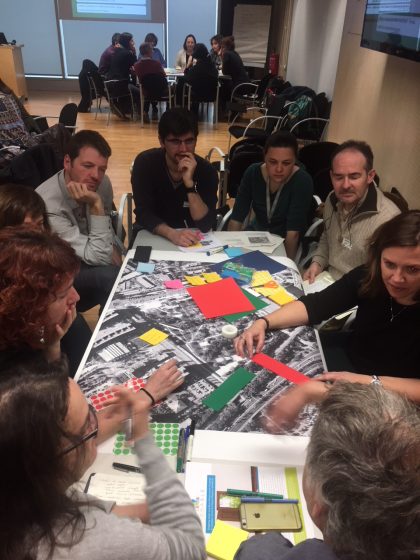 One of them, focused on ongoing urban socio-environmental conflicts and struggles, was originally planned for March 19, 2020. The event was going to bring together activist platforms in the city who are working to address real estate speculation and large-scale redevelopment in their perspective neighborhoods while, at the same time, fighting for greener and sustainable neighborhoods for long-time residents – rather than for visitors, tourists, or high-income residents. Our idea as conveners was to reflect with participants on the common issues they are facing and to strategize on possible alliances and coalitions. Our meeting was going to be supported by short videos that filmmaker Alberto Bougleux was in the process of filming about each neighborhood struggle. Needless to say, both the event and the videos have been postponed for later this summer. Because of the topic of the event and the types of activists—vulnerable residents, local groups within one city—the idea of moving the meeting online is not in order. The challenge here lies in being able to grasp how the epidemic has changed activists’ priorities and abilities to participate amidst a process of recovering from a pandemic, while also in maintaining a thematic focus that is relevant, as the timeliness of activist oriented events is key to their meaningful outcomes.
One of them, focused on ongoing urban socio-environmental conflicts and struggles, was originally planned for March 19, 2020. The event was going to bring together activist platforms in the city who are working to address real estate speculation and large-scale redevelopment in their perspective neighborhoods while, at the same time, fighting for greener and sustainable neighborhoods for long-time residents – rather than for visitors, tourists, or high-income residents. Our idea as conveners was to reflect with participants on the common issues they are facing and to strategize on possible alliances and coalitions. Our meeting was going to be supported by short videos that filmmaker Alberto Bougleux was in the process of filming about each neighborhood struggle. Needless to say, both the event and the videos have been postponed for later this summer. Because of the topic of the event and the types of activists—vulnerable residents, local groups within one city—the idea of moving the meeting online is not in order. The challenge here lies in being able to grasp how the epidemic has changed activists’ priorities and abilities to participate amidst a process of recovering from a pandemic, while also in maintaining a thematic focus that is relevant, as the timeliness of activist oriented events is key to their meaningful outcomes.
The second event was a European wide Arena event in Barcelona, planned for June 4th and 5th 2020, which would bring together academics, urban planners, practitioners, and civic groups from across Europe and thus invite a transversal (cross-domain, transdisciplinary, intersectional) dialogue on the manifestations and drivers of urban injustice in the context of sustainability planning. Some of the questions on the table have been: How does racialized or ethnically exclusionary urbanization create inequalities in access to green amenities? How does tokenistic participation in urban planning reproduce exclusion in planning more sustainable and equitable food systems? How does urban regeneration create new inequalities in planning sustainable neighborhoods and eco-districts?
For this event, organized within the framework of the UrbanA EU project, the greater uncertainty surrounding international travel, even within Europe, for the next 3-6 months, has prompted us to transform it into a two-day series of small webinars (Agenda available here). The event will thus host already registered participants and hopefully welcome additional participants who might not have been able to participate before (due to time or travel restrictions) but now might find renewed opportunity to attend and—and can now apply online.
Apart from the different type of interaction that an online event can bring (and this restrictions in building connections between our participants and Community of Practice), an important caveat here is that people will probably be “Zoomed out” by June 2020 and thus might be discouraged by the prospect of online meetings. Our plan is to have highly interactive, short webinars, with concrete outputs, rather than long online sessions. We also intend to invest quite some time in engaging participants with the ideas and the people that will be “present” in each online conversation.
The balance between keeping but delaying community engagement meetings, moving them online, or cancelling them all together, will be some of the many difficult decisions we will have to make in the near future.
Paul Downton
about the writer
Paul Downton
Artist, writer, ‘ecocity pioneer’. A former architect with a PhD in environmental studies, Paul is distressed by how the powerful idea of ecological cities has been perverted, citing ’Neom’ as a prime example. Still inspired by his deceased life-partner Chérie Hoyle (1946-2024), Paul is continuing his graphic novel / epic poem / art project called ’The Quest for Wild Cities’ that he promised Chérie he’d finish along with his 80% complete ‘Fractal Handbook for Urban Evolutionaries’!
COVID-19 has forced changes that have given nature a breathing space, but I’m betting when the capitalist engine of destruction returns to “normal” it will raid the stores of nature like a selfish bully in a candy shop. It won’t be pretty.
The title and all other quotations are from “The Machine Stops” by E.M. Forster, first published in 1909.
The usual routines of my wife and I are minimally affected by the pandemic as I work from home and have long relied on electronic communications. The dog gets a walk on the beach every day but I no longer plan to do anything else. In a world turned on its head my frustrations are trivial. But I’m angry.
Australia has dealt quite well with COVID-19 but we hold a fraction of the world population. Trump wants to sacrifice lives to rescue the US economy whilst making “democracy” and “freedom” meaningless globally. America is fighting a bizarre civil war and I’m wondering when “the Hunger Games” will start in earnest…
Imagine, if you can, a small room…
In Forster’s prescient 111-year-old story “The Machine Stops”, Vashti lives a static life in a single room, nevertheless, like an avid Facebook user:
She knew several thousand people…
Dealing with the pandemic would be unthinkable without the internet.
…in certain directions human intercourse had advanced enormously…
COVID-19 has accelerated changes already underway. Our doctor offers phone consultations and our grandchildren are attending school virtually; families are zooming in to teleconferencing…
“I see something like you in this plate, but I do not see you.”
We accept being isolated in order to talk to others, we accept a simulacrum of someone’s image on a screen and mechanical reconstitution of their voice as if they were the real thing.
The clumsy system of public gatherings had been long since abandoned; neither Vashti nor her audience stirred from their rooms.
Public space has been central to urban civilisation but life in personal bubbles mediated by machines is part of modern urbanism and pre-COVID-19 we were already abandoning meetings in the flesh.
She made the room dark and slept; she awoke and made the room light; she ate and exchanged ideas with her friends, and listened to music and attended lectures; she made the room dark and slept… Those funny old days, when men went for a change of air instead of changing the air in their rooms!
Air-conditioning and artificial light have separated urban generations from reliance on diurnal cycles and a sense of how the earth moves through space has been eroded to a point of irrelevance for much of our industrial civilisation. COVID-19 seems likely to exacerbate this condition. As we connect on-line, we disconnect from the planet. It becomes harder to understand the poison gas we can’t see and that other great invisible force pressing on our civlisation. Global heating will take many more lives than this pandemic, and there’s no quick fix.
“Have you been on the surface of the earth since we spoke last?”
Few people experience anything wild in a world of industrialised civilisation. Children ape their elders thinking that farmland is “nature”. Many will never stand on the pre-industrial surface of the earth.
And if Kuno himself, flesh of her flesh, stood close beside her at last, what profit was there in that? She was too well-bred to shake him by the hand.
Tactility is part of being human but now it’s anti-social and dangerous. Social distancing, facilitated by reliance on the virtual, presages a disaster in terms of healthy human evolution. How is it not possible to feel angry and worried about this? Is it just too “abstract”?
“You know that we have lost the sense of space. We say ‘space is annihilated’, but we have annihilated not space, but the sense thereof. We have lost a part of ourselves.”
Like many of us, I’m reviewing assumptions about the way physical social space functions in our cities. I don’t have any answers yet. Then there’s our relationship to the rest of nature. COVID-19 has forced changes that have given nature a breathing space, but I’m betting when the capitalist engine of destruction returns to “normal” it will raid the stores of nature like a selfish bully in a candy shop. It won’t be pretty. But it’s hard to be an optimist as the Trumps and Bolsanaros make things unnecessarily worse and the world outside our “western” universe isn’t looking too good, with estimates of 3 million or more likely to die in the next 12 months in Africa alone.
Forster’s story doesn’t end well but allows a glimmer of hope, with others “…hiding in the mist and the ferns until our civilisation stops…”.
I think it’s time to take the dog for a walk.
Carmen Bouyer
about the writer
Carmen Bouyer
Carmen Bouyer is a French environmental artist and designer based in Paris.
I will keep dancing half an hour a day on Zoom with people from all over the world, and join the direct local actions that bring wonder, trust, and care among people and among species, learning from the ways of trees and the songs of bees, together.
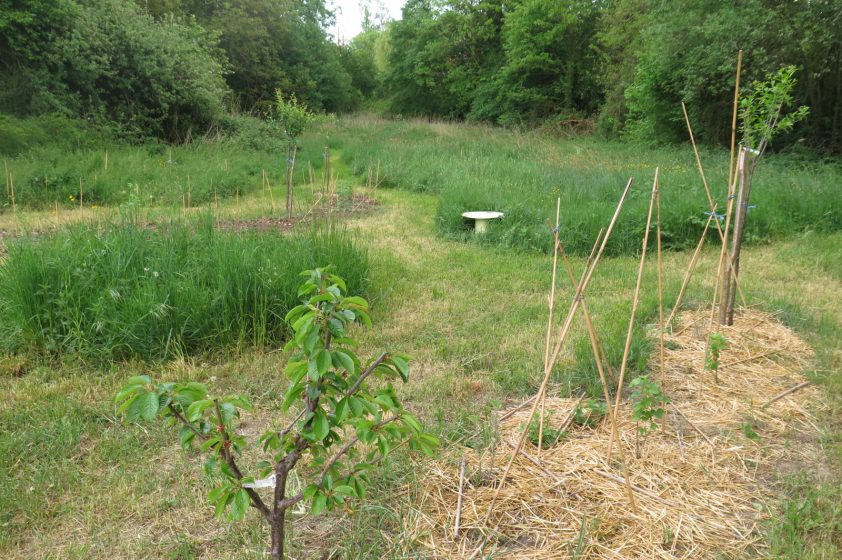
Janice Astbury
about the writer
Janice Astbury
Janice Astbury is a Research Associate at the University of Sheffield where she is working on the Breathing Infrastructures project undertaking action research related to green infrastructure, air quality, wellbeing and connecting schools with urban nature in Buenos Aires.
I hope that many people around the world are enjoying the sounds of voices and birdsong, and the experience of cleaner air flowing into their homes, and will want this to continue.
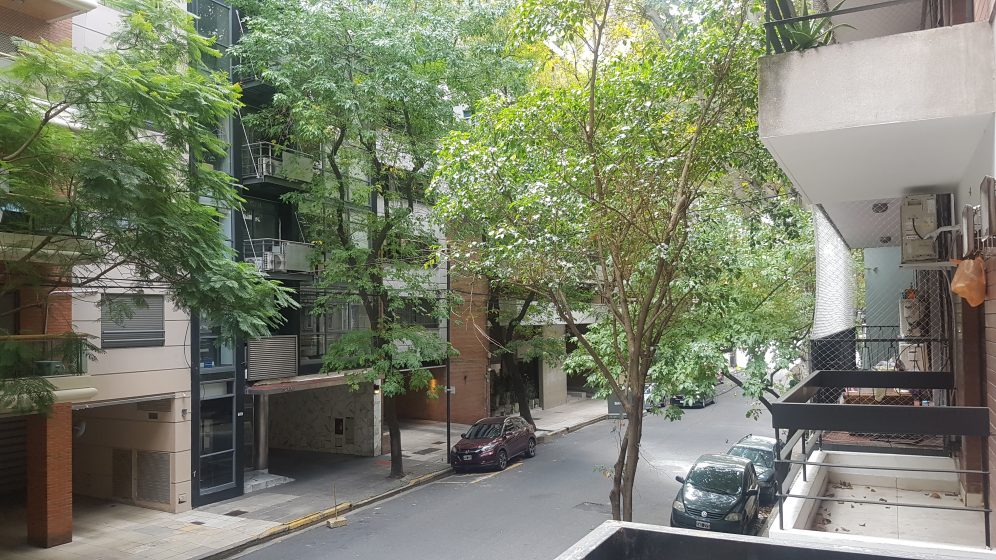
I was lucky to find somewhere to live in the neighbourhood of Palermo. The first things I noticed were the tall beautiful street trees, the balconies from which people could interact with the street, and the array of small local shops and cafes. The next things I noticed were the high volume of traffic on my residential street, the noise it created, and the exhaust fumes that seemed to flow directly into my second floor apartment. Sitting on my balcony felt like sitting on the side of a motorway and I soon stopped doing it.
Now I sit on the balcony to work most mornings and enjoy the immersion in the street life, beginning with the custodians of the various apartment buildings chatting to one another and the swish of their wet brooms as they clean the pavement outside their buildings. I think how nice it would be if they were also watering gardens. The high-end buildings across the street feature only a few stalks of bamboo in pots—one arrangement is in a glass case.
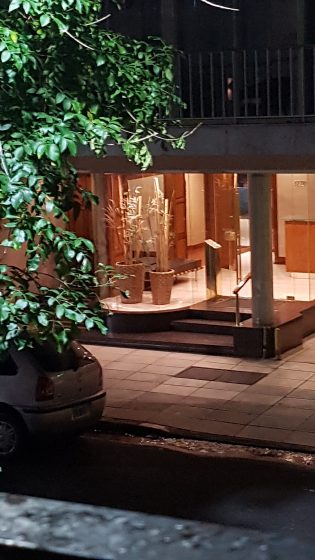
Later come the deliveries, I like the ones from the local shops where staff push shopping carts up the middle of the street. Less appealing is the daily visit from the massive truck delivering bottled water. I’m not sure about this “essential” service in an area with perfectly good tap water. I think one of the important things to come out of this experience is thinking about what’s essential, as governments all over the world deliberate on what should be included in necessities and what special permissions should be allowed. Allowing access to green space and nature is continuing to challenge many countries (including this one) and I am hoping that accessible nature will come to be seen as essential, not only during crises.
Having come here to work on a project with a focus on air quality and its impact on children’s health and development, I am thinking about the widely presumed essentialness of driving. Currently, if people want to drive somewhere, they have to fill in an online declaration stating which of the allowable exceptions justifies their movements during this health emergency.
By day 9 of the quarantine, air pollution in Buenos Aires was halved. If this can work to confront the COVID-19 health emergency, why shouldn’t it work to combat the greater illness and death caused by air pollution? Some people would still drive in the city but it would be considered exceptional, they would need to justify their travel by car. Rather than being the obvious choice, it would be the last resort. This will involve, among other things, maintaining online work practices, facilitating more active transport, and adapting public transport so that people feel it is safe to use.
I hope that some cities in the world will show the way by applying the sorts of systems they have put in place for the coronavirus pandemic to tackling the air quality and climate change crises. I hope that I myself will continue my work with greater confidence that big, rapid, creative interventions that change urban life for the better are possible. And I hope that many people around the world are enjoying the sounds of voices and birdsong, and the experience of cleaner air flowing into their homes, and will want this to continue.
Notes:
[1] Pollution in Buenos Aires went down to half due to the quarantine “La contaminación en Buenos Aires bajó a la mitad por la cuarentena” Clarin, 29 March 2020 [2] In 2016 (last WHO global assessment) 91% of the world population was living in places where the WHO air quality guidelines levels were not met and ambient air pollution was estimated to cause 4.2 million premature deaths worldwide. (WHO, Ambient air pollution: a global assessment of exposure and burden of disease, 2016)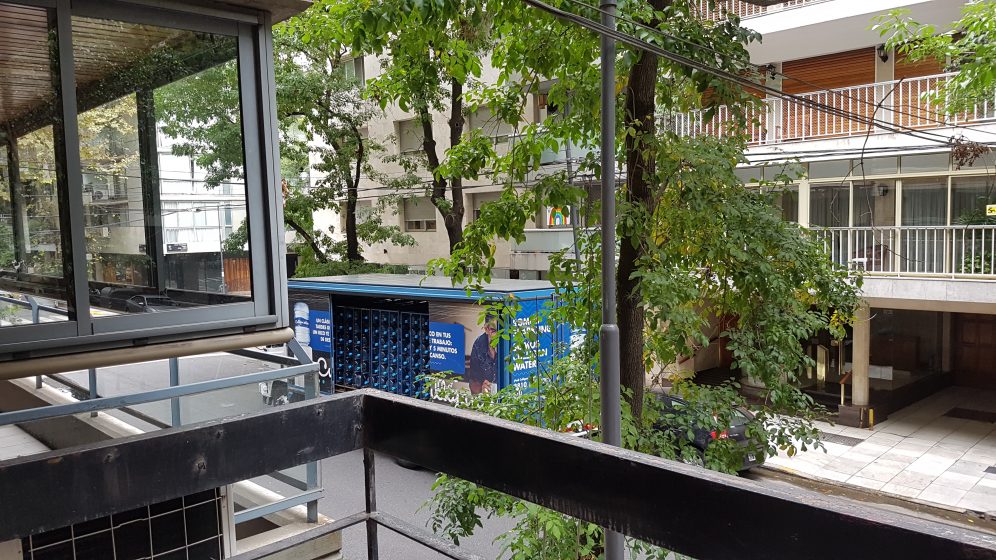
Ragene Palma
about the writer
Ragene Palma
Ragene Palma is a Filipino urbanist currently studying International Planning at the University of Westminster, London, as a Chevening scholar. Follow her work at littlemissurbanite.com.
I call for urban practitioners and legislators to immerse in the daily lives of those who have been sidetracked for the longest time, and work from there to begin championing spatial equality—visit slums, converse with the homeless, and know what it’s like to live on the verge of the city. Our previous “normal” should not be recreated.
I cannot help but contrast this privilege with the plight of so many others, who are vulnerable to the coronavirus.
Years before this pandemic, urbanists have emphasised the reality of the world’s historical urban crisis, from sporadic economic challenges in the last century to today’s spatial inequality—a powerful few dominate the “rest” and the “others”, and we live segregated lives, because we simply cannot afford to live in the city anymore. Urban literature points to gentrification, “accumulation by dispossession”, and the urban-suburb dynamic, caused by intertwined factors: globalisation, neoliberalism, and urbanisation all grew hand in hand. Migrants, slum-dwellers, and the working class experience spatial discrimination in their daily life, an unfortunate reality that has become the norm.
Now, this health crisis literally exposes the reality of an urban crisis. Around the world, those without homes, or those who have been deprived of work opportunities, show us where our plans, and our cities have failed. World leaders are faced with massive challenges—in the US, a staggering 17 million people have filed for unemployment; in the UK, authorities address the rough sleepers, and look into eviction protection; in Japan, the government moves to house “internet cafe refugees” (the homeless are associated with internet cafes to access sleeping areas and showers). In the Global South, South Africa’s struggles are haunted by the apartheid; in the Philippines, regional lockdowns threaten at least 11 million informal workers, including farmers; and in India, migrant workers have been forced to walk thousands of miles due to lack of transport provisions.
In the planning profession, we deal with the elements and components of cities that have the potential to improve how we deal with pandemics: housing, mobility, urban design, ecological integrity. These are also crucial in “redoing” a new “normal”. In revisiting how we model our plans and shape our cities, we can begin with addressing inclusion and equality.
As a start, I call for urban practitioners and legislators to immerse in the daily lives of those who have been sidetracked for the longest time, and work from there to begin championing spatial equality—visit slums, converse with the homeless, and know what it’s like to live on the verge of the city. Spatially, our previous “normal” saw our urban areas create a new breed of “colonisers”, enclaves and borders, and a push-out of the “rest” of society. This was never supposed to be a “normal” in the first place; we should not revert to what went wrong, but move towards spatial solutions that provide for all, and not just the powerful few.
* * *
Hinihikayat ko ang mga nasa larangan ng pagpaplano at mambabatas na pananaliksik ng pamumuhay ng nakararami—bisitahin natin ang mga iskwater, kausapin natin ang mga walang tirahan, at alamin natin kung ano ang kalagayan ng mga namumuhay sa loob at labas ng mga lungsod.
Napakasuwerte ko sa ganitong kalagayan; marami sa atin ang halos walang laban sa sakit na dulot ng coronavirus.
Bago ang sakuna na dulot ng pandemic, nagsulat ang mga urbanista tungkol sa krisis na pinagdaraanan ng napakaraming lungsod, mula sa problema ng mga ekonomiya sa mundo, hanggang sa kakulangan ng patas na espasyo para sa nakararami. Ang ilan lamang na nakaaangat ang nagpapatakbo ng karamihan ng negosyo, habang ang iba naman ay nabubukod sa oportunidad, at nawawalan ng kakayahang mamuhay sa loob ng siyudad. Sa pag-aaral ng urbanismo, malalaman natin ang tungkol sa hentripikasyon (o ang pagpapaganda ng isang lugar para sa mga may kakayahan), ang pagkakamal ng lupa at pag-aari habang ang iba ay nawawalan ng titirhan, at ang kagunayan ng lungsod at ng mga nakapaligid sa lungsod. Ito ay bunga ng globalisasyon (ang koneksyon ng mga ekonomiya sa iba’t ibang bansa), neoliberalismo (ang kalagayan kung saan may kawalan ng regulasyon sa ekonomiya), at urbanisasyon (ang paglago ng tao at kanilang pangangailangan). Tinatamaan ng mga ito ang mga migrante, mahihirap, mga nasa iskwater, at ang mga nagtatrabaho; nagiging karaniwan ang hindi pantay-pantay na pamumuhay.
Inuugnay natin ang krisis ng coronavirus sa kalusugan at medikal na larangan, ngunit pinapakita rin into ang isang krisis tungkol sa ating espasyo at mga lungsod. Maraming siyudad sa mundo ang naglalantad ng mga pagkukulang sa pabahay at trabaho. Sa Estados Unidos, 17 milyon ang humihingi ng benepisyo dahil sa kawalan ng hanapbuhay; sa Inglatera, binibigyang pansin ngayon ang pagpapaalis ng mga umuupa; sa Japan, binibigyan ng pabahay ang mga walang tirahan. Ang mga umuunlad na bansa ay may mga dagdag na suliranin sa pagtugon sa krisis, tulad ng kasaysayan ng apartheid ng South Africa, ang pagtigil ng kabuhayan ng 11 milyon sa impormal na sektor ng Pilipinas, at ang puwersadong paglalakad pauwi ng mga naghahanapbuhay sa India, dulot ng kawalang ng pampublikong serbisyo at transportasyon.
Sa pagpaplano, binibigyang halaga at probiso ang mga bagay na kailangan upang kalabanin ang pandemic: pabahay, paggalaw at transportasyon, disenyo ng pampublikong espasyo, at pangangalaga sa kalikasan. Kailangang kilatisin ang mga ito upang maisaayos ang laganap na kahirapan at problema sa ating mga espasyo.
Hinihikayat ko ang mga nasa larangan ng pagpaplano at mambabatas na pananaliksik ng pamumuhay ng nakararami—bisitahin natin ang mga iskwater, kausapin natin ang mga walang tirahan, at alamin natin kung ano ang kalagayan ng mga namumuhay sa loob at labas ng mga lungsod. Ang nakasanayan natin ay dakilain ang may kaya at may kapangyarihan, habang naiiwan ang ‘iba’ at nakararami. Kung tutuusin, hindi ito ‘normal’, at kailangan nating talakayin kung paano tayo magkakaroon ng patas na pamumuhay pagkatapos nitong krisis.
Si Ragene Palma ay isang urbanista o tagapagplano, at kasalukuyang nag-aaral ng International Planning sa University of Westminster, sa London, bilang isang iskolar ng programang Chevening.
Elisa Silva
about the writer
Elisa Silva
Elisa Silva is director and founder of Enlace Arquitectura 2007 and Enlace Foundation 2017, established in Caracas, Venezuela. Projects focus on raising awareness of spatial inequality and the urban environment through public space, the integration of informal settlements and community engagement in rural landscapes.
It is clear that the way we have been living and the patterns of governance we have chosen could be very different, they could change the second we decide to make them a priority and work collectively toward their fulfilment.
The misnamed Spanish flu of 1918 infected over 500 million people and was responsible for 100 million deaths. Since it coincided with WWI and economic depression it is difficult to separate the effects the epidemic might have had on the way people live from the equally devastating effects of war and famine. As we collectively devour articles, scouring over the past in order to find clues of what may lie ahead in our near future, I find myself most curious about the long-term effects COVID-19 will have on our lives. Re-dimensioning circulation corridors for social distancing, inserting sneeze guards at checkout counters, and increasing the number of divisions within homes seems to me akin to other spatial investments in the past such as underground bunkers in German homes, or bulletproof glass separations in convenient stores in Brooklyn. In other words, they may have been absolutely critical for a finite period of time, but not structural in the way we live or the choices we make.
As a direct consequence of the Spanish flu, so far, I have been able to identify two clear long-term outcomes. The first one involves changes in interior design and furniture motivated by sanitary reasons. It was believed that increased light, air, and openness would help kill germs, (the flu’s exact cause was still unknown) and the elimination of bacteria-lodging-crevices in ornament, and dust-collecting draperies typical of 19th century homes came to be seen as a deterrent for maintaining homes free of disease.[i] In other words, the white, spacious interiors flooded with light associated with modern architecture and the continuous surfaces of bent wood and tubular steel, used by Alvar Aalto, Marcel Brewer, Le Corbusier, and Mies van der Rohe in their furniture design, was as much a consequence of increased concern for hygiene as it was about practicality and the industrial aesthetic.
The other even more amazing change to which I have become aware, is the story behind Sweden’s modern welfare state. The flu affected the town of Östersund particularly hard, due to the fact that it hosted several army regiments, which in response to the war had increased in number to the point of swelling the town’s population by 50%. They were stationed in close quarters which facilitated the spread of the diseases. Another factor that aggravated the situation was the severe inequality that had resulted from the industrialization process of previous decades. Many families lived in cramped quarters, wooden shacks, and tents. Apparently, this all changed when the city’s bank director Carl Lignell, decided to take matters into his own hands by using federal funds to turn a school into a hospital, since the city did not have one.[ii] He had people quarantined in their homes, he convened a medical team to scour the city for victims and moved the sick into the transformed school. These efforts were strengthened with city-wide cooperation to organize relief, raise funds, feed, and clothe the most vulnerable. After the epidemic, what had been a week state, adopted the cooperative approach to social reform, and one hundred years later, Sweden boasts one of the world’s most exemplary welfare systems.
So, what might be the long-term effects of COVID-19 in 2020? I would like to believe they will also be closely tied to both eliminating what is superfluous and the empowerment of institutions focused on mitigating inequality. We have all been shocked to see how quickly pollution levels have diminished in the atmosphere and nearly extinct animals have reclaimed their habitats. What is superfluous and unnecessary in this case is the way we contaminate and destroy the environment, the way we overgraze our share of a planet that is shared with other beings. Considering the second point, not surprisingly, we have witnessed the complete impotence of people living in informal settlements and the homeless to defend themselves from the virus’ eminent spread. Might we, like the Swedes, collectively grow indignant of what has thus far remained a tacitly tolerated humanitarian injustice, or will we continue to embrace our indifference as a society to these manifestations of inequality. In either case, it is clear that the way we have been living and the patterns of governance we have chosen could be very different, they could change the second we decide to make them a priority and work collectively toward their fulfilment.
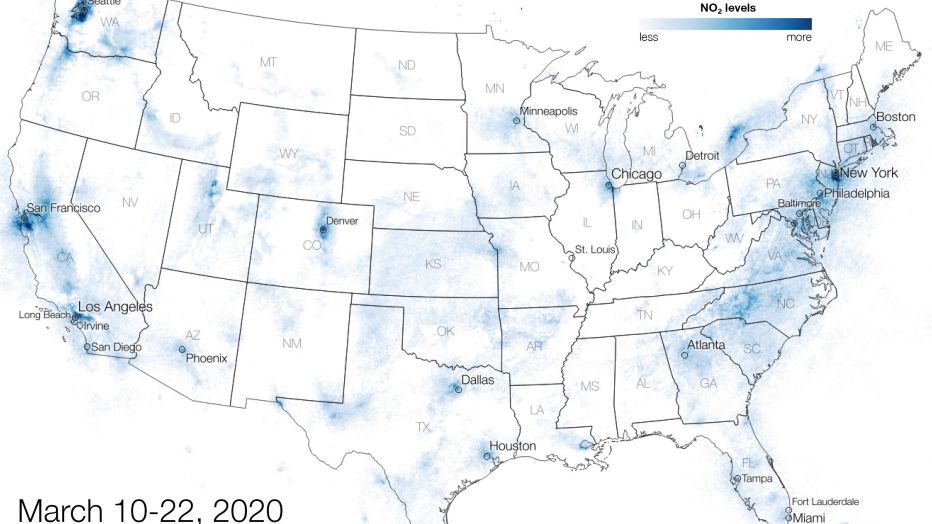
Notes:
[i] Paul Overy, Light Air and Openness: Modern Architecture Between the Wars, London: Thames & Hudson, 2008.
[ii] Brian Melican, “How Spanish flu helped create Sweden’s modern welfare state”. The Guardian August 29, 2018.
Matthew Jensen
about the writer
Matthew Jensen
Matthew Jensen is an interdisciplinary artist whose rigorous explorations of landscape combine walking, collecting, photography, mapping and extensive research. His projects investigate the relationships between people and local landscapes.
Upended/Routine/Imagine/Changed/Negotiate: Response
But who hasn’t dreamt about snapping their fingers and making air pollution go away? And all of a sudden we realize it is optional. Those scroll bar images are fun. Before. After. Before. After. What else is optional
Morning comes with deep silence; 10:00am is the new 3:00am. The sparrows tussle on the windowsill. This is nothing new. There is a male sparrow that has been advertising a hole in the eve for a few years. But now his morning chirps seem to shake the building.
My students are Zooming from across the globe. Or not at all. I am a tab now. Just another tab. Maybe even minimized. Whatever I just said was not that funny. What are they laughing at?
Spring is here. On time and ahead of schedule.
Everywhere, all at once, an entire species is changed while the rest go about their business. Except for those tigers at the Bronx Zoo.
We are on the sixth floor and the elevator is down for a few more weeks. Our neighbor across the hall, Alma, an 86-year-old wonder woman is stuck. No more senior center. Her granddaughter might die of Covid. But her daughters are worried about how she’ll can handle the news. Perhaps a virtual goodbye?
But who hasn’t dreamt about snapping their fingers and making air pollution go away? And all of a sudden we realize it is optional. Those scroll bar images are fun. Before. After. Before. After. What else is optional?
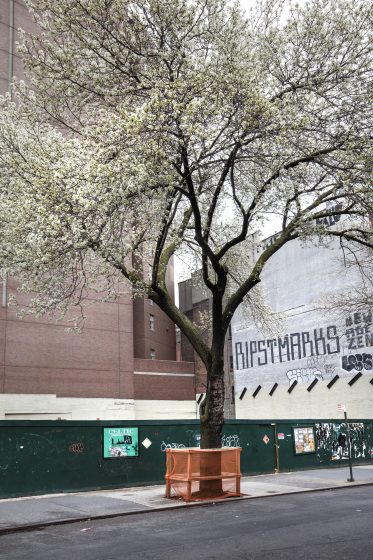
Right. I am an artist. It is not like I can turn that off.
My life post-virus? But some recovered patients are testing positive again. Or is that clickbait? It is me who needs to stay positive. Chin-up-can-do-bootstraps-yes-we-can-dawn-horizon. I used to spend so much time in the future but now I’m afraid to go there.
Summer classes? Doubtful. Fall? Well, we have to wait for enrollment numbers. Wait, are we still charging money for school? What am I not getting here?
It is time for the 7:00pm clap session and sing-along out the windows of the building. Finally, something other than bird song! But now that “this is New York” song makes me want to cry. Is it a requiem? Our building has essential workers and our neighborhood is suddenly very essential.
Negotiate? Well, I guess the stimulus payment might be considered a settlement. Is there someone else I can talk to? Someone in charge?
I do remember that article about the 130,000 saiga antelope that dropped dead in Kazakhstan. But that was five years ago. Why am I thinking about it now? Were bats somehow involved?
How many wonderful parts of our civilization were symptoms or extensions of the worst parts? I am afraid of the answer.
I photographed all the flowers blooming around our building so our neighbors that cannot leave can enjoy a digital spring, a very silent spring.
Carly Ziter
about the writer
Carly Ziter
Dr. Carly Ziter is a new Assistant Professor in the Biology department at Concordia University in Montreal, associated with Concordia’s hub for Smart, Sustainable, and Resilient Cities and Communities.
I desperately miss interacting with family, friends, and colleagues in person—but I do plan to be more intentional about the choices I make, and to appreciate every family visit, conference, and chat in the hallway a little bit more as we make our way to a new normal.
I also feel incredibly fortunate to have a relatively secure position. Having made this transition so recently, I can’t help but empathize with students and early career researchers entering an (even more) uncertain job market. It’s clear Covid is no equalizer; disproportionately affecting those already disadvantaged by our current systems. Moving forward, I hope we can collectively find equitable ways to account for the inevitable disruptions to productivity, and protect those at vulnerable career stages. I know I will continue to reflect on how I can better use my position to support those facing difficult circumstances—Covid-related or otherwise.
Despite the many challenges, if there is a professional silver lining to our work-from-home reality it’s a strengthening of communities. Colleagues and collaborators have been incredibly generous with their time and advice throughout this transition, and I sincerely hope this collegiality and kindness continues long after we’re back in our physical workspaces and the hectic pace of academia resumes. I’m also encouraged by my students’ resilience—adjusting to online courses, developing new research directions after cancelled field seasons, and supporting peers. I’ve worked hard to build a positive lab environment this past year, and recent events have affirmed that a culture where we make time for and support each other must be a priority as we enter post-Covid life.
Finally, days full of Zoom, Slack, Moodle, and more have of course highlighted technological promises and pitfalls. Our department has embraced virtual communication, and my lab has finally developed a decent online workflow—changes that will improve communication long term. I will soon attend my first online conference, and am optimistic that virtual meetings will catalyze more climate-friendly, accessible options post-Covid. On a personal note, I video chat with family weekly, my college roommates have revived our years-old group chat, and my 85-year-old grandmother has learned to text. While I wish it hadn’t taken a pandemic, I am grateful for the reminder to slow down and prioritize connecting with the important people in my life. I won’t say I’m ready to go fully online or flight free in my work or personal life—I desperately miss interacting with family, friends, and colleagues in person—but I do plan to be more intentional about the choices I make, and to appreciate every family visit, conference, and chat in the hallway a little bit more as we make our way to a new normal.
Olivier Scheffer
about the writer
Olivier Scheffer
Olivier Scheffer is a consultant in responsible strategy and innovation, the former Managing Director at NOBATEK/INEF4 (the French national Institute for Energetic Transition of the AEC sector), former R&D Director of XTU Architects, a board member of the French Committee of Biomimicry Europa, and a strategic adviser to the CEEBIOS.
We are standing at the edge of the cliff, and the coronavirus is right behind us…So how do we urgently change the urban metabolism to something highly resilient?
The Coronavirus pandemic has had the effect of a giant X-ray on our liberal globalized economies, of which megacities are the utmost expression.
We’ve discovered (or directly experienced) that our food autonomy is only of a few days. The city of Paris, France, for example, would only have a 3-days food stock if food supply stopped (be it because of trucking strikes, energy supply shortfalls or … a pandemic).
Moreover, food travels hundreds of miles (“food miles”) before reaching citizens (an average of 660 km in Paris[i], and up to 3500 km for a yogurt[ii]). The Paris Region (“Ile-de-France”) produces only 10% of the food its inhabitants eat, so most of the food is imported from “outside” the Paris area. On a national scale, 30,000 semi-trailers cross France every day to supply factories, warehouses, and retail chains just-in-time[iii]… which in the context of freight traffic disruption, might simply cut the supply of a large array of food products.
Last but not least, the whole food production value chain, from agriculture to food processing and distribution, relies heavily on energy. Researchers have calculated that for the U.S. food system, it takes 7.3 calories (one unit of energy) as fossil fuel to recover 1 calorie as food[iv], and the same is true for most industrialized countries with intensive agricultures, like France. Energy has always been used to produce food, but the major shift that happened from the 1960s on, with the “Green Revolution”, is that it started depending heavily on fossil energy, with peak oil behind us and shale oil EROEI plunging[v].
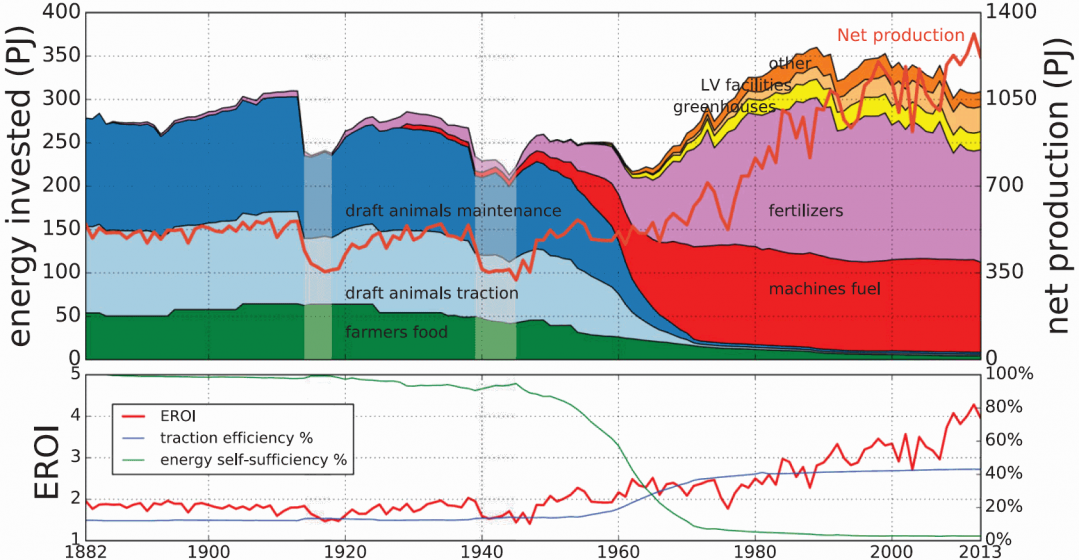

We are standing at the edge of the cliff, and the coronavirus is right behind us…
So how do we urgently change the urban metabolism to something highly resilient?
A study of the food autonomy of Paris[ix] by Sabine Barles, Professor of town planning and development at the University of Paris 1, concluded that it would take the whole Seine watershed area to produce organic food for parisians, who would have adopted a demitarian regime (50% cut in animal proteins). Commenting the study, she stated “Of course, it requires a strong political will. And above all, that public authorities and the State control land in cities as well as in peri-urban areas. We can therefore hope for development policies where the security of agricultural land is effective and where we develop a housing policy that consumes less space.”[x]
As for the low-tech technical solutions to agriculture, they already exist with permaculture, agro-forestry, or ecological agriculture.
The Paris area after collapse? That is exactly what the Momentum Institute and the Forum Vies Mobiles explored in a 2019 prospective workshop (before the coronavirus) that gave birth to this report: Bioregions 2050, Paris Area after collapse”. 240 pages of ideas and solutions for post-covid cities: https://www.institutmomentum.org/bioregion-2050-lile-de-france-apres-leffondrement-le-rapport-integral/
Notes:
[i] Etat des lieux de l’alimentation à Paris, juillet 2019
https://cdn.paris.fr/paris/2019/07/25/18df53d96022d9f6a8454347b5590b19.pdf
[ii] https://villeresiliente.org/comment/1-nourrir-paris/
[iii] Barbier C. et al. (2019) L’empreinte énergétique et carbone de l’alimentation en France.
[iv] Heller MC, Keoleian GA. 2003. Assessing the sustainability of the US food system: a life cycle perspective. Agricultural Systems 76: 1007-1041. https://www.sciencedirect.com/science/article/pii/S0308521X02000276?via%3Dihub
[v] We know that peak oil is now behind us and that it has become a critical raw material as “Today approximately 90% of the supply chain of all industrially manufactured products depend on the availability of oil derived products, or oil derived services. […] Approximately 70% of our daily oil supply comes from oil fields discovered prior to 1970. […] Since 2008, the Shale revolution (North-american tight oil or fracked oil) has increased global oil supply which stabilized increased demand.“[v] But as we move from conventional oil to shale oil, the EROEI is falling from 10-15 to 4-5 at best, and down to 1,4 for tight oil – and with the current fall in demand and prices, exploration investments will be postponed.
Michaux Simon, « Oil from a Critical Raw Material Perspective », Geological Survey of Finland (GTK), December 2019 (http://tupa.gtk.fi/raportti/arkisto/70_2019.pdf)
[vi] Harchaoui S, Chatzimpiros P. 2018. Energy, Nitrogen, and Farm Surplus Transitions in Agriculture from Historical Data Modeling. France, 1882–2013. Journal of Industrial Ecology. doi:10.1111/jiec.12760
[vii] Food system shock: The insurance impacts of acute disruption to global food supply. Lloyd’s (2015) – https://www.lloyds.com/~/media/files/news-and-insight/risk-insight/2015/food-system-shock/food-system-shock_june-2015.pdf
[viii] IPCC Special Report on Climate Change and Land (2019) https://www.ipcc.ch/srccl/
[ix] Barles Sabine et al, « Volume 1 Le système agro-alimentaire du bassin de la Seine : passé, présent et futurs possibles » (2019)
https://www.leesu.fr/IMG/pdf/piren_rapport_synthese_phase7_volume_1.pdf
[x] Usbek & Rica « « L’idée de nourrir Paris grâce aux ceintures vertes est une illusion »
Vincent Tardieu – 8 juin 2017 (https://usbeketrica.com/article/l-idee-de-nourrir-paris-grace-aux-ceintures-vertes-est-une-illusion)
Andrew Rudd
about the writer
Andrew Rudd
Andrew Rudd is the Urban Environment Officer for UN-Habitat’s Urban Planning & Design Branch in New York, where he leads substantive advocacy for the urban dimension of the 2030 Agenda for Sustainable Development (including the SDGs).
I am frequently in mourning that after this crisis the world will never be the same. I am also hopeful that after this crisis the world will never be the same.
Eric Sanderson
about the writer
Eric Sanderson
Eric Sanderson is Vice President for Urban Conservation at the New York Botanical Garden, and the author of Mannahatta: A Natural History of New York City. His upcoming book, Before New York: An Atlas and Gazetteer, will be released in 2026.
What is life, if not hope? What are our cities, if not an investment in our future? Great things will come again. Take care, my friends; hold on; and invest what you can into the long now.
I was in the middle of a really great thing when the COVID-19 pandemic came to town.
Last spring, I was offered one of fifteen coveted fellowships at the Dorothy and Lewis B. Cullman Center at the New York Public Library. For nine months, I was going to commit entirely (well, almost entirely) to one project: to complete research on a book I longed to write, summarizing everything I had learned from two decades of study about the historical ecology of all of New York City, as a kind of sequel and complement to my earlier book, on Manhattan (sensu Mannahatta). The forests of Bushwick, the wetlands of Jamaica Bay, the schisty basements of the Bronx, and the towering hills of Staten Island, and their ancient forefathers and Earth mothers, were my topic. Generations on generations of relationships, human and mostly not, developed through the planet’s long and dramatic history, had been expressed in extraordinary, beautiful, biological splendor right here, in the place where the five boroughs came to be. If the streams, meadows, and indigenous inhabitants had been forgotten under the relentless onslaught of concrete and asphalt of the 21st century city, then some old maps, dusty books, and our remaining natural areas, plus a bit of historical and ecological puzzle-solving, could help me remember them for all of us.
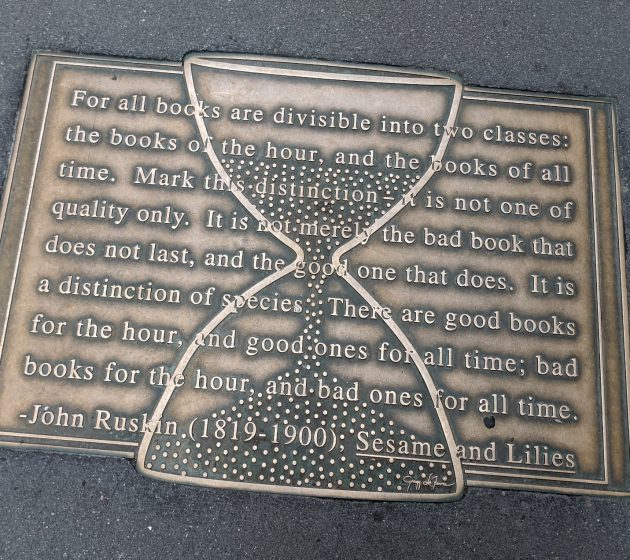
The very best part, though, was that I had lucked into spending nine months of my working life with people unlike my usual science-oriented cohort at the WCS. My fellow fellows were novelists, journalists, poets, translators, philosophers, and historians, all scholars and writers committed to plumbing the human heart and exploring the reaches of the human mind, not a scientist amongst them save me. They could carry on in ancient tongues or witty English. They ruminated on the pros and cons of back story. They knew engrossing details about people I had never heard of. Lunch time conversations ran from Nabokov to the National Book Award to techniques for baking the best sourdough bread. Yes, we were baking and breaking bread long before the library was shuttered, and we were all forced to skedaddle.
I totally understand that the breakup of our fellowship is among the lightest of burdens to carry during the pandemic. Although a few of us have been sick, none have died; and we all have some version of a home to which we can return. The library is closed, but not insolvent. Our work is largely imaginative and portable. Like so many, we now zoom and text and email; we connect as best we can; we share rumors and speculations; and we try to claw out of the vacuum vortex of talking only about COVID-19. We live and work cognizant of better days to come, if only because every other disaster we have ever seen or read about has had better days that followed worse ones, as dawn follows night.
What does any of this have to do with the Nature of Cities? Everything really. Cities are successful because of the kind of interactions the Cullman Center exemplifies: new people, new ideas, new expressions, new feelings, new friends. Scientists in conversation with artists, artists laughing with librarians, librarians effusing to philosophers. Cities, such as New York, which have been in the urban business a long time, have invested in institutional structures to foment such connections. In much the same vein, The Nature of Cities connects our global community of urban-obsessed, nature-loving, polyglots.
Of course, this same trick of determined confrontation with difference is the genius of nature too, though in manifestly more diverse ways and means. Nature is all about felicitous combination, shaped by the conditions and circumstances of place and time, informed by the past, but not bound to it, channeling an effervescent hope for the future.
What is life, if not hope? What are our cities, if not an investment in our future? Great things will come again. Take care, my friends; hold on; and invest what you can into the long now.
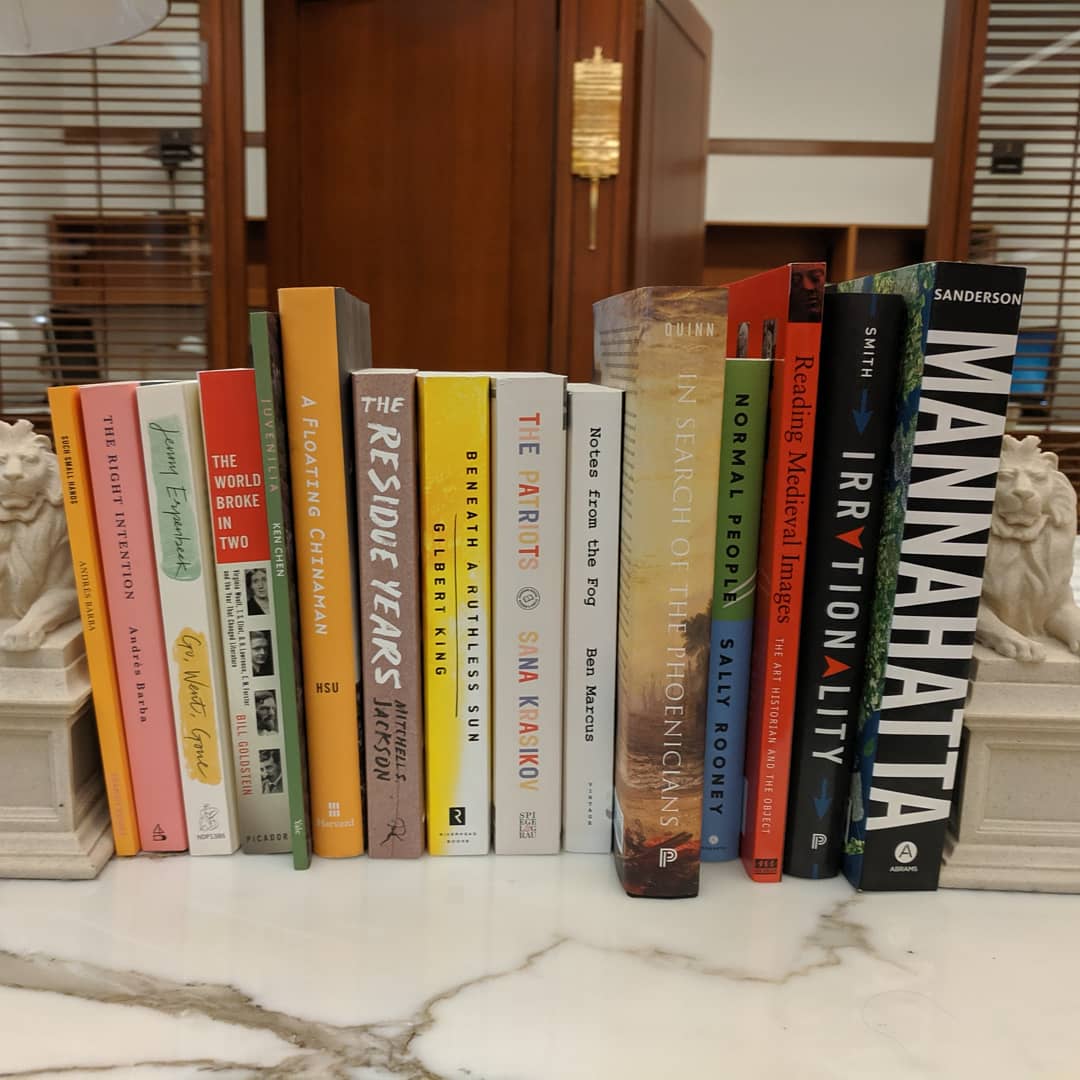
Stéphane Verlet-Bottéro
about the writer
Stéphane Verlet-Bottéro
Stéphane Verlet Bottéro (b. 1987) is an artist working at the intersection of social practice, installation, education, writing, gardening, and cooking. He is interested in the entanglements of community, materiality, body, and place. Based on site-specific research and durational interventions, his practice seeks to open spaces to unlearn and unsettle ways of inhabiting the world.
Can we, as artists, organize ourselves to inspire our institutions and societies to keep the engine on slow and never start again the machinery of neoliberal destruction? We talked long enough about politics in art. Time for action and art-as-politics.
This embodied experience came with a collective understanding of the institution’s necessary transformation towards radical sustainability, from carbon footprinting its upcoming exhibitions to an ongoing environmental policy working group. Landing on a world of pluriversal becomings implies to rethink all means of production, including cultural networks: travel slower, exhibit differently, etc.
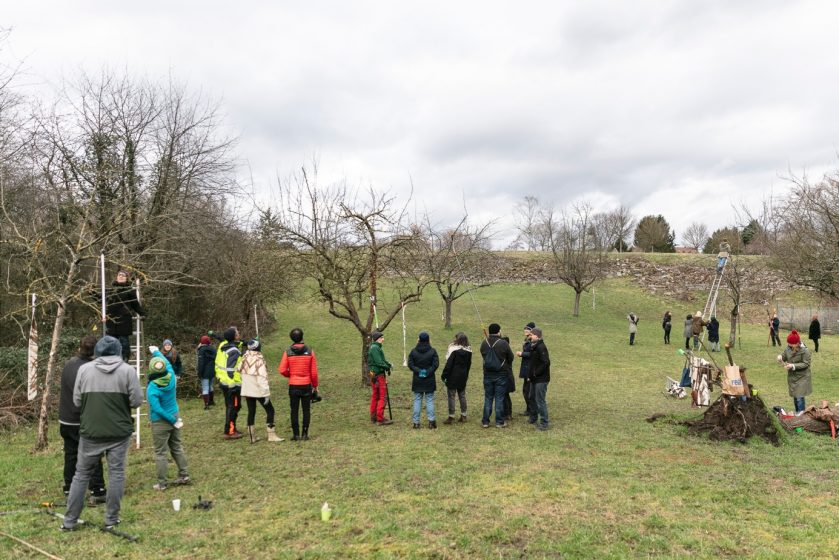 Two months later, the world tipped. Bees thrive and trees blossom in the orchard field, giving a glimpse of those speculative projections. But darker futures may also be observed. Frontline struggles, unequal vulnerability, racist, sexist, and classist body politics. Artists are not spared: while symbolic work on trauma recovery will be essential, restrictions on travels and public gatherings will deeply inhibit this therapeutic function.
Two months later, the world tipped. Bees thrive and trees blossom in the orchard field, giving a glimpse of those speculative projections. But darker futures may also be observed. Frontline struggles, unequal vulnerability, racist, sexist, and classist body politics. Artists are not spared: while symbolic work on trauma recovery will be essential, restrictions on travels and public gatherings will deeply inhibit this therapeutic function.
National culture agencies are setting up emergency funding. Museums and festivals are moving their programs online. I would also like to see in the current crisis, where and when it is possible, an encouragement to pause the race for audience figures, mega-exhibitions, hypermobility.
Like requests for conditional bailouts and calls to “not go back to normal” by other productive sectors, can we, as artists, organize ourselves to inspire our institutions and societies to keep the engine on slow and never start again the machinery of neoliberal destruction?
- Ask museums, festivals, and institutions to take binding environmental measures immediately (zero carbon venues, no flying policies, etc.)
- Decolonize cultural networks and improve mobility for Global South artists
- Shift focus to local/regional audiences and communities
- Work towards stronger ethics, economic resilience, and equality for staff and artists
- End oil and other harmful corporate sponsorship
We talked long enough about politics in art. Time for action and art-as-politics.
Gillian Dick
about the writer
Gillian Dick
Gillian is the Manager of Spatial Planning – Research & Development team, Development Plan Group at Glasgow City Council. She has a BSc (Hons)Town Planning, Heriot-Watt University and BSc (Hons) Human Geography, The Open University. She is a chartered member of the Royal Town Planning Institute and is the past Chair on their Partnership and Accreditation Panel. She is the chair of the Technical University Dublin Partnership Board, and a member of the RTPI Education and lifelong learning committee. She is an Exec member of AGI Scotland and is also a member of the Scottish Landscape alliance Exec.
We definitely need to take the opportunity to build back better, but we also need to pause and not rush when we hit the reset button. We need the right rebuilding, in the right place, at the right time, for the right communities.
It crept up slowly, the tension building. Work on Friday 13th March was relatively normal. Work on Monday 16th March was not. The train was crowded and uncomfortable. People looked worried. We were still in “herd immunity” policy. Social distancing had started and we were playing a waiting game. By the time I went home we were heading towards lock down. A week later we were there. We offered a collective sigh of relief. Then into how to we make this work. Our IT systems were not ready and some of our team members found themselves in full-on hack mode. It took us a week to get our planning service up and running again. Unlike our colleagues dealing with Parks, Roads, and Environmental Health, we quickly discovered that there was lots of work that we could do from home. Planning applications still need to be processed; government consultations still need to be responded to and, as Planners, we started to think about how to get our communities back on their feet once we come out of lockdown. The sheer tenacity and resilience of my team astounds me every day
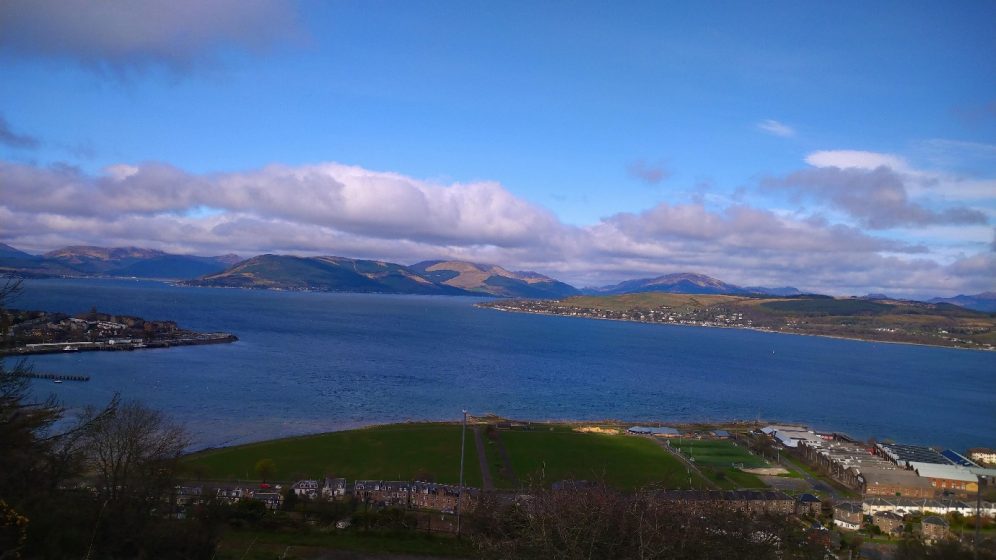
I revisited a set of essays that were published after the Christchurch earthquake in 2011. They were grouped under a set of headings that to my mind builds a framework for the future and makes me think differently about what the new normal of urban planning will be and where modern British Town Planning came from:
- Making Plans: We’ve always made spatial plans. The idea goes right the way back to the UK response to the Cholera epidemic in 1848. The first planned places came from the first Public health act that recognised that in order to be healthy people need space.
- Selling the plan: The Boar War exposed the poor health of recruits and led directly to the first UK planning legislation in 1909.
- Rewriting the rules: The idea to plan for places grew following the Spanish flu pandemic of 1918, which led to a greater emphasis on the need to have open space within housing areas and on to the garden city movement.
- Considering the common good: The devastation of WW2 led to the 1947 Planning Act that viewed unregulated market forces as a threat to public health.
- Thinking Big: Post-war urban planning sought to rethink and reimagine communities that were fit for modern living
- Acting Small: Gradually planning and health disconnected. But communities started to think that there was a better way. Community empowerment and activism started to grow.
- Meeting in the middle: Covid-19 is changing everything. Are our resilient communities still going to be there? Is a new community spirit emerging?
- Building back better: In lockdown people need space both within and around buildings that they can call their own. Balconies, roof gardens and more generous building space requirements are needed.
- Reimaging recovery: There is a new normal coming for our communities. A new way of being and a new way of living. Will we embrace a more locally connected world? Will we return to the old normal?
Covid-19 has upended all my normal routines. I’m optimistic that the new normal creates a more resilient; equitable place where more people work flexibly and in different ways. I don’t think any of the folk that I work with think that we will go back to where we were four weeks ago. It’s an opportunity to reset, reinvent, and reimagine. We definitely need to take the opportunity to build back better, but we also need to pause and not rush when we hit the reset button. We need the right rebuilding, in the right place, at the right time, for the right communities.
Nina-Marie Lister
about the writer
Nina-Marie Lister
Nina-Marie Lister is Graduate Program Director and Associate Professor in the School of Urban + Regional Planning at Ryerson University in Toronto.
For now, I take solace in the routine of daily bread. The measured pace of the knead, the proof, and the rise offers structure to my blurry days. Ultimately, it is the realization that this simple, measured act and its alchemy are both literally and figuratively what sustains us in its slow and patient way.
I am frustrated as I turn the loaf in the old cast iron oven. I can’t tell if the heat is even or the crust is charred. Wood-fired sourdough is a learning curve. I’ve always been a baker, and I’m (not so secretly) proud of my sourdough, made with my lively 6-year-old home-grown ferment. But here, on the farm in isolation things are more basic. No thermometer, electronic scale, artisan flour, or exotic sea salt. I have just the raw elements: flour, salt, water—plus the basic biology of fermentation, the alchemy of microbes at work. The irony does not escape me that the coronavirus pandemic seems to have catalysed the (re)discovery of yeast… and baking. The store shelves are devoid of flour. Instagram photos of home baking have surged. I wonder, have the microbes have conspired to distract us?
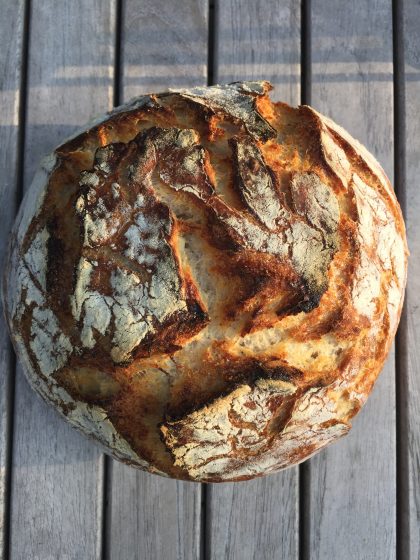 In these hazy locked-down days that blend from one to the other, along with (but apart from) many others, I am doing a lot of baking. I am also exhausted and yet I can’t remember what time it is. I am always on the computer or the phone, contingency planning or organising food deliveries. I admit there are too many wine bottles in the recycling bin. I swing between euphoria and depression, caught in the pandemic pendulum. Everything has changed in a relative blink: we’ve pivoted from working in close physical and social proximity to virtualizing our offices (albeit clumsily and tenuously), blending our home and work lives into a slurry that slips between chaos and creativity.
In these hazy locked-down days that blend from one to the other, along with (but apart from) many others, I am doing a lot of baking. I am also exhausted and yet I can’t remember what time it is. I am always on the computer or the phone, contingency planning or organising food deliveries. I admit there are too many wine bottles in the recycling bin. I swing between euphoria and depression, caught in the pandemic pendulum. Everything has changed in a relative blink: we’ve pivoted from working in close physical and social proximity to virtualizing our offices (albeit clumsily and tenuously), blending our home and work lives into a slurry that slips between chaos and creativity.
Of course, our homelives are just that, homes, often shared with children, elders, pets, and plants that creep and crash into our Zoom screens as an abrupt reminder of these now-blurred boundaries of live, work, and play. Many are struggling with the more immediate social and economic fallout of the pandemic pivot: risk, hunger, poverty, bankruptcy, abuse, despair, fear, loneliness, and of course, sickness and death. No one wants to be here, everyone wants to go back/forward/anywhere but this. Being “at home” is now loaded; it means so much more suddenly. More pressures to combat doing nothing at the office by doing everything in the home: Learn a new language, homeschool the kids, take up dance, play an instrument, write a book, organise those pictures, master knitting, sewing, singing, baking. Anything to keep busy, pass time, distract and deflect our attention from what is really happening. We don’t want to see or feel, let alone be in this moment. I think we want to bake our way into oblivion.
But crisis is where we will learn who we are. Really, we need to just STOP. Breathe. Slowly. Sit, as Donna Haraway reminded us, with the trouble. I don’t know when this will end. I can’t tell my students or my kids with any certainty at all. But I do know it has changed us, and what matters is what we will do with this change. For this we need to stop, breathe and think a while. Steep in the pandemic pause. Look up and around, notice, listen, SEE. The air is cleaner, the waters are clearer. Wildlife are roaming our streets, returning to the places we’ve abandoned. We say the cities are “eerily quiet”, but this really means less traffic, construction noise and airplanes. When I listen, I hear the songs of people, birds, frogs… and the earth breathing.
What are we learning in this in-between, in the months where time seems suspended? What will we take from this turn? The invisible force of a virus catalyzed a change in human behavior that only months ago was unimaginable: we shut down the global economy, and we paused. For a brief moment, humanity acted together, for our own collective good. And the planet breathed. So in the headlong rush to return to “normal”, will we lose the gift of this foresight, a glimpse of the possible in the pandemic pause? I don’t know, but I hope.
And for now, I take solace in the routine of daily bread. The measured pace of the knead, the proof, and the rise offers structure to my blurry days. Ultimately, it is the realization that this simple, measured act and its alchemy are both literally and figuratively what sustains us in its slow and patient way.
Erika Svendsen
about the writer
Erika Svendsen
Dr. Erika Svendsen is a social scientist with the U.S. Forest Service, Northern Research Station and is based in New York City. Erika studies environmental stewardship and issues related to hybrid governance, collective resilience and human well-being.
I am grateful for all those who are working outside during this crisis and the sacrifices they have made all these days. Nature’s stage crew, so to speak. In the future, I’d like to explore ways to help strengthen our green workforce and support those within it that are most vulnerable during times of crisis.
It’s true that my normal weekly routine has changed, but I have returned to an activity that I have always enjoyed: walking and watching.
At the beginning of this crisis, I was walking with friends. Then, with just one friend. Then, only with my husband. And then, alone. And in doing so, I remembered how much of my early research had been inspired by everyday urban nature-human observations. These days, before my household is awake, I rush outside to walk and look for signs. Signs that remind me of the reciprocity between humans and the non-human world. Signs that spark my curiosity. And signs that give me hope. I see sign on fences thanking hospital staff, teachers, and restaurant workers. I see purple ribbons tied around trees. I notice new vegetable plots carved out of front lawns and side yards. I see people setting out window boxes and planters.
I started to think about how my friends and family have been telling me how grateful they are for nature. Grateful for the trees and the trails, the forested parks and gardens, the playgrounds and lawns, the bikeways and waterfront parks. All providing bit of solace during these tragic times. I have to admit that I started to get a little defensive in my mind as I thought, “That’s cool. But do people realize that there is a stage crew that helps to put on this amazing public nature show?” I took my own walk in nearby Prospect Park in order to regain some calm repose and an inner voice reminded me, “Hey, remember that all this natural beauty doesn’t come easy.”
Each day, I look out the window to see the park across the street from my apartment. It has been locked for weeks. When the emergency orders began, people flocked to the parks for some fresh air. People gathered in a way that was too close for comfort, so many of the parks have closed. I watch as an elderly woman pushes a cart and stops at the gate. She looks defeated as she ponders the lock and chain. I think to myself, “Does she have another place to go? Where can she rest around here? She can’t possibly get on the subway or a bus to find another park!”
I recognize a park regular as he sits down on the edge of a street tree guard. He sets out a small cup for change. I see a worker walk toward the park with a morning coffee and bagel. He quickly pivots to sit on a stoop across the street. I hope no one comes out to usher him along before he finishes breakfast. I see a woman simply standing at the corner of the park. I see she is closing her eyes and tilting her face up, toward the sun.
As time goes on during the stay-at-home order, I see fewer people around the park. I still look out that window, waiting for my favorite redbud trees (Cercis canadensis) to bloom. I notice there are two people who return to the park each day. They arrive at different times. The morning person is a park worker, wearing a bright NYC Parks t-shirt. She is sweeping the park, picking up the occasional food scrap (sorry, squirrels), and straightening up. I now realize she has always been there, since the beginning of this crisis and long before.
In the afternoon, a man appears in the park and gets to work quickly, tending to the flowers and my redbud trees. Weeding and a bit of pruning today. I know him to be a park volunteer. I think about that. Where does he find the time? Like the park worker, he is wearing a mask and working alone, not speaking to anyone.
My thoughts go back to all the park workers out there, the volunteers, and the greening NGOs in my city. In our parks, they are bravely showing up despite their own challenges. I know that many of these park workers are seasonal or temporary. I know that the greening NGOs are trying to find ways to adapt their field work, funding, and programs as a result of this crisis so they can continue to support the nature just outside my window and well beyond.
I am grateful for all those who are working outside during this crisis and the sacrifices they have made all these days. Nature’s stage crew, so to speak. I am also proud of the network of people that I work with in my field of forestry and natural resource stewardship. In the future, I’d like to explore ways to help strengthen our green workforce and support those within it that are most vulnerable during times of crisis.
Mary Hall Surface
about the writer
Mary Hall Surface
Mary Hall Surface is a playwright, director, and teaching artist. She is devoted to intergenerational audiences, multidisciplinary collaborations, and to transforming communities, museums and schools through the arts.
At its best, theatre is a unique forum where communities can imagine together. We gather and literally align our beating hearts as a story unfolds told by actors who breathe our same air. My nightmare new normal is a Romeo and Juliet who never touch, watched by a masked audience too afraid to believe the story.
February 1, 2021. Almost 10am. Actors arrive for rehearsal. Cautious, efficient troopers leave their shoes at the door, wash their hands, wave across the large room. They stretch, run in place, alone in six-foot intervals of space. They circle wide, backs to one another as they warm up their voices, muffled behind facemasks. Three actors then stand in separate spots and raise their arms on cue as a fourth, lifted only by her own toes, grounded, spreads her arms like wings. She’s flying. Maybe.
When trying to imagine theatre in the new post-virus “normal,” my colleagues tend to focus on audiences. How far apart can we seat people? Do we hand out masks at the door? Take temperatures before taking tickets? These are shattering images. But what keeps me awake at night is picturing a socially distanced rehearsal process that leads to a performance by face-masked actors who never physically connect. My nightmare new normal is a Romeo and Juliet who never touch, watched by an audience too afraid to believe the story.
At its best, theatre is a unique forum where communities can imagine together. We gather and literally align our beating hearts as a story unfolds told by actors who breathe our same air. Theatre can challenge, lead, comfort, and heal. My grief for my shuttered profession is tempered by my knowledge that theatre has always risen from the ashes of past plagues and disasters. But a return to live performances, the kind we treasured only two months ago, is now far in the future.
So what happens between now and then? And what will “then” look like once we live through the journey forward? Will we create vibrant virtual spaces that can fill the role that theatre has played in our cities and communities? What essential aspects of the art form can exist now when what defines it—its in person shared live-ness—is impossible? Theatre companies worldwide are rushing to create on-line content. But can we truly convene on line as we do on stage? Can we collectively think and feel about our humanity, our interconnectedness, our systems, and shortfalls on Zoom? If we can, then live theatre will change. When we reach “then,” what kind of rehearsal room will I return to?
April 22, 2020. Almost 10pm. A director/playwright wrestles with her core beliefs about what theatre requires and what it provides. COVID-19 simultaneously erodes and strengthens what she knows to be true. Her next play is in process, under development, with no set opening date. But she has the beginnings of a story line.
Patrick Lydon
about the writer
Patrick M. Lydon
An American ecological writer and artist based in East Asia, Patrick uses story and community-based actions to help us rediscover our roles as ecological beings. He writes a weekly column called The Possible City, and is an arts editor here at The Nature of Cities.
What will be the new normal? Perhaps now is our chance to slow down, take care of ourselves and our fellow living beings a bit better, look to nature, and figure it out.
A haphazard series of slight changes, sometimes seemingly disconnected, have occurred here in Osaka. Shops close early, big gatherings are prohibited, people are going to their offices less, nearly everyone wears a mask. The tourists are gone too, which in Osaka means about 10 million would-be consumers will have vanished from streets and balance sheets by year end if this continues.
On the other hand, suddenly more people visit parks and green spaces in the middle of the week, cars are fewer, and many of the trains and public buildings that once relied on climate control, now have their windows open to encourage fresh air instead.
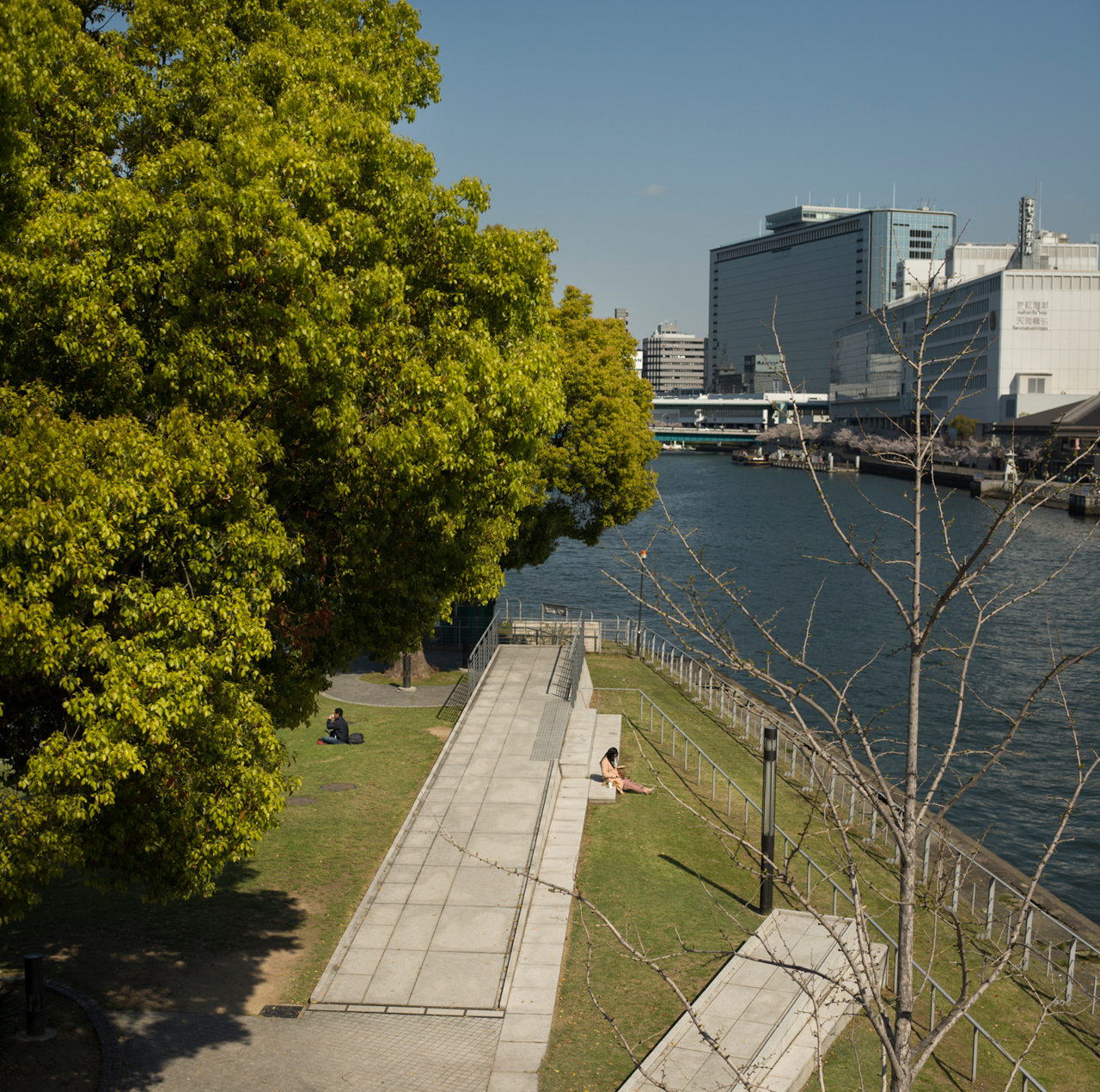
Privately here in our home, coronavirus has meant more time spent cooking—and growing—new foods, sewing and fixing clothes instead of buying them, and working to enjoy the process of finding where we can slow down and be more attentive, to ourselves, to our neighbors, to our environments.
Much of my work as a writer and artist—and my wife as an herbalist—is becoming more virtual. After six months of preparation, an exhibition in Kyoto was canceled just days before we were set to open due to COVID-19. We went ahead virtually instead, substituting an in-person audience for an “online” audience thanks to The Nature of Cities’ new Urban Ecological Arts Forum.
We’re now trying to expand this opportunity, to help more urban artists who are in similarly difficult positions.
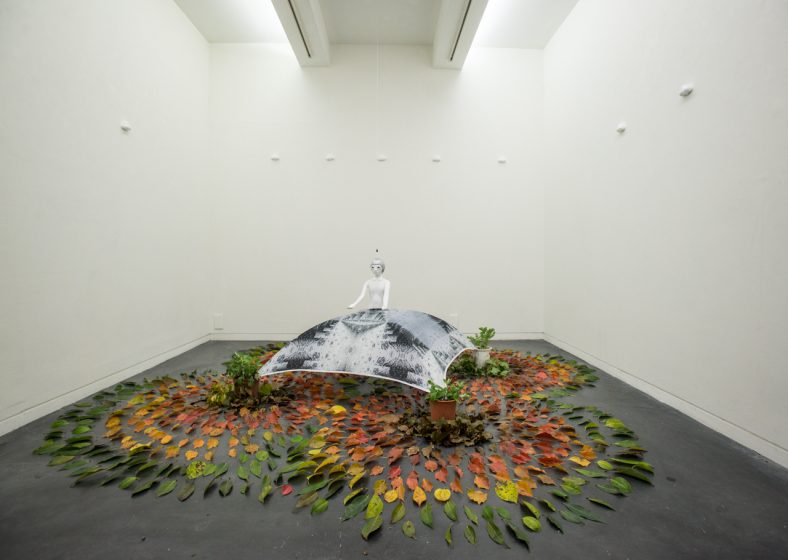
It seems this is a theme across other disciplines too. Helping those in need suddenly becomes the obvious thing to do, when we realize so clearly that all humans, and the entire living world around us, are in need.
It seems many other urban needs are finally being realized at this time, too.
In most industrialized nations, we have been in need of a slowdown, of more time listening to nature, of more urban gardens, of clean air, clean water, and of bringing and end to jobs that degrade the environment and human health. We’ve also been in need of ways to feed and house our fellow mortals—as ecologist Larry Korn liked to say—in ways that support the wellness of all beings.
We’ve needed these things in our cities for a long time.
Now, suddenly, miraculously, seemingly accidentally, so many of these needs are being revealed to us in very potent ways. Outdoor air pollution —which kills over 4 million people every year—is giving way to blue skies that have not been seen for lifetimes, and the same is true for the reduction of urban noise pollution. There are Coronavirus Victory Gardens popping up all around Los Angeles. Tiny homes for homeless are being built in San Jose at rapid pace, and Americans are suddenly listening to birds, and going out into nature in such numbers that authorities don’t know how to handle the new influx of nature lovers.
With these revelations, come some inevitable questions. How do we keep the skies blue, the herons cackling, and the gardens growing, after this is all over?
What will be the new normal?
Perhaps now is our chance to slow down, take care of ourselves and our fellow living beings a bit better, look to nature, and figure it out.
Sarah Charlop-Powers
about the writer
Sarah Charlop-Powers
Sarah Charlop-Powers is the Executive Director of the Natural Areas Conservancy, with a background in land use planning, economics and environmental management.
While we’re all navigating through this extremely stressful—and sometimes downright scary—moment, I can’t imagine what my life, and the lives of all New Yorkers, would be like without our local parks.
While I often speak about these important points, COVID-19 has made them even more significant and real for me personally. In March, as I shed my everyday routine—like my subway commute from Brooklyn to Manhattan; bus rides with my son to preschool; Saturday morning trips to the farmers market, followed by muffins on a park bench and a visit to the local playground—I started feeling as if life in our very dense urban neighborhood was unbearable.
As my wife and I began splitting our days into a relay of childcare and working from home, I started a new daily ritual: visiting natural areas with our three-year-old. I anxiously put on our masks, and as we ride the elevator from the fourteenth floor to the lobby I remind my son not to touch anything. When we arrive at a park and take that first step into the woods, we both exhale. During a recent hike in Pelham Bay Park in the Bronx, we spotted a skunk, a herd of deer, and an eagle catching a fish. In Forest Park in Queens, my son spent 30 minutes throwing sticks into a pond. And in Brooklyn’s Marine Park, we wandered through the park’s shrubby maritime forest and experienced the thrill of exiting the woods onto a smooth beach. Together, we are experiencing the simple pleasures that come from spending time in nature.
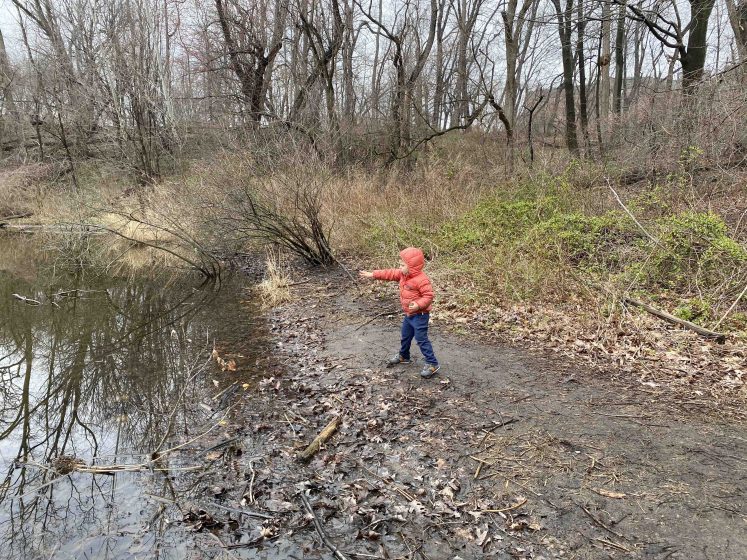 Right now, many families are relying on their local parks for respite, breathing room, and relaxation. With playgrounds and recreational facilities closed, we are seeing increased visitation in our natural areas, not only in New York City, but in cities around the world.
Right now, many families are relying on their local parks for respite, breathing room, and relaxation. With playgrounds and recreational facilities closed, we are seeing increased visitation in our natural areas, not only in New York City, but in cities around the world.
The lines between my personal and professional identities have now blurred. I am experiencing firsthand the importance of local parks and natural areas—not simply in a “nice to have” context, but out of necessity. And while we’re all navigating through this extremely stressful—and sometimes downright scary—moment, I can’t imagine what my life, and the lives of all New Yorkers, would be like without our local parks.
Katrine Claassens
about the writer
Katrine Claassens
Katrine Claassens’ paintings reflect her interest in climate change, urban ecology, and internet memes. She also works as a science, policy and climate change communicator for universities, think tanks, and governments in South Africa and Canada.
The pandemic teaches us this: rapid, coherent change is possible. It has also laid bare that there is much to be actively dismantled, and much to be actively built.
Here in Montreal, my home studio window looks out onto Parc Laurier. With this view, I have been drawn with a cord of tenderness into the intricate politics of neighbourhood cats, the love between a chickadee couple, the diligent industry of iridescent black birds nesting in a nearby tree, the aesthetically pleasing daily walk of the man in the red coat with the dalmatian, and the ceaseless antics of the squirrels.
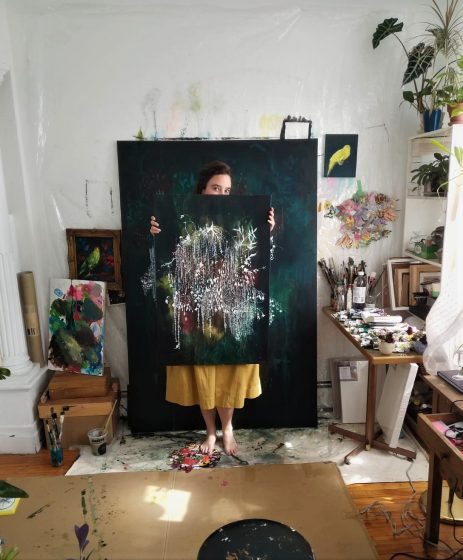 This year has been one of partings without end: one billion animals dead in the Australian fires, swarms of locusts in Africa on a scale never seen in living memory, mass bleaching of the coral reefs, the warmest January on record. And now, with COVID-19, partings of a different kind, that rob us nonetheless of the same precious thing: of life and of a map for the future.
This year has been one of partings without end: one billion animals dead in the Australian fires, swarms of locusts in Africa on a scale never seen in living memory, mass bleaching of the coral reefs, the warmest January on record. And now, with COVID-19, partings of a different kind, that rob us nonetheless of the same precious thing: of life and of a map for the future.
In this context of extreme ecological collapse and human despair, I have found some comfort in the stories of nature “rebounding” as documented by locked-down urban residents from their windows around the world. Shy but adventurous wild boars, coyotes, and deer wandering the empty streets; skies clearing to reveal faraway mountain ranges not seen from industrial cities in a lifetime; the canal waters of Venice almost crystalline (with rumours of dolphins!). It is breathtaking, the sudden clarity, the speed, the utter brilliance of the blue, and green, and the rough fur of the wild against our city surfaces.
And these visions of a different world are a powerful thing. While COVID-19 restrictions are unlikely to meaningfully move the needle on climate change and its attendant horrors, these stories offer a peephole to another kind of city. One that is wilder, one that is allowed to go to seed, one with cleaner water and skies. Once you have seen the mountains, you will know to miss them.
And through this eyelet of possibility comes a lesson, a warning, a flare. The pandemic teaches us this: rapid, coherent change is possible. It has also laid bare that there is much to be actively dismantled, and much to be actively built. For guidance on how to do this we can ask the questions that a gardener asks at the time when seasons change. What will we bury, and put to sleep? What seeds will we save? When will it be safe to sow? What wild seeds have travelled to our soil on the wind, and lie dormant waiting to be weeded or to delight?
Down in the park, I found the body of a young squirrel, small and sleek, under a tree. I marked its place with the most ancient of human writing, pushing sticks into the frozen ground, setting a circle of stones around it. An act to bear witness to life at a time when life seems so worth witnessing, and as a call for dog walkers and gentle children to observe the perfection of its paws and the almond shape of its closed eyes.
Cecilia Herzog
about the writer
Cecilia Herzog
Cecilia Polacow Herzog is an urban landscape planner, retired professor at the Pontifical Catholic University of Rio de Janeiro. She is an activist, being one of the pioneers to advocate to apply science into real urban planning, projects, and interventions to increase biodiversity and ecosystem services in Brazilian cities.
I am investing my time in isolation to improve my capacity to contribute to a wide discussion about urban nature, how it is important to sustain healthy lives and adapt to the ever-growing threat of extreme weather events.
I am being transformed by this sudden tragic pandemic that is affecting the whole of humanity. I am lucky to have a beautiful place in the countryside to be during this period of retreat. I have more questions than statements up to now. How will I go back to a new “normal” life? How long will take until I will be able to hug my granddaughters? My kids… Will I be able to be with my mother again? Those questions are on my mind every day, all day long.
I believe this is a life-changing event. When we lose the abstract confidence that life will go on forever in the same way, deep changes occur. Now I praise living more than ever. I miss my loved ones and fear for their lives. I miss my work, my colleagues, my presential classes, and so many other ‘normal’ activities I used to have.
I am eager to meet people, especially my family and friends, peers, students… I want to travel to be with my kids and grandkids. I also want to attend conferences and other events when my friends from other places get together. I value and long for presence: look in the eyes, be able to hug and laugh, sense the pleasure of having made friends from different cultures and meet them.
Life and human relations are the most important things for me.
Transformation. I have written a lot about urban transformation, and now in social distancing I have been wondering how this crisis will change cities and people’s minds.
Will our societies wake up for the immense challenges we face: growing social inequalities, climate change, loss of biodiversity and other threatening life disruptions?
I am interested in knowing how people will come out after a long period of isolation, mainly who live in apartments without contact with nature. Parks and squares will be there, and I believe people will praise common green spaces more than ever before. As I work with urban landscapes, my thoughts are about what will happen to them. Will they become more important and valued by people and decision makers? Once economic losses are affecting most of urban dwellers, what kind of low-cost experiences they will demand? How people will interact in urban spaces? What kind of open spaces will bloom to help societies recover from this traumatic period?
I am investing my time in isolation to improve my capacity to contribute to a wide discussion about urban nature, how it is important to sustain healthy lives and adapt to the ever-growing threat of extreme weather events. I believe nature-based solutions are the response to enhance our adaptive capacity and social justice. I am prepared to stay away for a long period of time before I will be able to restart a new “normal” life and face new challenges in the city. Let nature be the solution to heal us all.
Christine Thuring
about the writer
Christine Thuring
Christine Thuring is a plant ecologist who integrates her love of life into creative collaborations and educational dialogues. While her expertise is expressed particularly in the built environment (green roofs, living walls, habitat gardens), she is passionately practical and enjoys restoring peatlands, mentoring students, leading interpretive walks, and advocating sustainable and healthy lifestyles.
I’m contemplating alternative and new ways by which to engage my energy, expertise,, and love for the world. It is a bit of an existential place, which enlists the whole range of my creative and scientific faculties. If this is the new normal, where “business as usual” no longer applies, then how do I wish to contribute?
Personally and professionally, COVID-19 has changed my life in various ways. I’m growing food and traveling less. I’m teaching online, which has actually been a big deal. I’ve always enjoyed teaching, but now I’m not so sure anymore. Maybe the “virtual classroom” will grow on me, I don’t know. The 2-dimensional quality gives a limited sense of connection with my students, and I’ve been quite stressed by the massive prep time required and the steep learning curve.
Meantime, I’m contemplating alternative and new ways by which to engage my energy, expertise, and love for the world. It is a bit of an existential place, which enlists the whole range of my creative and scientific faculties. If this is the new normal, where “business as usual” no longer applies, then how do I wish to contribute?
Do I stay with what I’ve been doing, teaching and advocating for ecological green infrastructure? Do I start up a new enterprise, to help re-build up the economy and the ecology? The latter idea is inspired by that aspect of the Great Depression in which governments created employment schemes to get some of the population working on public projects, like building infrastructure. In this moment in time, much work needs to be done on creating climate jobs, building resilience, transitioning to post-carbon society, getting off pesticides, restoring degraded habitats, etc. Another contemplation is whether I should get into politics, and serve as a vocal force for good. I want to see an end to perverse subsidies (e.g., industries of war, fossil fuels) and for those funds to be transferred towards life-affirming industries (e.g., renewable energy, organic agriculture, small business). I imagine that the latter are like small trees in a forest, waiting for the big trees to fall. Perhaps this pandemic is the equivalent of some big trees falling, creating a gap in the canopy, and now those alternative industries can get their share of the sunlight and move into the mainstream.
The tragedies of the pandemic are inconsolable, and much gratitude is owed to the small and large acts of kindness everyday. Whether this virus’ effect becomes that of a Plague remains to be seen. At the very least, it has created a space for us to slow down. Recalling the debate, Kingdoms Fungi and Bacteria will always reign supreme. The big question is whether Homo sapiens can organise itself in line with the precautionary principle.
Mitch Pavao-Zuckerman
about the writer
Mitchell Pavao-Zuckerman
Dr. Mitchell Pavao-Zuckerman is an Associate Professor at the University of Maryland. He is an ecologist studying the interactions of decision making, design, and environmental change on ecosystem processes in urban landscapes.
Not all of our students have the desire to learn online, and not all have the resources to do so. There is talk about how the new normal will impact university budgets and student enrollments. This experience is teaching many about the real lives and experiences of our students, and we need to be sure that any transformations in the new normal reflect on inequities in access to time, technology, and privacy.
Six weeks later, we’ve all experienced the challenges of teaching online—how much more time it takes, the drain of using Zoom, and the disconnection we have if we aren’t able to use technology to connect directly with students. The relative stability of campus life has dissolved for many students as they cope with the need to find jobs to help parents who are newly unemployed, care for sick family members, and the lack of internet and computers to connect with online courses. It is clear though; our students are hungry for the opportunity to engage and to help make a difference within our local communities. How can this transformative moment support this hunger?
At my university we talk a lot about the “land grant mission”—that research and education should be linked to improve communities and the environment—but that mission is not integrated well into the classroom. As we plan for the new normal, we are anticipating remaining online to some degree for the near future. We are looking for ways to modify internships and capstone experiences to fit a distance education format. We seek to transform these experiences so that students can problem solve and gain service-learning experiences in addition to professional development and research skills. If we succeed in bringing this land-grant model into online courses, this is a transformation that we need to maintain once we are back in the classroom.
Not all of our students have the desire to learn online, and not all have the resources to do so. There is talk about how the new normal will impact university budgets and student enrollments. This experience is teaching many about the real lives and experiences of our students, and we need to be sure that any transformations in the new normal reflect on inequities in access to time, technology, and privacy.
Personally, I’m still figuring out the new normal, but one thing COVID is teaching me is about the illusion of time. In some ways, we seem to have more of it: spending time with old friends across the country playing virtual games and listening to music, baking, taking long daily walks, and watching our kids explore along the streams in our neighborhood. This time to connect has been a welcome source of joy and normalcy. Post-virus, I hope these transformations stick for the better too.
Diana Wiesner
about the writer
Diana Wiesner
Diana Wiesner, activist, architect, and landscape designer based in Bogotá, is recognized for her leadership in socio-ecological issues and innovative approaches to urban ecology and landscape architecture. Founder of her own practice and director of Fundación Cerros de Bogotá, she promotes environmental awareness, citizen participation, and preservation of natural systems.
We are the birds that make up their nest with everything they find: branches, bark, feathers, leaves, hair, and even strands of wool, any material to protect the essential: creatively reinventing what will emerge from this process of caring for the global nest.
TIME OF NESTING: Praise to the care of the other
We can imagine various scales of nests, of ways of housing, of inhabiting. From the constructions of the insects, to the planet nesting in the inhabited universe. This strange period, during which we live within a micro shelter, makes us understand the termite nest, the bird’s nest, and the social system of many forms of life. Some keep their social group, as it happens with bees or ants. Insects make their homes as protection for their offspring because they are delicate and in their immature stages need it. Thus, we are seeing ourselves in a global fabric of shared feelings and uncertainty. The nest contains the process of what is brewing inside it. Inside the social group, or the being itself. We are not even clear about what form that which is evolving is going to take.
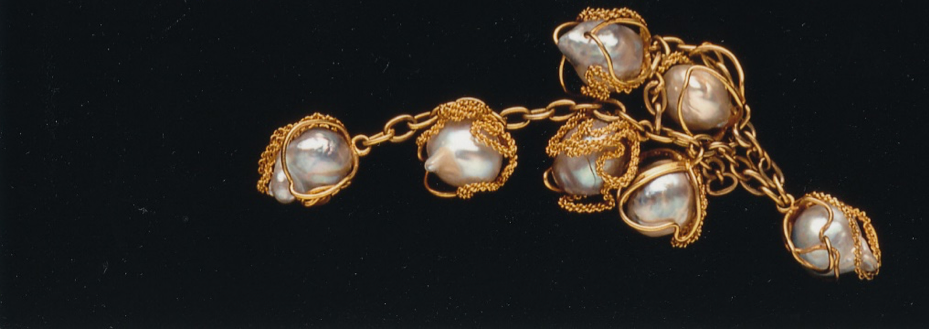
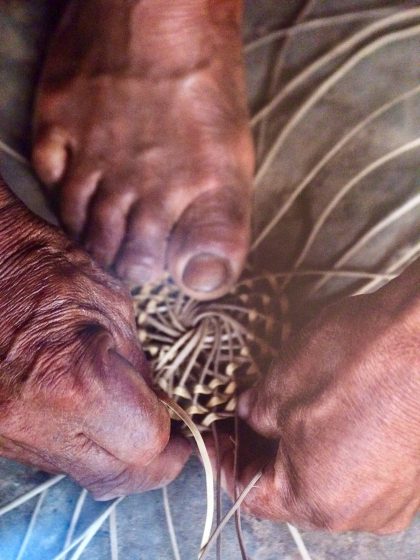
Bogota, a tropical megacity now led by an exceptional, gay woman, full of energy and enthusiasm, has managed to orient the supportive citizenry towards the self-care and care of the elders and the most vulnerable. In this period of another speed of perception and reality, where both in Bogota and in the other cities of Colombia development plans are being reconciled, the pandemic gives us an opportunity to rethink the ways of planning cities and territories. These plans will surely adjust to the new priorities that are being developed in the minds, of each individual, family niche, and social group: to take care of the other is to take care of any manifestation of life. Participation and action take a priority role.
The world reacts to the ways of being connected and understanding that we function as a system and we must remain and decide together. Nesting has given us new time to relate, to slow down, to be more observant and to have a thought tied to the speed of the ancestral steps and paths. This vital interconnection is evident in networks: the world sings simultaneously. The neighbors integrate in gestures of solidarity and talk between balconies. This period, where the desire for the green becomes the great opportunity for those of us who have dreamed for years that the order would dance to the rhythm of the water and the soil. The public and mental health, which has finally taken relevance as never before, show the importance for each human being to feel their own breath walking in a place that privileges nature.
In the case of Bogota, we hope that this will happen.
Ecology and economy are coming closer than ever, the era of valuing what is really productive has begun.
Nesting from our homes of introspection, we feel this great universal connection that will derive in new forms of education in a great global conversation.
In this period we have created and are perfecting the channels to have this great conversation. This pandemic has opened a crack for consensus among all global inhabitants. In this crack, citizen actions are already flourishing: consumption from local producers, strengthened solidarity and support networks, questioning of traditional pedagogical methods, forms of citizen participation, and valuing the essence of the inner nest.
We are the birds that make up their nest with everything they find: branches, bark, feathers, leaves, hair, and even strands of wool, any material to protect the essential: creatively reinventing what will emerge from this process of caring for the global nest.
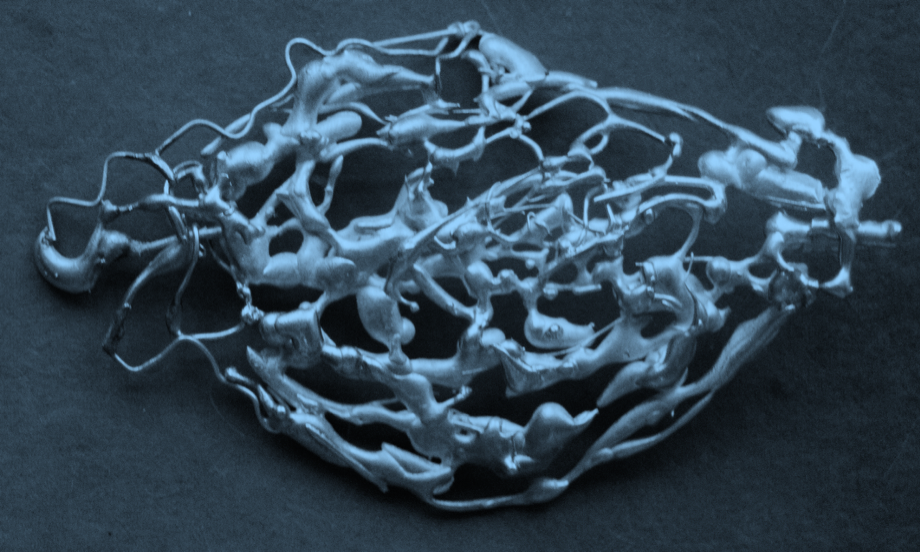
* * *
TIEMPOS DE ANIDAMIENTO: Elogio al cuidado del otro
Somos las aves que componen su nido con todo lo que encuentran: ramas, cortezas, plumas, hojas, pelos, y hasta hebras de lana, cualquier material para proteger lo esencial: reinventando creativamente lo que va a emerger de este proceso de cuidar el nido global.
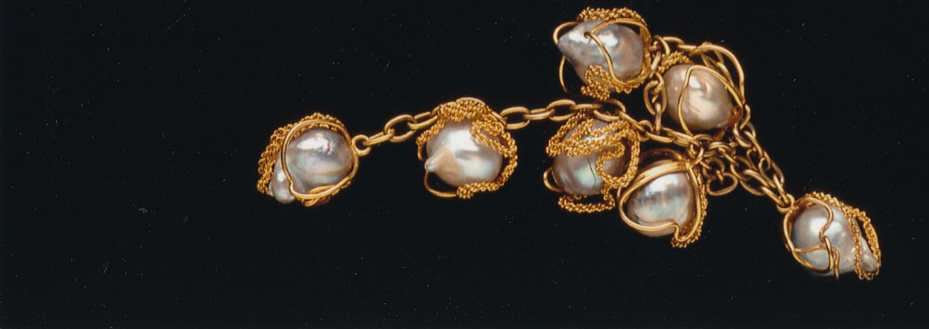

Bogotá, una mega ciudad tropical recientemente liderada por una excepcional mujer gay, llena de energía y entusiasmo, ha logrado orientar a la ciudadanía solidaria hacia el autocuidado y el cuidado del abuelo y del más vulnerable. En este período de otra velocidad de percepción y de realidad, en donde tanto en Bogotá y como en las demás las ciudades de Colombia se están conciliando los planes de desarrollo, la pandemia nos da una oportunidad de replantear las formas de planear las ciudades y los territorios. Estos planes seguramente se ajustaran a las nuevas prioridades que se gestan en las cabezas de cada individuo, nicho familiar y grupo social: cuidar del otro, es cuidar cualquier manifestación de vida. La participación y la acción toman un papel prioritario. El mundo reacciona respecto a las formas de estar conectados y entender que funcionamos como sistema y debemos permanecer y decidir juntos. La anidación nos ha dado nuevos tiempos de relacionarnos, en ir más despacio, ser más observadores y tener un pensamiento atado a la velocidad de los pasos y caminos ancestrales. Esa interconexión vital se evidencia en las redes: el mundo canta en simultáneo. Los vecinos se integran en gestos solidarios y conversan entre balcones. Este periodo, donde el deseo por lo verde se convierte en la gran oportunidad para quienes soñamos desde años que el ordenamiento baile con el ritmo del agua y del suelo. La salud pública y mental, que por fin ha tomado relevancia como nunca, evidencian la importancia para cada ser humano a sentir su propia respiración caminando en un lugar que privilegie a la naturaleza. En el caso bogotano esperamos que suceda.
La ecología y la economía se acercan como nunca, se inicia la era de valorar lo realmente productivo.
Anidando desde nuestros hogares de introspección, sentimos esta gran conexión universal que derivará en nuevas formas de educación en una gran conversación global.
En este periodo hemos creado y perfeccionado los canales para tener esta gran conversación. Esta pandemia ha abierto la grieta para consensuar entre todos los habitantes globales. En esta grieta ya están floreciendo acciones ciudadanas: consumo a productores locales, redes de solidaridad y apoyo fortalecidas, cuestionamiento a métodos tradicionales pedagógicos, formas de participación ciudadanas y valoración a lo esencial del nido interior.
Somos las aves que componen su nido con todo lo que encuentran: ramas, cortezas, plumas, hojas, pelos, y hasta hebras de lana, cualquier material para proteger lo esencial: reinventando creativamente lo que va a emerger de este proceso de cuidar el nido global.
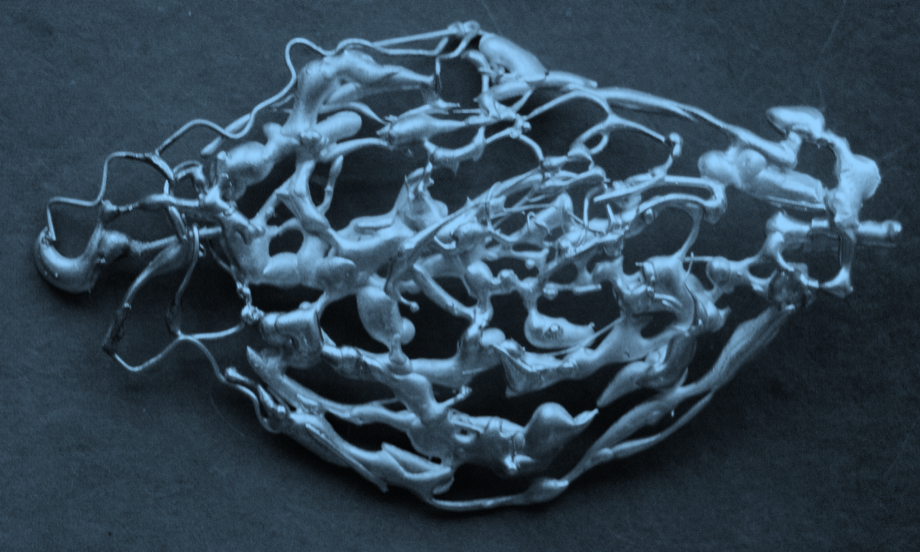
Eduardo Guerrero
about the writer
Eduardo Guerrero
Eduardo Guerrero is a biologist with over 20 years of experience in projects and initiatives involving environmental and sustainable development issues in Colombia and other South American countries.
The dilemma for a healthy planet is not: nature or people? The right approach must be people in nature, planning, and building resilient cities following ecological principles. Quoting Garcia Márquez: “I believe it’s not too late to build a utopia that allows us to share an Earth on which solidarity could become a reality”.
Global crises as COVID-19 remind us that our cities are intrinsically part of nature, not only social and economically interconnected, but also part of ecologic corridors. So, in addition to social, health, and economic measures, solutions should be also nature-based.
From politics and economic perspectives, we human beings pretend to be apart from nature but, we ourselves, our economic models and our cities are functionally part of nature. If you prefer let’s call urban areas “transformed nature”.
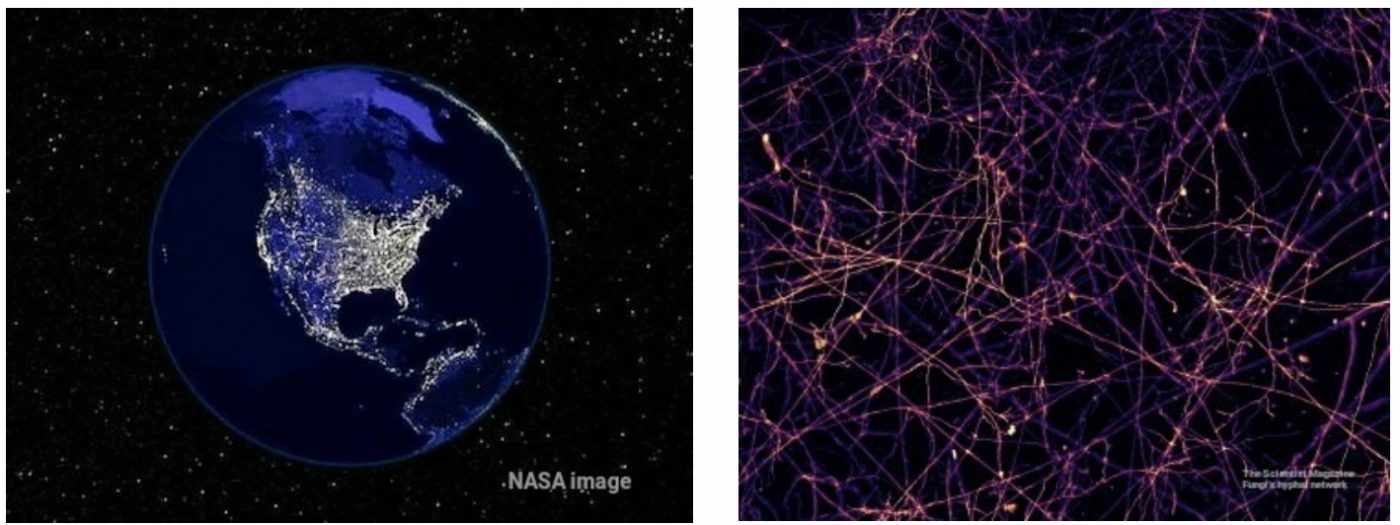
Condominiums are like honeycombs or coral reefs; highways seem like a school of fish and our social networks resemble the fungal mycelia which are like a natural internet.
We are nature for good, not for bad. The problem is not to be a social animal that evolves by building an interconnected global society. The problem is acting as if nature is something alien to us instead being part of us. The problem is the air contamination and particulate material that causes cardiopulmonary diseases and facilitates virus dissemination. The problem is the illegal traffic of wild fauna and their habitat fragmentation which disrupt ecological balance and allows the zoonotic transmission of a virus from a wild animal to people.
The new coronavirus emergency has moved humanity to feel united in diversity and, at the same time, has obliged leaders and governments to make synergic decisions relating economy and human health.
Under this crisis, links between human health and environment have emerged more clearly than ever before. Biodiversity loss, climate change, and COVID-19 challenge humanity in similar manners. They are not just themes under a single-sector responsibility, not unidimensional problems assigned in a simplistic way to Environment or Health Secretaries. They are multidimensional and complex matters which require comprehensive approaches.
I hope government and corporate leaders will no longer act according to false dichotomies like economy vs social well-being or economy vs environment.
As many under this crisis, I feel anxious, expectant and concerned and, at the same time, I feel motivated and optimistic about the opportunities and challenges we face.
I imagine a post-COVID world in which human relationships are less physical in terms of contacts but emotionally closer with more real solidarity. I imagine a post-COVID stage in which nature is organically integrated into urban planning, not just as a “must be”, but as a “all of us appreciate it and want to”.
The dilemma for a healthy planet is not: nature or people? The right approach must be people in nature, planning, and building resilient cities following ecological principles.
The global crisis of COVID-19 poses a challenge to the dense and compact city model. However, the solution cannot be a radical change in urban development models, but the development of tools, redesigns and environmental adaptations that contribute to preventing, controlling and mitigating public health threats.
Many actions for a healthy urban environment are at the same time good practices for a healthy population to prevent and/or mitigate epidemics and other public health threats. Landscape architects and ecologists must talk and work together, as must economists, biologists and health professionals.
So, an effective management of post-COVID emergency will require integrative nature-based solutions.
We can develop approaches such as the following:
- Sanitary safe access to green public space. Adaptation and / or redesign of public space, in order to generate functional, spatial and / or temporal isolation in the access of citizens.
- Redesign and adjustment of green infrastructure, to reduce the risks of contagion.
- Trees cleaning air contamination. Green areas and trees that capture particulate matter and generate wind tunnels to dissipate it.
- Urban mobility solutions, strengthened of bike networks and rationalization of public transport.
- Sustainable and sanitary consumption of green and local products. Involves the development of biosecurity measures for productive and commercial activities associated with the circular economy, green businesses (bio-commerce, urban ecotourism, etc.) and urban agriculture.
- Urban forest restoration.
Today more than ever the challenge is to achieve economic, social, and ecological transitions towards sustainability, equity, and health.
Quoting Garcia Márquez: “I believe it’s not too late to build a utopia that allows us to share an Earth on which solidarity could become a reality”.
Mike Houck
about the writer
Mike Houck
Mike Houck, co-founder of TNOC engages urban nature conservation, land use planning, green infrastructure advocacy. He founded the Urban Greenspaces Institute whose motto is “In Livable Cities is Preservation of the Wild” reflecting the belief that without creating livable and loveable cities it will be impossible to protect “pristine” areas outside the city. To be livable and loveable people must have access to nature where they live, work and play. He co-edited Wild in the City, A Guide to Portland’s Natural Areas (2000) and Wild in the City, Exploring The Intertwine (2011) and The Routledge Handbook of Urban Ecology (2011).
I will spend more time, personally and professionally, focusing on the green interstices of our city, the small, often scrappy, bits of nature nearby for my own psychological and physical health, and that of my city.
Coming out of Covid-19 more robust psychologically and physically, individually and societally, I believe, will depend in large measure on access to nearby nature.
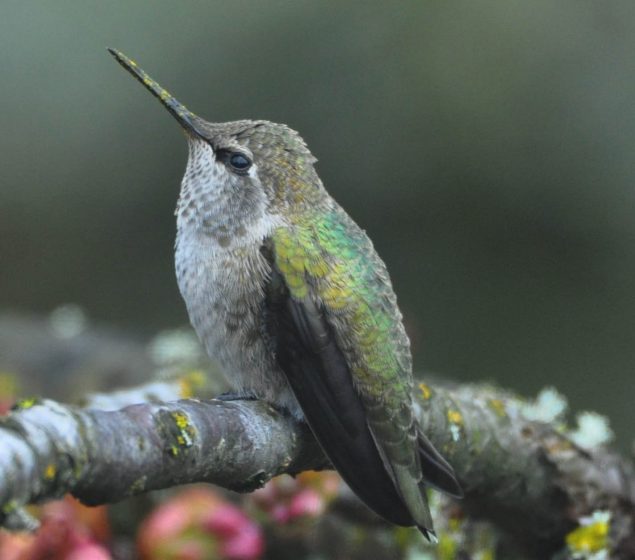 I have seen myriad online accounts of people’s interactions with nature from their apartments and nearby parks and natural areas and trails. I have had many of my own intimate experiences with nature nearby since being in lock-down. Recently, I happened to glance out of my living room window and noticed the cherry blossoms had just burst out, a profusion of pink filling the entire scene. Then a rapid, zig-zagging movement caught my eye as a female Anna’s hummingbird lit on a nearby branch. I managed to snap her image, her pollen-specked bill titled skyward. Was she looking for a predator or her territory obsessed mate? The pink blossoms and emerald-green avian buzz-bomb, calmed me, energized me, and I have no doubt left me healthier and happier for the rest of the day.
I have seen myriad online accounts of people’s interactions with nature from their apartments and nearby parks and natural areas and trails. I have had many of my own intimate experiences with nature nearby since being in lock-down. Recently, I happened to glance out of my living room window and noticed the cherry blossoms had just burst out, a profusion of pink filling the entire scene. Then a rapid, zig-zagging movement caught my eye as a female Anna’s hummingbird lit on a nearby branch. I managed to snap her image, her pollen-specked bill titled skyward. Was she looking for a predator or her territory obsessed mate? The pink blossoms and emerald-green avian buzz-bomb, calmed me, energized me, and I have no doubt left me healthier and happier for the rest of the day. 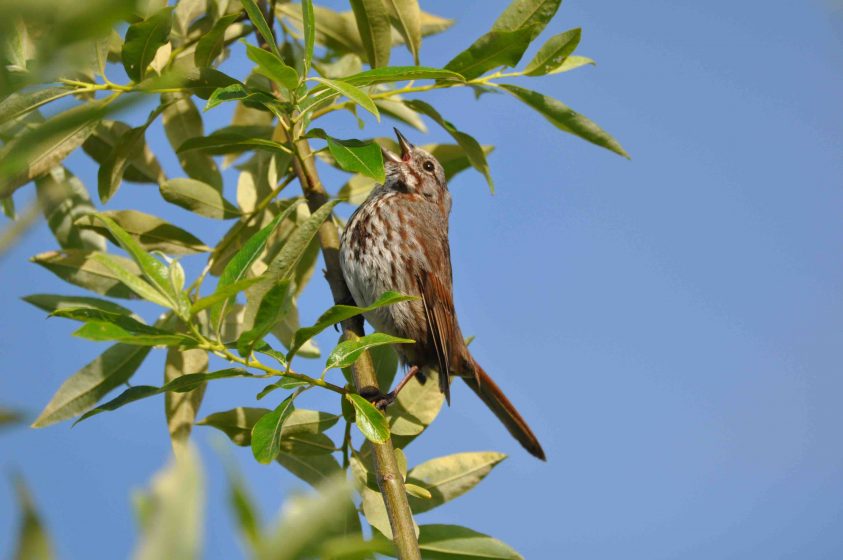
Not long ago while standing next to our newly installed rain garden I encountered a song sparrow perched next to our “backyard habitat” sign. That song sparrow has become my daily COVID-19 buddy. Each morning I stand next to him, much too close for proper “social distancing,” as he tilts back his head, puffs out his chest, and belts out a beautiful, full-throated melody. I imitate him; he sings back, looking me in the eye I sing again; he flutters both wings, much as young birds do when begging their parents for food. We’ve connected; we continue our “dialogue” for several minutes after which I walk off, convinced we are both the better for the encounter. I often glance down from my second story flat to see a mother with her kids pointing at the song sparrow who’s perfectly happy to sing for anyone willing to take notice of him at the rain garden’s edge.
Scenes like this are repeated all over the city where small patches of greenspaces have been saved or woven into the urban fabric. Both personally and professionally I will spend more time focusing on the green interstices of our city, the small, often scrappy, bits of nature nearby for my own psychological and physical health, and that of my city.
M’Lisa Colbert
about the writer
M'Lisa Colbert
M’Lisa Lee Colbert is a social scientist, and an urban farmer. She is currently working to improve access to locally grown produce year-round at an affordable price, in Montreal.
I am confronted with how much I need trees, grass, and fresh air to remain a sane human being. Being stuck between the four walls of my apartment all day feels foreign and unnatural.
My best friend sent me a GIF from Venezuela that asks of the rest of the world: “Oh, rationing, first time?”
It also makes me think about arguments I’ve made for increasing density in cities. Let’s build up. But how much do we build? And where? Is there a point where it because unsafe? I live in an area of Montreal that is food poor. They built condos, and leased main strip commercial space to expensive restaurants and boutique clothing stores to build out marketing campaigns for realtors that raised housing prices, but groceries stores and other practical services are scarce. This is ordinarily a heavily contested urban planning problem we argue about in our community, but the pandemic is highlighting just how critical it is, and will be for the future, to mix public services and access to diverse services in each borough in a city.
Mostly though, I am confronted with how much I need trees, grass, and fresh air to remain a sane human being. Being stuck between the four walls of my apartment all day feels foreign and unnatural. If this isn’t a stark reminder of just how much a part of nature humans are, I am not sure anything will push us to remember. I remain hopeful though, that this just might be the thing to do it.
Todd Forrest
about the writer
Todd Forest
Todd Forrest is Arthur Ross Vice President for Horticulture and Living Collections at The New York Botanical Garden. He oversees the team of managers, horticulturists, and curators who steward the Garden’s plant collections, natural areas, gardens, and glasshouses and has been a leader in the development of the Garden’s celebrated program of interdisciplinary exhibitions.
A garden feels empty and pointless without people to enjoy it. So does nature. While I have always felt strongly about the importance of nature to a person’s well-being, I have never been so keenly aware of the essential partnership people have with the natural world.
Not long ago an accountant friend gleefully told me about an article he had read claiming that accountant and horticulturist are professions attractive to misanthropes. Knowing us both, it made sense to me. Each of us tends toward the gloomily irascible and neither of us would be the first person you would invite to a dinner party if you wanted to cultivate a fun, chatty vibe.
I didn’t consciously choose a career in horticulture because of its apparent appeal to grumpy people—I was fortunate to follow my lifelong passion for nature into the world of plants. Ironically, perhaps, given what my chosen profession says about me, I have spent nearly my entire career at The New York Botanical Garden (NYBG), an institution founded in 1891 to educate, delight, and serve people.
But when my friend shared this observation, I thought a bit and realized that most public horticulturists I know do spend maybe a little too much time grousing about the sins an oblivious public delivers upon their beloved plants. Footprints in flower beds, bouquets of pilfered peonies, branches broken by would-be Tarzans. The tragedy of the commons! The only negative aspect about public gardens, a colleague once cracked, is the public.
But what is a garden if not a distillation of nature’s miracles organized just so for the enjoyment of people? People are not an imposition on a garden, they are its raison d’être. If I suspected this all along, the past six weeks at NYBG have proved it true. As a beautiful spring has unfolded in the eerie emptiness of pandemic New York, this magnificent place, which generations of gardeners have cultivated in partnership with nature for the benefit of the public, feels only half alive. Yes, there aren’t any footprints in the flower beds, but neither are there exclamations of amazement and wonder. This garden needs people just as much as people need this garden.
A garden feels empty and pointless without people to enjoy it. So does nature. While I have always felt strongly about the importance of nature to a person’s well-being, I have never been so keenly aware of the essential partnership people have with the natural world. We struggle to preserve nature; we thrill in revealing nature’s complexities; we delight in sharing nature’s beauty with others. We do this not for sake of nature, but for the benefit of humanity.
A now-questioning misanthrope, I look forward to seeing visitors here at NYBG soon so that the NYBG I love will feel whole again. I hope that those whose lives have been turned upside down by the pandemic will find some joy and solace here when they are allowed to return. I hope that once we have had a chance to put our lives and the lives of our loved ones in order, we will rededicate ourselves to nurturing our partnership with nature for the good of all.
Pippin Anderson
about the writer
Pippin Anderson
Pippin Anderson, a lecturer at the University of Cape Town, is an African urban ecologist who enjoys the untidiness of cities where society and nature must thrive together. FULL BIO
The differences in the lives of our students is stark. With everybody heading home for lock down, the somewhat levelling experience of a shared campus has gone like Cinderella’s carriage at midnight. Some get to leave the ball as they arrived, and others are left with pumpkins and rats.
Professionally I have been moving all my teaching and supervision engagements to online platforms. This is a novel, and rather fun challenge in it is most basic form. I am not technologically savvy and have been on some steep learning curves. Less cheering is navigating paths with students who do not have access to internet services or devices or live in circumstances that preclude participating. The differences in the lives of our students is stark. With everybody heading home for lock down, the somewhat levelling experience of a shared campus has gone like Cinderella’s carriage at midnight. Some get to leave the ball as they arrived, and others are left with pumpkins and rats. The route ahead for these students through their degrees is at best difficult, but most likely devastating. This harsh reminder of the true South Africa, one of such gross inequity, is certainly reason to pause for thought. This is something to be tackled with greater conviction into the future. I hope the second half of this sentence has healing, and optimism.
To be at home in lock down with my family has been a pleasure. My husband is a delightful office companion, and my children drift into our office to chat, share an idea (did you know Genghis Khan has 16 million male offspring?), or to ask a question (can I tie-dye the bedsheets?) and then bumble off to get on with school work (we hope). Lunches have a holiday atmosphere of bread and cheese in the sun. I have had the time to notice the daily passage of light through my house at this time of year. Like other parts of the world with the muted city we hear birds as we never have before. I am aware this is not everyone’s experience of being home in lockdown and count myself lucky. It’s most certainly a pause, and one to be relished. We all know what lies ahead will be difficult to navigate. This brief time however will give us happy memories and familial resilience. We are certainly drawing breath for what is to come.
I hope the second half of my sentence will be slower, more thoughtful, and less cluttered than the first half. I hope it has resolution in it, healing, and optimism


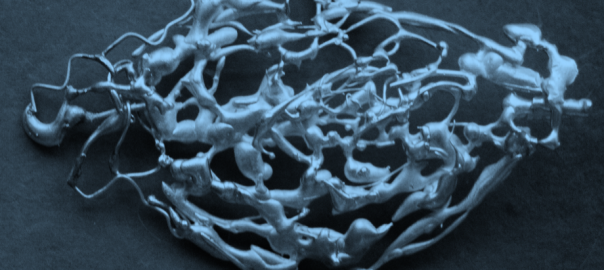
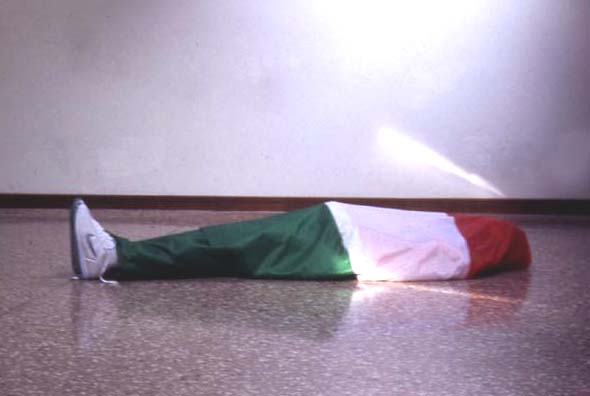
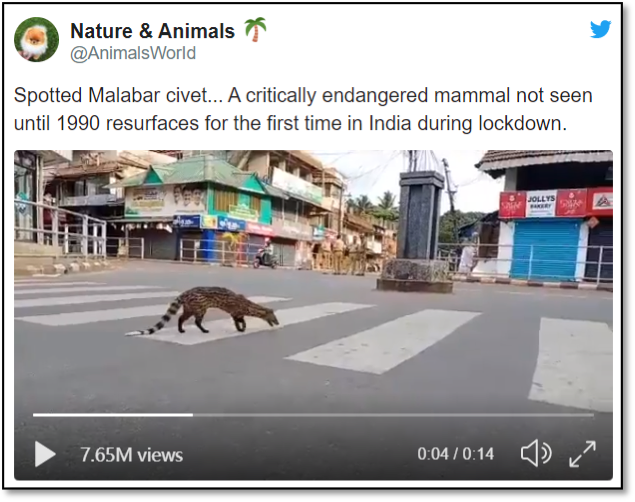
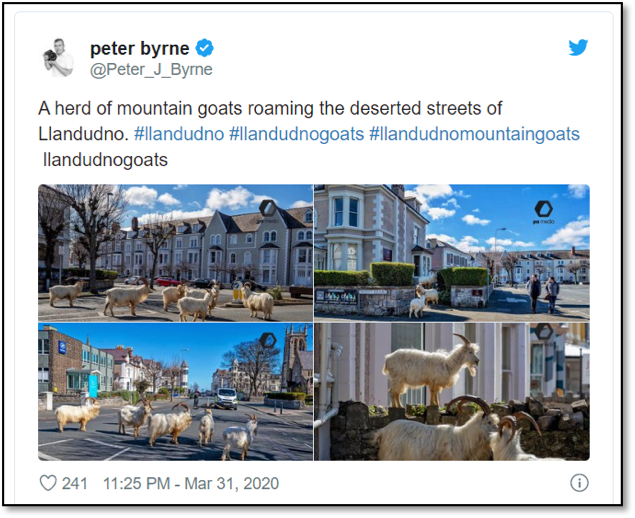
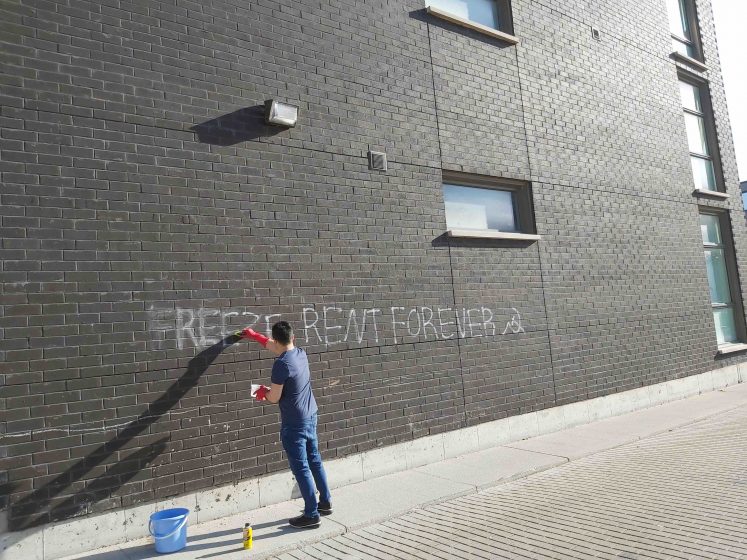
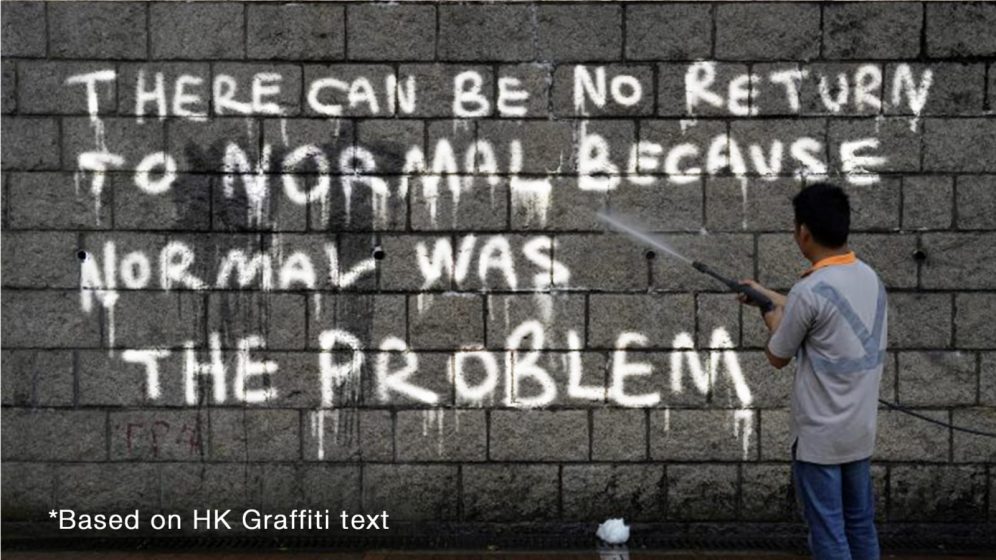
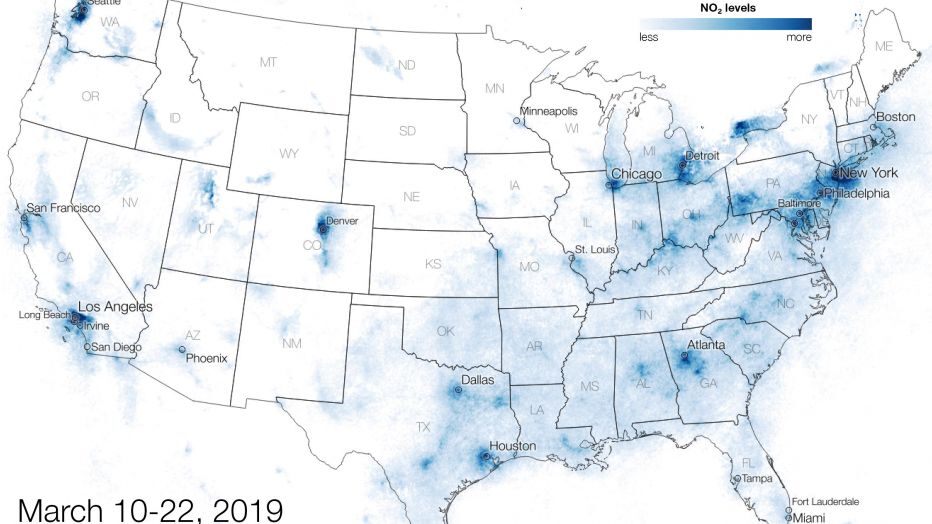
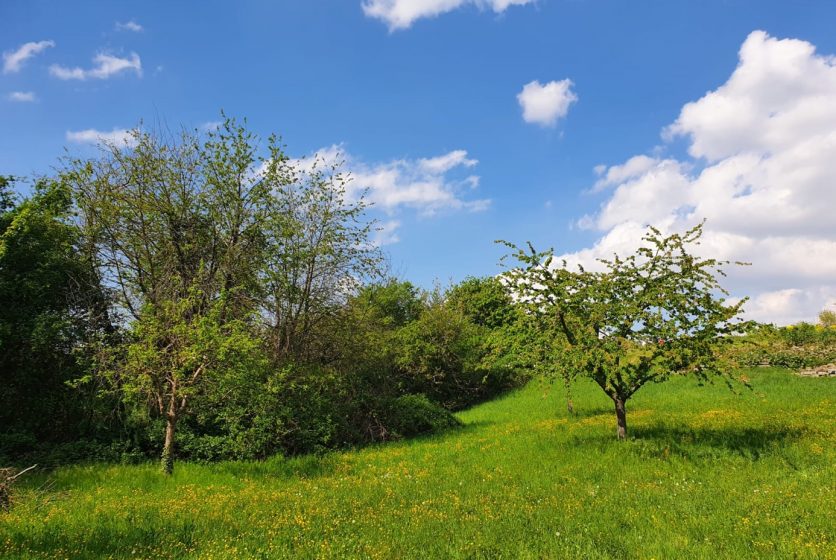
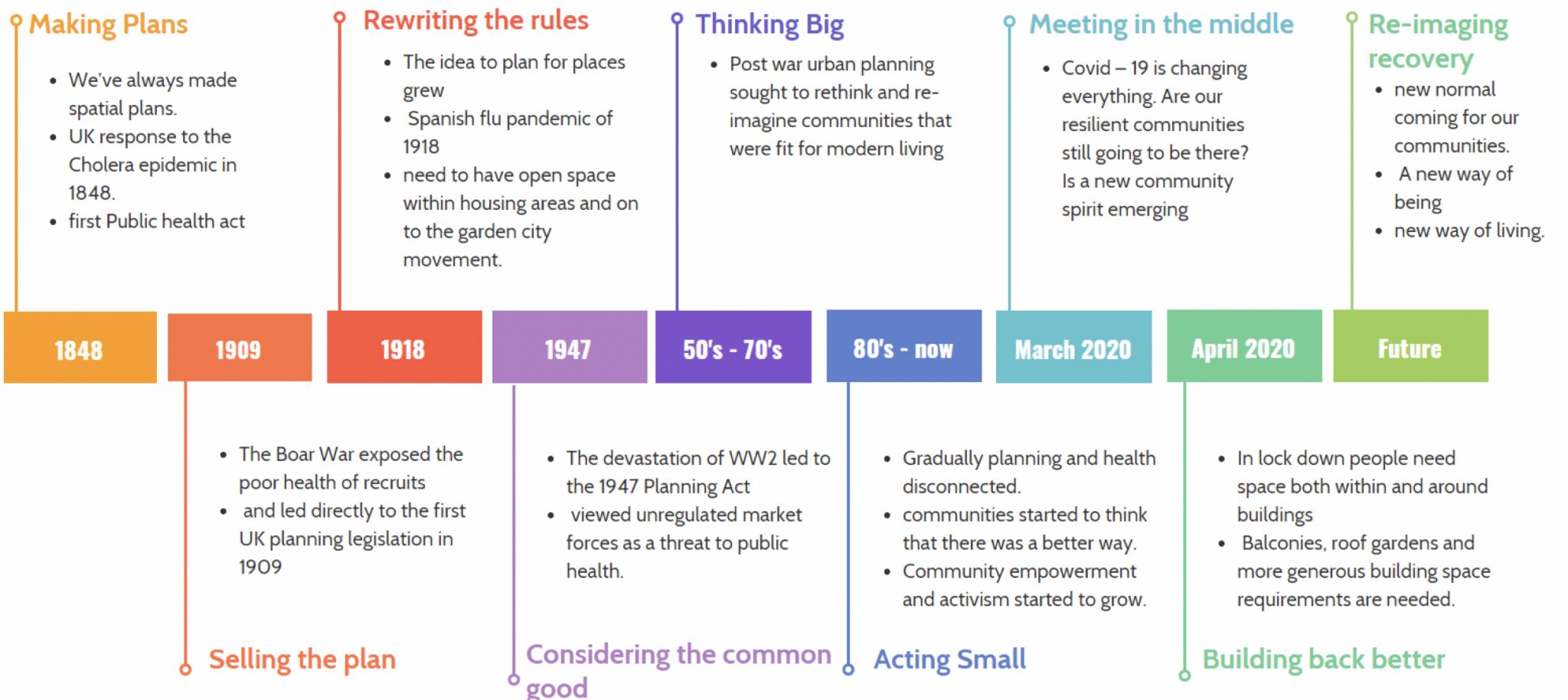
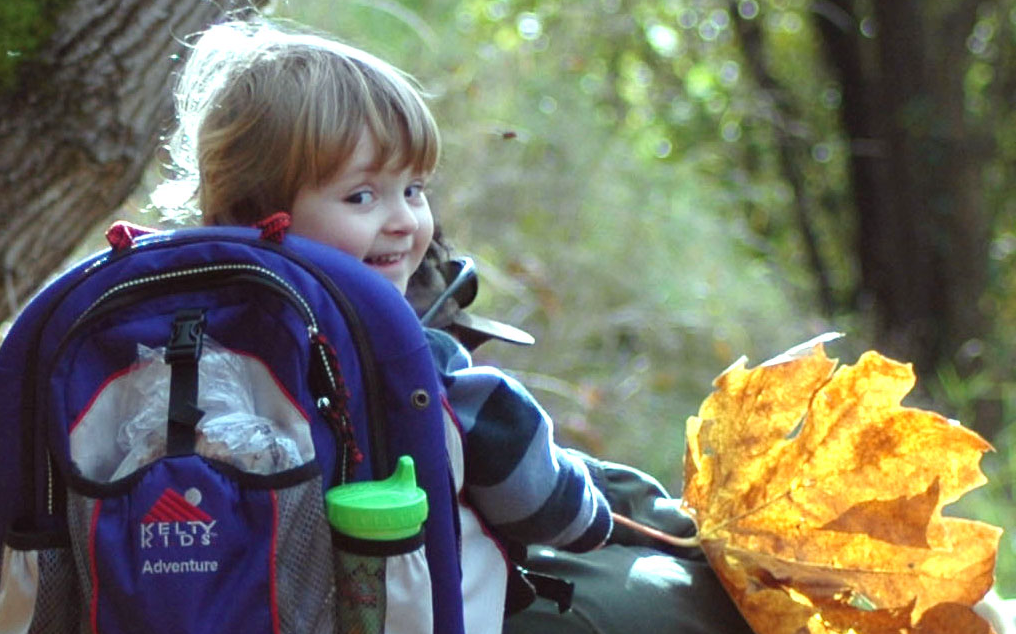
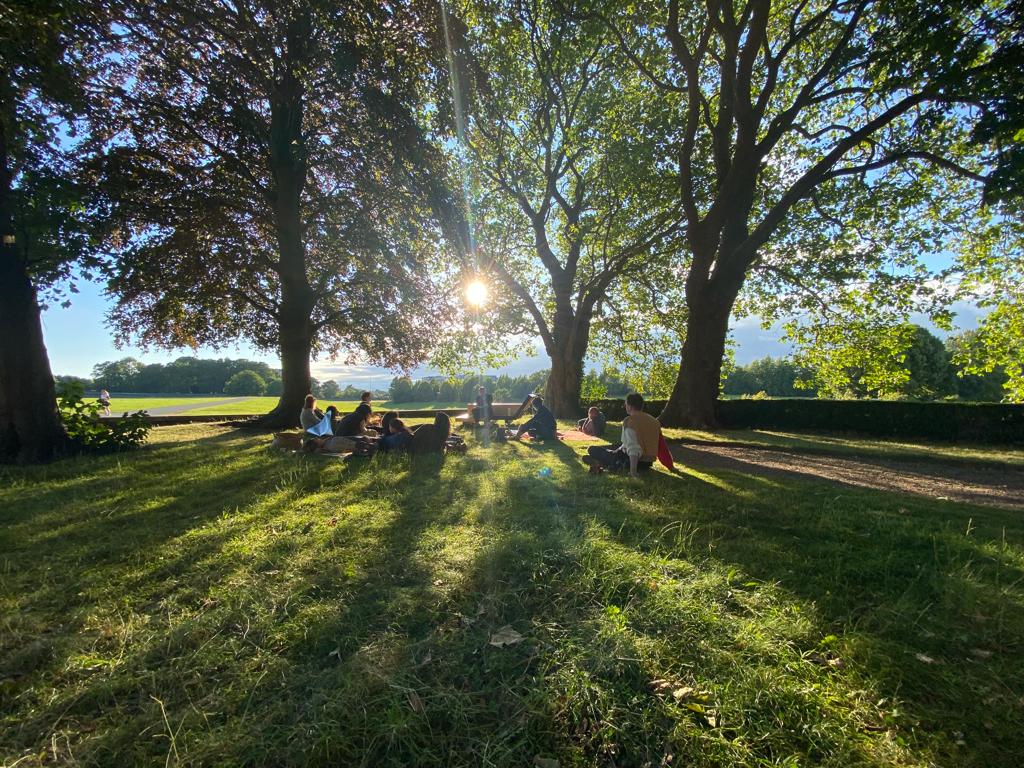

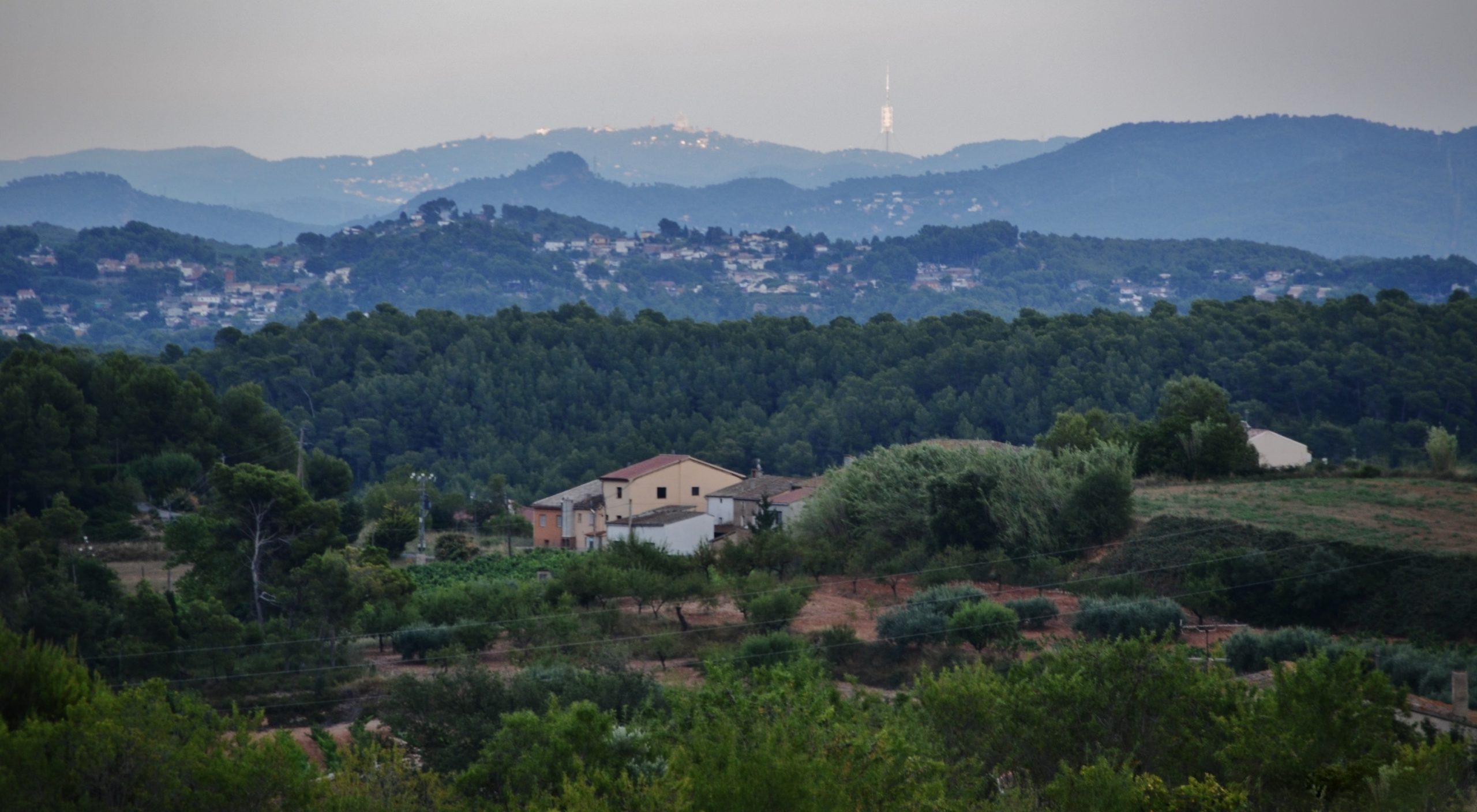
Leave a Reply